
WORCESTER VASE.
From the Collection of the late Lady Charlotte Schreiber in the Victoria and Albert Museum.
Reproduced by permission of the Board of Education.
The Project Gutenberg EBook of Chats on English China, by Arthur Hayden This eBook is for the use of anyone anywhere at no cost and with almost no restrictions whatsoever. You may copy it, give it away or re-use it under the terms of the Project Gutenberg License included with this eBook or online at www.gutenberg.org/license Title: Chats on English China Author: Arthur Hayden Release Date: May 9, 2018 [EBook #57124] Language: English Character set encoding: UTF-8 *** START OF THIS PROJECT GUTENBERG EBOOK CHATS ON ENGLISH CHINA *** Produced by Susan Skinner and the Online Distributed Proofreading Team at http://www.pgdp.net
COMPANION VOLUME BY THE SAME AUTHOR
CHATS ON
ENGLISH EARTHENWARE
With Coloured Frontispiece and 150 Illustrations and Tables of over 200 Illustrated Marks.
CONTENTS
| CHAPTER | |
| I. | How to Collect: A Chapter for Beginners |
| II. | Early Ware |
| III. | English Delft |
| IV. | Stoneware |
| V. | Early Staffordshire Ware—Thomas Whieldon: His Contemporaries and Successors |
| VI. | Salt-glazed Ware, Staffordshire |
| VII. | Josiah Wedgwood |
| VIII. | The School of Wedgwood |
| IX. | Leeds and other Factories |
| X. | Transfer-printed Ware |
| XI. | Staffordshire Figures |
| XII. | Swansea and other Factories |
| XIII. | Lustre Ware |
| XIV. | Late Staffordshire Ware |
| Index |
CHATS ON
ENGLISH CHINA
BOOKS FOR COLLECTORS
With Frontispieces and many Illustrations.
CHATS ON ENGLISH CHINA.
By Arthur Hayden.
CHATS ON OLD FURNITURE.
By Arthur Hayden.
CHATS ON OLD PRINTS.
(How to collect and value Old Engravings.)
By Arthur Hayden.
CHATS ON COSTUME.
By G. Woolliscroft Rhead.
CHATS ON OLD LACE AND NEEDLEWORK.
By E. L. Lowes.
CHATS ON ORIENTAL CHINA.
By J. F. Blacker.
CHATS ON OLD MINIATURES.
By J. J. Foster, F.S.A.
CHATS ON ENGLISH EARTHENWARE.
(Companion volume to “Chats on English China.”)
By Arthur Hayden.
CHATS ON AUTOGRAPHS.
By A. M. Broadley.
CHATS ON PEWTER.
By H. J. L. J. Massé, M.A.
CHATS ON POSTAGE STAMPS.
By Fred. J. Melville.
CHATS ON OLD JEWELLERY AND TRINKETS
By MacIver Percival.
CHATS ON COTTAGE AND FARMHOUSE FURNITURE.
(Companion volume to “Chats on Old Furniture.”)
By Arthur Hayden.
CHATS ON OLD COINS
By Fred. W. Burgess.
CHATS ON OLD COPPER AND BRASS.
By Fred. W. Burgess.
CHATS ON HOUSEHOLD CURIOS.
By Fred. W. Burgess.
CHATS ON OLD SILVER.
By Arthur Hayden.
CHATS ON JAPANESE PRINTS.
By Arthur Davison Ficke.
CHATS ON MILITARY CURIOS.
By Stanley C. Johnson.
CHATS ON OLD CLOCKS AND WATCHES.
By Arthur Hayden.
CHATS ON ROYAL COPENHAGEN PORCELAIN.
By Arthur Hayden.
CHATS ON OLD SHEFFIELD PLATE.
(Companion volume to “Chats on Old Silver.”)
By Arthur Hayden.
BYE PATHS OF CURIO COLLECTING.
By Arthur Hayden.
With Frontispiece and 72 Full page Illustrations. 21s. net.
LONDON: T. FISHER UNWIN, LTD.
NEW YORK: F. A. STOKES COMPANY.

WORCESTER VASE.
From the Collection of the late Lady Charlotte Schreiber in the Victoria and Albert Museum.
Reproduced by permission of the Board of Education.
Chats on
English China
BY
ARTHUR HAYDEN
AUTHOR OF “CHATS ON ENGLISH EARTHENWARE,”
“CHATS ON OLD SILVER,” ETC.

Bloor Derby Teapot
WITH 150 ILLUSTRATIONS
T. FISHER UNWIN LTD
LONDON: ADELPHI TERRACE
| First Edition | 1904 |
| Second Edition | 1906 |
| Third Impression | 1907 |
| Third Edition | 1909 |
| Fifth Impression | 1910 |
| Sixth Impression | 1912 |
| Seventh Impression | 1917 |
| Eighth Impression | 1919 |
| Fourth Edition | 1920 |
(All rights reserved)
TO
JOSEPHINE HAMILTON
A certain amount of necessary revision has been given to the volume.
The prices obtained at public auction for representative examples have been brought up to date, and ten new illustrations have been added.
ARTHUR HAYDEN.
September, 1920.
This edition has been slightly revised and corrected. Throughout the volume many new illustrations appear in place of those in the first edition, and their selection has been made in order to show more clearly the characteristics of the china as dealt with in the letterpress.
In addition to these, twenty new illustrations have been added, and I have to acknowledge my indebtedness to Messrs. Wedgwood & Sons, by whose courtesy I am enabled to reproduce examples from their museum at Etruria, and fine examples after Flaxman, including specimens of dinner-ware which are now being manufactured by the firm from the old designs by that artist.
I have similarly to acknowledge my obligation to Messrs. W. T. Copeland & Sons, of Stoke-upon-Trent (the successors of Spode), for several illustrations of the ware from their factory, and to Messrs. Minton for some fine specimens of their productions.
It is my hope that this improvement will make the volume more useful as a practical working handbook for the collector.
To the great number of enthusiasts who have written to me in connection with this volume and with the Dilettante pages in the Lady’s Pictorial, I tender a grateful and appreciative acknowledgment.
ARTHUR HAYDEN.
March, 1906.
AUTHOR’S NOTE
In regard to English Earthenware, which appeals to a wide circle of collectors, I have, in response to many readers who have written to me on the subject, prepared a companion volume to this, entitled “Chats on English Earthenware.” The subject is treated from a collecting point of view, and a large number of carefully selected photographic reproductions of typical examples illustrate the letterpress.
Those who are interested in the outline sketch of English Earthenware given in the concluding chapters of this volume, and desire greater detail, will find a completer record in the companion volume.
A. H.
January, 1909.

BOW TEAPOT.
With leaf as spout, and grape-vine handle.
This little volume has been primarily written with a view to enable the possessors of old china to determine the factories at which their ware was produced. A modest attempt has been made to show that the china-shelf is a record of men’s triumphs and failures, and the fantastic shepherds and shepherdesses, lustrous bowls, queer printed dishes, and bizarre decorated jugs, may be regarded by a reflective mind as so many symbols representing something less perishable than the clay of the potter.
These “Chats” originally appeared in the pages of Our Home. In collecting them in volume form I trust that they will appeal to a wider circle of readers.
Never was a greater interest taken in Art, and the growth of popular literature has developed a taste for objects of art in the home. The china-shelf is now regarded as worthy of keen and discriminating study. Its treasures, often heirlooms, have been brought into the light of day, and amateur collectors can now be numbered by thousands.
I am enabled to include a useful feature in the list of prices obtained at recent sales, by kind permission of the proprietors of the Connoisseur, whose “Sale Prices,” published monthly, is most valuable to the collector.
It is hoped that the Bibliography of works on china and pottery may be of use to those who wish to study the subject more deeply, and a copious Index will prove useful for ready reference.
The “Chats” relating to Lustre Ware, Old English Mugs, and Wedgwood are not upon English china, but deal with earthenware; they are included in the volume in order to increase its scope and usefulness.
My thanks are due to Mr. W. G. Honey, of Cork, for kindly allowing me to reproduce specimens from his collection which was exhibited at the Cork Exhibition. I am indebted to Mr. A. Merrington Smith, Fine Art Dealer, of Lowestoft, for information concerning the recent unearthing of moulds and fragments of china on the site of the old factory at Lowestoft, a discovery of very great value. By permission of the Coalport Company I am giving specimens of their modern productions and some of their marks not published before.
ARTHUR HAYDEN.
| PAGE | ||
| PREFACE | xi | |
| LIST OF ILLUSTRATIONS | xv | |
| BIBLIOGRAPHY | xxi | |
| GLOSSARY OF TERMS USED | xxiii | |
| CHAT | ||
| I. | OLD DERBY | 1 |
| II. | CHELSEA CHINA | 27 |
| III. | THE BOW CHINA FACTORY | 49 |
| IV. | OLD WORCESTER | 67 |
| V. | PLYMOUTH AND BRISTOL CHINA | 91 |
| VI. | THE LOWESTOFT FACTORY | 111 |
| VII. | COALPORT | 133{xiv} |
| VIII. | SPODE AND HIS SUCCESSORS | 149 |
| IX. | NANTGARW AND SWANSEA | 163 |
| X. | MINTON | 179 |
| XI. | OLD ENGLISH EARTHENWARE | 191 |
| XII. | LUSTRE WARE | 219 |
| XIII. | LIVERPOOL WARE | 235 |
| XIV. | WEDGWOOD | 247 |
| INDEX | 279 | |
| Frontispiece. | ||||||
| Worcester Vase. From the Collection of the late Lady Charlotte Schreiber in the Victoria and Albert Museum. | ||||||
| Chat I.—Old Derby. | ||||||
| PAGE | ||||||
| Bloor Derby Teapot | v | |||||
| Early Crown Derby Cup and Saucer | 3 | |||||
| Old Derby Marks | 7 | |||||
| Derby Figure Group | 9 | |||||
| Crown Derby Pastille-burner | 11 | |||||
| Crown Derby Mug and Saucer | 13 | |||||
| Bloor Derby Marks | 16 | |||||
| Crown Derby Vase and Bloor Derby Pastille-burner | 17 | |||||
| Later Derby Marks | 20 | |||||
| Chat II.—Chelsea China. | ||||||
| Chelsea Figure | 27 | |||||
| Figure of Carpenter | 29 | |||||
| Chelsea Vase in British Museum | 31 | |||||
| Chelsea Marks | 34 | |||||
| Chelsea Marks | 35 | |||||
| “Foundling” Vase | 38 | |||||
| Derby-Chelsea Marks | 39{xvi} | |||||
| Chat III.—The Bow China Factory. | ||||||
| Bow Vase, with Cover | Facing page 48 | |||||
| Bow Inkstand | 49 | |||||
| Bow Figure | 50 | |||||
| Bow Marks | 53, 54 | |||||
| Bow Plate and Teapot | 56 | |||||
| Bow Cups | 57 | |||||
| Bow Marks | 60 | |||||
| Chat IV.—Old Worcester. | ||||||
| Early Blue and White Worcester Plate | Facing page 66 | |||||
| Old Worcester Transfer-printed Group | 67 | |||||
| Old Worcester Marks | 70 | |||||
| Old Worcester, King of Prussia Mug | 73 | |||||
| Worcester Dish | 77 | |||||
| Flight and Barr Marks | 78 | |||||
| Chamberlain Marks | 78 | |||||
| Kerr and Binns Marks | 79 | |||||
| Grainger, Lee and Co. Marks | 79 | |||||
| Scent-bottle (Chamberlain) | 80 | |||||
| Grainger, Lee and Co. Vases | 81 | |||||
| Chat V.—Plymouth and Bristol China. | ||||||
| White Porcelain Goat | Facing page 90 | |||||
| Salt-cellar, Plymouth | 91 | |||||
| White Porcelain Dish, Plymouth | 94 | |||||
| Vase, Plymouth | 95 | |||||
| Plymouth Marks | 96 | |||||
| Bristol Porcelain | 97 | |||||
| Bristol Vase and Cover | Facing page 98 | |||||
| Bristol Marks | 100 | |||||
| Bristol Cup and Saucer from Edmund Burke’s Service | 102 | |||||
| Bristol Vase | 103{xvii} | |||||
| Chat VI.—The Lowestoft Factory. | ||||||
| Lowestoft, Panels of Dish (detail) | 111 | |||||
| Lowestoft Sauce-boats, with Fragment of Mould | 113 | |||||
| Blue and White Delft Marriage Plate | 114 | |||||
| Old Lowestoft Cups and Saucers | 117 | |||||
| Dated Lowestoft Mug | 118 | |||||
| Interior of Old Lowestoft Factory (Digging for Moulds) | 122 | |||||
| Toy Teapot and Cream Jug | 123 | |||||
| Dated Lowestoft Mugs and Jug | 125 | |||||
| Lowestoft Blue and White Jug | 128 | |||||
| Inkstand | 129 | |||||
| Chat VII.—Coalport. | ||||||
| Two-handled Cup, richly gilded | 133 | |||||
| Old Coalport—Covered Cup and Saucer | 135 | |||||
| Caughley, Old Blue Mug | 137 | |||||
| Early Marks | 139 | |||||
| Coalport Vase | 141 | |||||
| Coalport Marks | 142 | |||||
| Latest ditto | 143 | |||||
| Old Coalport Vase | 145 | |||||
| Chat VIII.—Spode and his Successors. | ||||||
| Copeland Vases | 149 | |||||
| Spode Plates | 151 | |||||
| Spode Pastille-burner | 152 | |||||
| Spode Marks | 154 | |||||
| Spode Plate | 155 | |||||
| Copeland Marks | 156 | |||||
| Copeland Plates | 157 | |||||
| Chat IX.—Nantgarw and Swansea. | ||||||
| Swansea Vase | 163 | |||||
| Nantgarw Plates | 165 | |||||
| Nantgarw Dish | 167{xviii} | |||||
| Fine Swansea Vase and Cover | Facing page 170 | |||||
| Swansea Marks | 171 | |||||
| Swansea Plate | 172 | |||||
| Swansea Vase (Dillwyn’s Etruscan Ware) | 173 | |||||
| Chat X.—Minton. | ||||||
| Minton Vase | Facing page 178 | |||||
| Minton Dish | 181 | |||||
| Minton Marks | 182 | |||||
| Minton Vase | 183 | |||||
| Later Minton Marks | 184 | |||||
| Lion Ewer (Henri II. Ware) | 185 | |||||
| Minton Candelabrum | 186 | |||||
| Majolica Plaque | 189 | |||||
| Chat XI.—Old English Earthenware. | ||||||
| Bust of Prince Rupert | 191 | |||||
| Sunderland Jug | 193 | |||||
| Old Jug—John Bull | 198 | |||||
| The Vicar and Moses | 199 | |||||
| Sunderland Frog Mug | 203 | |||||
| Old Delft Mug (dated 1631) | 206 | |||||
| Group of Old English dated Ware | 209 | |||||
| Old Puzzle Jug | 212 | |||||
| Marks on Mason’s Ware | 216 | |||||
| Group of Mason’s Jugs | 217 | |||||
| Chat XII.—Lustre Ware. | ||||||
| Silver Lustre Jug | 219 | |||||
| Copper Lustre Jugs | 221 | |||||
| Group of Copper Lustre Ware | 222 | |||||
| Copper Lustre Bust | 223 | |||||
| Copper Lustre Jugs | 225{xix} | |||||
| Copper Lustre Jug | 226 | |||||
| Silver Lustre Sugar-bowl | 227 | |||||
| Silver Lustre Jugs | 228 | |||||
| Silver Lustre Teapot | 229 | |||||
| Silver Lustre Jug (White Decoration) | 231 | |||||
| Gold Lustre Jug | 232 | |||||
| Chat XIII.—Liverpool Ware. | ||||||
| Liverpool Delft Punch Bowl | 235 | |||||
| Old Liverpool Tiles | 237 | |||||
| Early Liverpool Marks | 240 | |||||
| Liverpool Marks | 241 | |||||
| Old Liverpool Mug | 243 | |||||
| Old Liverpool Jug (two positions) | 244 | |||||
| Liverpool Mug | 245 | |||||
| Chat XIV.—Wedgwood. | ||||||
| Wedgwood Dinner Plates | 247 | |||||
| Wedgwood. Jasper Cup and Saucer | 249 | |||||
| Whieldon Tortoiseshell Ware | 251 | |||||
| Wedgwood Terra-cotta Vases | 256 | |||||
| Wedgwood. Jasper Vase | 258 | |||||
| Blue Jasper Vase and Pedestal | 259 | |||||
| Plaque designed by Flaxman. Mercury uniting the hands of England and France | 260 | |||||
| Portland Vase | 261 | |||||
| Wedgwood and Bentley Mark | 269 | |||||
| Old Wedgwood Teapot | 271 | |||||
| Wedgwood Plaque. Designed by Lady Diana Beauclerk | Facing page 278 | |||||
| Additional Plates in Third Edition. | ||||||
| Bow Teapot | page xi | |||||
| Derby Figure of Peacock | Facing | page | 20 | |||
| Chelsea Figures of Birds | ” | ” | 34{xx} | |||
| Chelsea Figure and Candlestick | Facing page 40 | |||||
| Pair of Bow Figures | ” | ” | 54 | |||
| Bow Cups | ” | ” | 60 | |||
| Worcester Plate | ” | ” | 68 | |||
| Pair of Worcester Vases | ” | ” | 70 | |||
| Rare Lowestoft Coffee-Pot | ” | ” | 120 | |||
| Additional Plates in Fourth Edition. 1920. | ||||||
| Derby Cups and Saucers | Facing page 22 | |||||
| Chelsea Dishes | ” | ” | 36 | |||
| Chelsea. Pair of Groups, Dancing Figures | ” | ” | 42 | |||
| Bow. Figure of Britannia | ” | ” | 52 | |||
| Bow Teapot, Chinese Style, and Plate | page 56 | |||||
| Worcester Teapot | Facing page 68 | |||||
| Worcester Mug, Transfer printed | ” | ” | 76 | |||
| Lowestoft Jug (1772), Mug (1792) | page 125 | |||||
General.—Catalogue of Specimens of British Pottery and Porcelain in the Museum of Practical Geology. 1876. (Out of print.)
(This Collection is now at the Bethnal Green Museum.)
Marks and Monograms on Pottery and Porcelain. William Chaffers.
(The last edition, 1901, contains over 3,500 Potters’ marks of all the well-known European and Oriental factories.)
Ceramic Art of Great Britain. 2 vols. Llewellyn Jewitt. 1878.
The China Collector’s Pocket Companion. Mrs. Bury Palliser.
(Containing marks only—arranged in order.)
Old English Pottery. Mr. and Mrs. Frank Freeth. (Morgan, Thompson, & Jamison.)
English Porcelain. A. H. Church. 1904.
English Earthenware. A. H. Church. 1884.
Art of the Old English Potter. By M. L. Solon.
History of Old English Porcelain. By M. L. Solon. 1903.
History and Description of English Porcelain. By Wm. Burton. Cassell & Co. 1902.
History and Description of English Pottery. By Wm. Burton. 1906.
Examples of Early English Pottery. John Eliot Hodgkin, F.S.A., and Edith Hodgkin. 1891.
Pre-Wedgwood English Pottery (Solon Collection). Connoisseur, December, 1901; February, 1902.
Pottery and Porcelain, A Guide to Collectors. F. Litchfield. 1900.
Catalogue of English Porcelain at British Museum. R. L. Hobson. 1905.
Guide to English Pottery and Porcelain at British Museum. R. L. Hobson. 1910.
Catalogue of Schreiber Collection at Victoria and Albert Museum. B. Rackham. 1915.
Particular. Bow, Chelsea, and Derby Porcelain. William Bemrose. 1898.
Bristol, Two Centuries of Ceramic Art in. Hugh Owen. 1873.
Chelsea China. Connoisseur, March, 1903.
Bow Porcelain. Burlington Magazine, vol. xxv., 1914.
Bristol Porcelain. Burlington Magazine, vol. xx., 1912.
Old Derby China Factory. John Haslem. 1876.
Liverpool, The Art of Pottery in. Joseph Mayer. 1855.
Liverpool Catalogue of Pottery and Porcelain. P. Entwistle. 1907.
The Liverpool Potters. C. T. Gatty. 1882.
Lowestoft. Connoisseur, April, 1903; October, 1903. Queen, Christmas number, 1903. Lady’s Pictorial, Dec. 30, 1905.
Lowestoft China. By W. W. R. Spelman. (Jarrold, Norwich.) 1906.
Lustre Ware. Connoisseur, November, 1902.
Saltglaze Teapots, Old English. Connoisseur, February, 1903.
Staffordshire Potteries, History of the. S. Shaw. 1829.
Swansea and Nantgarw, The Ceramics of. William Turner. 1897.
Toby Jugs and their Near Relatives. Lady’s Pictorial, Jan., 1906.
Transfer Printing on Pottery. Burlington Magazine, vol. vi., 1904-5.
Wedgwood, Life of Josiah. Miss Meteyard. 1865.
—— Memorials of Miss Meteyard. 1874.
—— Connoisseur, May, 1903.
—— A. H. Church. (Portfolio Monograph.)
Worcester China. A Century of Potting in the City of Worcester. R. W. Binns. 1877.
Worcester China. A Record of the Work of Forty-five Years (1852-1897). R. W. Binns. 1898.
Old Worcester. Connoisseur, October, 1902.
Worcester Porcelain. R. L. Hobson. 1910.
Biscuit.—The first stage of china after being fired. It is white and porous, and ready for decoration. Its surface resembles that of an ordinary clay pipe.
China.—A term used to include all porcelains.
Earthenware.—All ware that, in contradistinction to porcelain, is not translucent.
Glaze.—The glassy substance applied to the surface of pottery and porcelain.
Lead Glaze.—The porcelains of Bow, Chelsea, and other early factories contained as much as 40 per cent. of oxide of lead. Modern chinas contain less than half that, and some glazes are “leadless.” As to the terrible results of the use of this glaze on the health of the potters, see Report of Professors Thorpe and Oliver to Home Office on subject (C. 9207, 1899).
Over-Glaze Decoration.—Decoration after the surface has received its transparent glaze. This decoration admits of a wider range of colours. On hard paste, such as Plymouth, it stands flat on the surface; on soft paste, such as Bow, it is partly incorporated.
Under-Glaze Decoration.—Decoration applied to the unglazed surface when in biscuit state; the whole is then covered with transparent glaze and refired.
Ironstone China.—A term invented by Mason, who took out a patent for his ware. It is not china, but is a heavy class of earthenware highly decorated. It was generally adopted by other Staffordshire makers.
Moulds.—The models from which china is made. These are of plaster of Paris.
Opaque.—Incapable of transmitting light. This distinguishes pottery from porcelain.
Paste.—The body or material of which porcelain is made.
Hard.—China which, on being broken, shows a sparkling surface like that of a flint stone, and is impervious to any staining by colour applied to it. Plymouth and Bristol and New Hall are the only true hard-paste porcelains of this country.
Soft.—China which, on being broken, shows a porous surface capable of absorbing colour.
Porcelain.—Commonly called china; is distinguished from pottery by being translucent.
True Porcelain is made from a mixture of two minerals—petuntse, or “china stone,” and kaolin, or “china clay,” with nothing artificially added; e.g., Chinese, Dresden, Plymouth, and Bristol chinas.
Glassy Porcelain, containing an artificial admixture of glass to give the paste translucency; e.g., Chelsea, Bow, Nantgarw, Pinxton.
Bone-ash Porcelain, of which Spode’s china is an example.
Pottery.—A term used to include all the earthenwares.
Printing.—Formerly, in old chinas, all the coloured decorations were painted. Now, by use of various mechanical devices, women and girls are employed to transfer printed patterns on modern china.
Transfer-printing.—A process used at Liverpool by Sadler and Green, and at Worcester, in which the design from an engraved copper plate was transferred to specially prepared paper and applied to the ware. Black and brown were the main colours used (see Illustrations, pp. 244-5 and facing p. 76).
Translucent.—Transparent. All porcelains, when held up to a strong light, are translucent, in varying degree, according to thickness of paste.
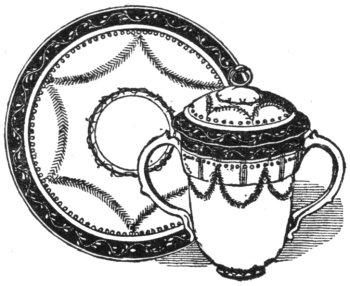
EARLY CROWN DERBY CUP AND SAUCER.
In Victoria and Albert Museum.
CHATS ON ENGLISH CHINA
I
OLD DERBY
It is not too much to hope that the eyes of some reader will stray into these pages as a wanderer in a strange land, one whose interest in china has never been awakened. We hope to lure such a wight with sweet cajolery. If perchance we can get him to examine one or two dainty specimens of old blue china we shall have him enmeshed in our toils. If he be an artist he will not escape from the enchantment of Derby and of Worcester. If he be a mere{4} business man, here is an item from Messrs. Christie’s catalogue of a sale on January 14, 1902: “Coffee-pot and cover, Worcester. Painted with figures, birds, and flowers, in colours in Chinese taste, and with alternate dark-blue scale-pattern panels—£28 7s.” And this, mark you, is an ordinary item selected at random, a business sample, if you will.
Mr. Andrew Lang, in one of his “Ballades in Blue China,” has cunningly put into rhyme a poet’s reason for his love of china:—
We should be less than human if we did not point the moral by quoting the delicious sentences of a City man (one can hardly imagine Charles Lamb a City man journeying daily to Leadenhall Street!) concerning—
“Those little, lawless, azure-tinctured grotesques that, under the notion of men and women, float about, uncircumscribed by any element, in that world before perspective—a china teacup.... Here is a young and courtly mandarin handing tea to a lady from a salver—two miles off. See how distance seems to set off respect. And here the same lady,{5} or another—for likeness is identity on teacups—is stepping into a little fairy boat, moored on the hither side of this calm garden river, with a dainty, mincing foot, which, in a right angle of incidence (as angles go in our world), must infallibly land her in the midst of a flowery mead—a furlong off on the other side of the same strange stream!”
And now, having brought you thus far, reader, will you not journey with us and learn something of the magic and the mysteries of old china? We are a goodly company, and if you have a fine eye, a pretty fancy for your own taste, and a keen zest for a bargain, join hands with us.
Derby holds a high place in the history of British porcelain, inasmuch as it was here that its manufacture was matured, and the ability and perseverance of three generations of the Duesbury family raised the productions to the level of those of the great European factories.
It is generally believed that the manufacture of china first sprang into existence at Derby in 1750, about a year or so before the works at Worcester were established. There is a tradition that the first maker was a Frenchman, who lived in a small house in Lodge Lane, and who modelled and made small articles in china, principally animals—cats, dogs, lambs, sheep, &c.—which he fired in a pipemaker’s oven in the neighbourhood.
About this time there were some pot works on Cockpit Hill belonging to Alderman Heath, a banker, and the productions of the Frenchman,{6} probably a refugee, having attracted notice, an arrangement was made between him and Heath and Duesbury by which the manufacture of porcelain would be carried on jointly. This man’s name, to whom the absolute honour of commencing the Derby China Works belongs, was Andrew Planché. A deed exists by which a partnership for ten years was entered into by the three above named. Planché found the skill and secret knowledge, Heath the money (£1,000), and Duesbury the ability to carry out the scheme.
Besides this deed there is no other record of the Frenchman, as the firm became known as “Duesbury and Heath,” and apparently the usual fate of the poor inventor overtook Planché.
William Duesbury was of Longton Hall, in Staffordshire, and was the son of a currier. By trade he was an enameller. Entries in the family Bible, in the possession of the Duesburys, prove that in 1755 he removed to Derby to carry on the newly-acquired business “in ye art of making English china, as also in buying and selling all sorts of wares belonging to ye art of making china.”
Records of the kinds of china manufactured and sent to London are interesting. There were blue fluted boats, mosaic boats, sage-leaf boats, fig-leaf sauce-boats, octagon fruit plates, vine-leaf plates, coffee cups, flower vases, blue strawberry pots, standing sheep, cats, honeycomb jars, coffee-pots, butter-tubs, Chelsea jars, teapots, figures of Mars, Minerva, &c., Spanish shepherds, candlesticks, and, of course, many varieties of plates and dishes, and cups and saucers.
Once or twice the name of the firm appears as “Duesbury and Co.,” but it is more usually “Duesbury and Heath.” Finally, it became Duesbury only.

1750.
Earliest Mark
(In gold).
Under Royal Patronage.
1773.
Marked in blue.
1782-1830.
Early—marked in puce.
Later—blue, red, green, & black.
OLD DERBY MARKS.
Coming to the marks which were used, in our illustration we have arranged them in chronological order, the earliest being at the top.
The mark used in the earliest days is not certain,{8} but in all probability the letter D, when in gold, is one of the first used. It is, however, exceedingly rare to find a piece thus marked. This letter D may equally stand for Derby or for Duesbury.
From 1770 to 1773, the script initial
![]() and the
anchor known as the Derby-Chelsea or the Duesbury-Chelsea
mark was introduced, as William Duesbury
had purchased “the Chelsea Porcelain Manufactory,
and its appurtenances and lease thereof,” on
February 5, 1770, and made this addition to the
Chelsea anchor. This mark of the Derby-Chelsea
period is usually in gold, and was used both at the
factory at Chelsea and at Derby. Examples of
this period are of comparative rarity, and are eagerly
sought after by collectors.
and the
anchor known as the Derby-Chelsea or the Duesbury-Chelsea
mark was introduced, as William Duesbury
had purchased “the Chelsea Porcelain Manufactory,
and its appurtenances and lease thereof,” on
February 5, 1770, and made this addition to the
Chelsea anchor. This mark of the Derby-Chelsea
period is usually in gold, and was used both at the
factory at Chelsea and at Derby. Examples of
this period are of comparative rarity, and are eagerly
sought after by collectors.
The Derby-Chelsea marks are given in the “Chat” on Chelsea (p. 39).
The works at Chelsea were not finally discontinued
till 1784, when they were destroyed by Duesbury,
the kilns and every part of the factory pulled down,
and what was available sent off to Derby. About
the year 1773, a ![]() and a crown were used. This
mark is mostly in blue, but sometimes in puce, light
red, or green. This crown was added by Royal
permission, because the factory had been honoured
by Royal patronage.
and a crown were used. This
mark is mostly in blue, but sometimes in puce, light
red, or green. This crown was added by Royal
permission, because the factory had been honoured
by Royal patronage.
Will my readers note that in the earlier pieces of Derby and Crown-Derby china the crown is carefully jewelled; in the later productions of the Duesbury period the mark was rudely executed, and the crown was hastily pencilled.
Of the introduction of the cross daggers and six{11} spots, about the year 1782, there is the tradition that it was a defiance to all manufactories except three, viz., those of Sèvres, Dresden, and Berlin.
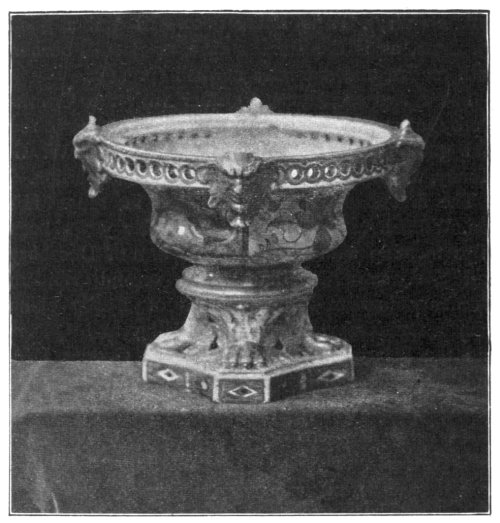
CROWN DERBY PASTILLE-BURNER (4 IN. HIGH).
In the Collection of the Author.
We give as a headpiece a typical example of early Crown-Derby. It represents a two-handled covered cup and saucer decorated with the well-known rich blue and gold border and festoons in pink. It is marked in puce with jewelled crown.{12} This specimen is from the national collection now at the Bethnal Green Museum.
The vase we reproduce is 61⁄2 in. high and has the crown and crossed batons and dots, which mark has been photographed and appears in the illustration (p. 17). It is richly decorated and a good specimen, as is the smaller vase, or pastille-burner, with masks, and similarly marked (p. 11).
These two specimens, together with the Crown-Derby mug and saucer, decorated in tomato red and gold, are from the collection of Mr. W. G. Honey, which was on view at the Cork Exhibition.
The first William Duesbury died in 1785. His son, William, who had for the last few years been in partnership with him under the firm of Duesbury and Son, succeeded him. This second William Duesbury increased the fortunes of Derby china with astonishing rapidity. The King and Queen, and the Prince of Wales (afterwards George IV.), and the leaders of fashionable society were among his customers. There was a craze for a time, and titled ladies painted flowers and other pictures on the porcelain supplied to them by the Derby factory. It was afterwards fired and finished for their own special use.
Of these ladies, Lady Margaret Fordyce, Lady Plymouth, and Lady Aubrey executed some beautiful drawings, which probably still remain in their families. Lord Lonsdale had twenty-four plates painted with landscapes in Cumberland after his own sketches, and many other noblemen and gentlemen did the same.
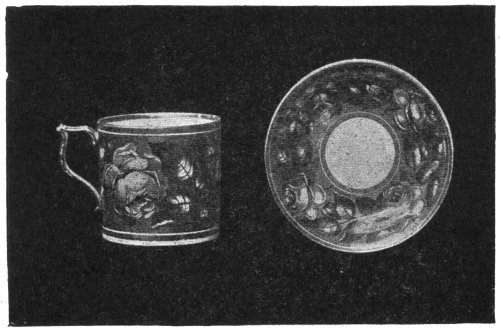
W. G. Honey.]
[Cork.
CROWN DERBY MUG AND SAUCER.
(Tomato red and heavy gold decoration.)
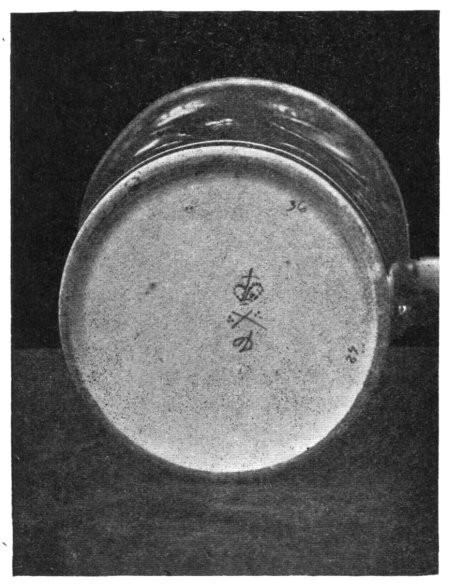
MARK ON ABOVE MUG (IN RED).
On the death of Duesbury the second, his widow married his late partner, a Mr. Michael Kean, an Irishman, and clever artist. This was in 1798. But Kean hastily withdrew from the concern when the third William Duesbury came of age, who for a time carried on the factory under the firm of “Duesbury and Sheffield.” In 1815 the premises passed into the hands of Mr. Robert Bloor.
It was in the year of Waterloo that the third William Duesbury, and last of the great family of potters who had established the factory, leased the premises to Mr. Robert Bloor, who had been a clerk to his father, and had carried on the business during Mr. Duesbury’s minority. Ultimately the entire business passed into the hands of Mr. Bloor, and the name of Duesbury disappears from Derby records.
For some years up till about 1825 or 1830, Mr. Bloor used the Old Derby mark, the crown, cross daggers with dots, and D beneath, but about that period he discontinued it, and adopted instead a mark with his own name. It is well for readers to note that down to the discontinuance of the old mark, it had invariably been done with a pencil, but those adopted by Mr. Bloor were printed.
In our illustrations of the other marks used at Derby we place them in chronological order. The first printed mark used under the Bloor régime was the circle enclosing the crown, and the words “Bloor, Derby,” printed around. In some specimens, of a little later date, the mark is a trifle larger, and the crown more carefully designed. Another mark used{16} occasionally about the year 1830 was the word “Derby” enclosed in a scroll; while on some other specimens of about the same date, or a little later an old English D, surmounted by a crown, is marked, or the word “Derby” in Roman capitals on a ribbon, appears beneath the usual crown.
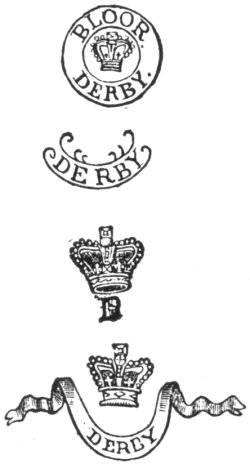
BLOOR DERBY MARKS.
We now come to a rather painful chapter in the history of the Old Derby, practically a series of misdoings, which terminated the glorious career of so famous a manufactory. It is interesting to see when trade, with its somewhat ruthless methods, comes into conflict with art, with her finer susceptibilities, how art has to go to the wall. It was the same story at Derby.

CROWN DERBY VASE.
With panels, and painted with floral design in colours.
(Height 61⁄2 ins.)
Mark illustrated showing Crown, crossed batons and dots and letter D.
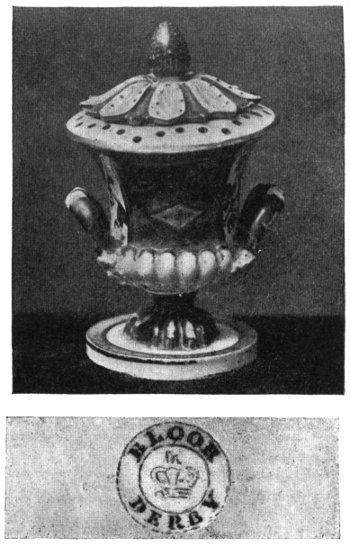
BLOOR-DERBY PASTILLE-BURNER.
Having perforated lid. Decorated in colours and richly gilded.
(Height 5 ins.)
With mark illustrated below.
Before Bloor’s time it had been the unvarying plan of the Duesburys—so particularly jealous were they of their reputation, and of maintaining the highest possible character of the Derby ware—to allow only perfect goods to leave the premises. However trivial the fault, the articles were not considered good enough to send out in the name of Derby. These damaged wares had accumulated to a very large{19} extent at the manufactory. Mr. Bloor, who was not a rich man, and who was filled with the very laudable desire to make the Derby concern successful, and who, moreover, had to pay off his purchase money by instalments, caught at the chance of disposing of this accumulation of Old Derby stock. Here it was that his trade instincts overcame his love of the fine arts. Better far had it been if the whole buildings had been consumed by fire, and the old stock destroyed, than that the damaged goods should have been foisted upon the public. But it fell about otherwise, and Mr. Bloor disposed of the Derby failures by auction at the different large towns. By this means he amassed great sums of money, which brought him immediate capital, but which was the death-blow to Derby ware. The old Derby was eagerly bought, but this temporary success resulted in permanent and never-to-be-remedied evil. Seeing how readily the public bought up the Derby ware, the temptation arose to produce large quantities of the ware specially for the auction rooms. The Duesburys would have risen in their graves had they known of these proceedings; but Fate avenged them, for the decline of the Derby factory commenced from this moment.
We give, also from Mr. W. G. Honey’s collection, a fine example of Bloor Derby china; it is five inches in height, and is marked with a crown and the words “Bloor, Derby,” in circle around (p. 17).
In 1845 Mr. Robert Bloor died, followed in the next year by his brother Joseph, who had assisted him for many years. For a little while the works{20} were in the hands of a Mr. Clarke, who finally discontinued them and sold most of the models to the Staffordshire manufacturers. The end came in 1848, when a number of the workmen left Derby for ever and migrated into Staffordshire and Worcester. Here, then, is the end of the Old Derby works.
Old Derby china will, therefore, be seen to be divided into two periods—the great Duesbury period and the declining period when Bloor became a factor.

LATER DERBY MARKS.
A word or two to readers who possess specimens of later Derby may be of interest. Among our marks will be seen several other names connected with Derby. In 1848, when the works were closed, a number of the old hands were actuated by the desire to continue the making of china at Derby They, therefore, under the name of Locker and Co., started a little manufactory, and adopted the design we give.
Mr. Locker died in 1859, and the
works were then carried on in the
name of Stevenson and Co. Finally
we have the name of Courtney, who appears to have
been one of Bloor’s agents. Messrs. Stevenson and
Hancock adopted the last mark for their wares, after{21}
persuasion by connoisseurs, who objected to the use
on modern Derby of the old mark of the crown,
cross daggers, and ![]() . The legacy which the Bloors
and some of the modern successors left to the name
of Derby is not a very happy one. The tampering
with the marks, or the bartering of modern as old, or
the disposal of damaged stock, all go to lessen the
faith of the public. As the years go on, the china
buyer becomes more discerning, and is not that
blind monster which manufacturers too often imagine
him to be.
. The legacy which the Bloors
and some of the modern successors left to the name
of Derby is not a very happy one. The tampering
with the marks, or the bartering of modern as old, or
the disposal of damaged stock, all go to lessen the
faith of the public. As the years go on, the china
buyer becomes more discerning, and is not that
blind monster which manufacturers too often imagine
him to be.
In the hurried sketch we have given of the decline of Old Derby we have little to say of the wonderful biscuit ware which was one of the secrets of Derby, which secret has now been lost. The biscuit figures produced in the best days of Derby are unsurpassed for fineness of modelling and beauty of finish. It was in experimenting to find how Derby produced this biscuit that Copeland discovered his celebrated Parian ware.
There is a peculiar pleasure to the lover of things old and things true in the unravelling of the complicated chain which environs an old factory such as Derby. The lives and ambitions of men, fathers, sons, and grandsons, are bound up with the traditions of the firm. Then trade had somewhat the air about it of the old mediæval guilds. There were secrets which no money could buy. All this lies on the china shelf for you to read, if you care to. Perhaps when your erring maid drops your Derby cup and saucer you will philosophically remember that it is not a cup and saucer, but only as the{22} autumn leaves that are strewn on the grave of Duesbury, the potter—just a symbol to remind you that man’s creations, after all, turn to dust and ashes. But all that is very mournful, and mayhap one shall find you later busy with fish-glue and brush, at which pastime you will need to be a philosopher too.
With a history such as that of Derby, general characteristics cannot be laid down, but certain typical patterns were made at Derby. A favourite pattern was the “French sprig” or “Chantilly,” technically termed “129 sprig” at the Derby works, being an imitation of the Angoulême china, painted with a forget-me-not or small blue cornflower, and a gold sprig laid on the white. This is of frequent occurrence on fluted cups. Deep blue borders with gold leafage and simple festoons in pink was a characteristic decoration of early Crown Derby. The “Japan” patterns of Derby during the last years of the eighteenth century and early years of the nineteenth, were profusely decorated with blue and red, and often richly gilded.
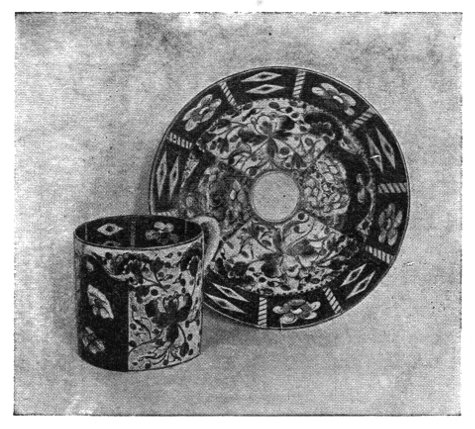
OLD DERBY CUP AND SAUCER.
Japan pattern.
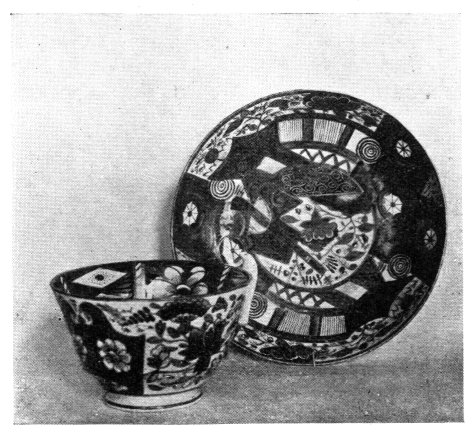
OLD DERBY CUP AND SAUCER.
Japan pattern.
| Crown Derby. | £ | s. | d. |
| Bowl, circular and pierced cover, gilt ram’s head handles, on tripod, decorated with flowers in Oriental taste on alternate red and green panels, 10 in. high. Christie, January 30, 1902 | 9 | 9 | 0 |
| Pastille-burners and covers, pair, gilt claw feet and with masks round the rims, painted with flowers in the Oriental taste and with dark blue and gold panels. Christie, January 30, 1902 | 7 | 17 | 6 |
| Figure, a girl with a basket of fruit carrying a bunch of grapes, 71⁄4 in. high. Christie, February 5, 1902 | 11 | 11 | 0 |
| Peacock, with flowers in relief, on plinth, decorated, 6 in. high. Foster, February 13, 1902 | 11 | 11 | 0 |
| Cup, cover and saucer, two-handled (from Nelson service). Debenham, Storr & Sons, April 14, 1902 | 7 | 0 | 0 |
| Vases, set of three, with beaker-shaped necks, painted with landscapes in panels on dark blue ground richly gilt with arabesque foliage, and with white and gold handles, 101⁄2 in. and 121/2 in high. Christie, April 6, 1903 | 30 | 9 | 0{24} |
| Figures, pair, shepherd and shepherdess. Sotheby, May 4, 1903 | 63 | 0 | 0 |
| Vases, pair, campana-shaped, with Satyr’s mask handles, painted with roses, poppies and other flowers in colours on a gold ground, 18 in. high. Christie, May 28, 1903 | 38 | 17 | 0 |
| Dessert service with centre with sprays and bouquets of flowers, painted by Billingsley. Two tureen covers and stands, seven dishes and twelve plates, marked. Sotheby, June 11, 1920 | 20 | 0 | 0 |
| Pair of figures of a boy and girl, with dog and goat, 61⁄4 in. high; and a Derby figure of Neptune, with a dolphin, 71⁄2 in. high. Christie, July 5, 1920 | 12 | 12 | 0 |
| Biscuit group, of Nymphs festooning a bust of a Satyr, 13 in. high. Christie, July 5, 1920 | 8 | 18 | 6 |
| Six Plates, painted with rosebuds in the centres. Christie, July 5, 1920 | 6 | 6 | 0 |
| Cylindrical mug, painted with a view, “On the River Trent,” in panel, and gilt with foliage, 5 in. high. Puttick & Simpson, July 16, 1920 | 3 | 13 | 6 |
| Bloor Derby. | |||
| Vases, pair, shaped, decorated in gold and painted continuous landscapes,{25} scroll handles and gilt mask terminals, 111⁄2 in. high (marked “Bloor, Derby”). Edwards, Son & Bigwood, Birmingham, May 13, 1902 | 9 | 19 | 6 |
| Dessert service, painted with flowers in the Oriental taste, in red, blue, and gold, by Bloor, consisting of centre-dish, on foot, sugar-tureen, cover and stand, and nine shaped dishes. Christie, July 21, 1902 | 65 | 2 | 0 |
| Vase, large, by Bloor, painted with a view of Temple Bar and a group of flowers, in two large panels, on dark blue and gold ground, 21 in. high. Christie, December 5, 1902 | 21 | 0 | 0 |
| Dessert service, painted with bouquets of flowers on white ground, and the borders gilt with vases and arabesques, consisting of an ice-pail, cover and liner, centre-dish on foot, eight dishes and six plates. Christie, July 5, 1920 | 17 | 17 | 0 |
| Set of three vases, painted with flowers in the Chinese taste in dark blue panels, gilt snake handles, 63⁄4 in. to 81⁄4 in. high. Puttick & Simpson, July 16, 1920 | 8 | 18 | 6 |
| Set of four vases of flowers, on scroll bases, with gilt paw feet, 63⁄4 in. high. Puttick & Simpson, July 16, 1920 | 12 | 12 | 0 |

CHELSEA FIGURE.
With candelabrum.
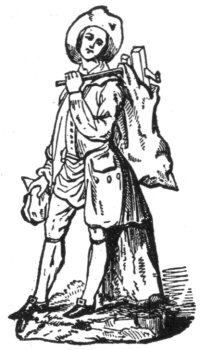
CHELSEA FIGURE OF CARPENTER WITH BAG OF TOOLS.
In Victoria and Albert Museum.
II
CHELSEA CHINA
The origin of Chelsea china is like that of the celebrated Charles James Harrington Fitzroy Yellowplush, “wropped in mystry.” The southwestern corner of London has always been connected with the making of pottery in some form or another. To-day Messrs. Doulton carry on the tradition of Lambeth and Vauxhall. Battersea was famed for its enamelled ware, and Fulham had a factory established by John Dwight, M.A., of Christ Church, Oxford, the inventor of porcelain in England, to whom a patent was granted in 1671 for his manufacture of porcelain and stone ware.
Tradition, with a light heart, circulated the fable that the origin of the Chelsea works was owing to the clay that was brought as ballast in ships from Chinese ports. In a “Life of Nollekens” this absurdity finds its way into print, but for all that it is utterly without foundation. “The cunning rogues produced very white and delicate ware, but then they had their clay from China, which, when the Chinese found out, they would not let the captains have any more for ballast, and the consequence was that the whole concern failed.”
Equally foolish and erroneous statements have been made about other of the English factories, and the difficulty of sifting real facts from a mass of chaff in such factories as Bow or Lowestoft is very great.
In the early days of Chelsea, and, by the way, the exact date of the establishment of the factory is not known, the clay was obtained from Cornwall. Dr. Martin Lister, in a work published in 1699, mentions the fact that an inferior kind of porcelain was made at Chelsea, probably little better than opaque glass. It is known that a manufactory of glass was set up at Chelsea by some Venetians under the auspices of the Duke of Buckingham. It is interesting to note that the Chelsea mark of an anchor is identical with that of Venice. In 1745 the works at Chelsea had attained a Continental fame, inasmuch as the French company, in petitioning for the establishment of a factory at Vincennes, urged that its aim was to counteract the importation of English and German ware.
1745 is a very convenient date, as we then come{33} on surer ground. The earliest dated example of English porcelain known has the word, “Chelsea, 1745,” scratched on it under the glaze, and is also marked with a triangle. We reproduce this mark in our list of Chelsea marks.
Life was given to the Chelsea factory by the patronage of George II., who did much to encourage its work. He procured workmen, models, and materials from Saxony and Brunswick, and thus enabled Chelsea to enter into competition with the best designs and productions of Dresden and Sèvres. The Duke of Cumberland took a warm interest in the factory, and contributed an annual sum to its revenue. In 1750 we find the Chelsea works in the hands of Nicholas Sprimont, a foreigner of considerable artistic taste, who established the reputation of Chelsea. The best period of Chelsea ware is from this date till the year 1765. Porcelain made between these two dates is always much sought after, and brings considerable sums under the hammer. For instance, in February, 1902, at Christie’s, a Chelsea teapot, painted with birds and trees in colours, in spiral panels, with borders of gilt flowers, fetched £96 12s., and a pair of vases, 111⁄4 inches in height, square shaped, the four panels painted with male and female Chinese figures, sold for £588. In July, 1902, a figure of a Chelsea shepherdess, brought £33 12s.
There is little doubt that at this time there were being manufactured at Chelsea some very fine specimens of porcelain. Horace Walpole writes, in 1763, “I saw yesterday a magnificent service of{34} Chelsea china, which the King and Queen are sending to the Duke of Mecklenburg. There are dishes and plates without number, an epergne, candlestick, salt-cellars, sauce-boats, tea and coffee equipages, et cetera. In short, it is complete, and cost £1,200.”
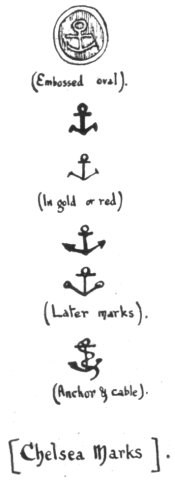
(Embossed oval).
(In gold or red).
(Later marks).
(Anchor & cable).
[Chelsea Marks].
One pleasing feature is the fact that Mr. Sprimont made a handsome fortune by his skill and industry as a director. During his time, it is said that “the china was in such repute as to be sold by auction, and as a set was purchased as soon as baked, dealers were surrounding the doors for that purpose.” This fanciful scene of competing dealers striving to secure a specimen of Chelsea almost before it was cooled from the furnace is too picturesque to be literally true.
We reproduce a figure of a carpenter, eight inches high, coloured, marked with anchor in red (p. 29). This specimen of Chelsea is now at the Bethnal Green Museum. We give an illustration of a beautifully decorated vase in the collection at the British Museum, representing the Death of Cleopatra. The French style of design is singularly evident in this example (p. 31).
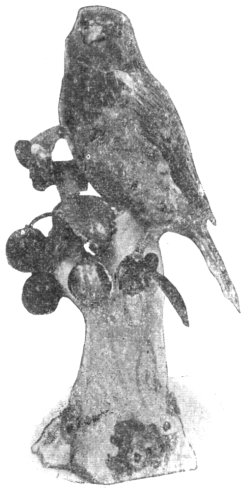
CHELSEA FIGURE.
Marked with anchor in red.
(Height, 8 inches.)

CHELSEA FIGURE.
Marked with raised anchor painted red.
(Height, 61⁄2 inches.)
Of the marks on Chelsea china, it may be observed{35} that the earlier specimens, in the days when they imitated blue and white Oriental models, are unmarked. Later the anchor appears, embossed in a raised oval, impressed on the bottom of the piece, and bearing the anchor in relief. Various forms of the anchor are used, and in varying colours, apparently according to the caprice of the workman, who drew it with his hair-pencil. Red is the colour most commonly used, and the best pieces are mostly marked in gold, with the anchor more carefully drawn.

(In gold on best pieces).
(Mark on milk jugs in form of goat).
Chelsea 1745
(Earliest dated example)
[Chelsea Marks].
Specimens with the double anchors are very valuable, as this was a mark only used on very high-class pieces.
The triangle is one of the marks of Bow, and the little milk-jugs in the form of a goat, decorated with raised flowers, were attributed to Bow, on account of this mark, but the last mark we give shows beyond dispute that the triangle was also used as a Chelsea mark.
Having told of the rise and progress of Chelsea, we have regretfully to chronicle its fall. The following contemporary advertisement is mournful reading: “To be sold by auction, by Mr. Burnsall, on the premises, some time in March next (1764),{36} at the Chelsea Porcelain Factory, everything in general belonging to it, and all the remaining unfinished pieces, glazed and unglazed; some imperfect enamelled ditto, of the useful and ornamental; all the materials; the valuable and extensive variety of fine models in wax, in brass, and in lead; all the plaster moulds, and others; the mills, kilns, and iron presses; together with all the fixtures of the different warehouses; likewise all the outbuildings, etc., etc. And, as Mr. Sprimont, the sole possessor of this rare porcelain secret, is advised to go to the German spaw, all his genuine houshold furniture, etc., will be sold at the same time.
“N.B.—Soon after, when everything is sold belonging to the manufactory and the large warehouse cleared, there will be some most beautiful pieces of the truly inimitable Mazarine blue, crimson, and gold, that Mr. Sprimont has thought deserving finishing; that will be sold at Chelsea, as the whole remaining and the last produce of that once most magnificent porcelain manufactory.”
This was in 1764, but no purchaser came forward, and the factory lingered on till 1769, when again we find it advertised, and the end of Chelsea china is very near, Mr. Sprimont having entirely left off making the same. Josiah Wedgwood had some idea of purchasing some of the Chelsea china: “There’s an immense amount of fine things,” he writes to Bentley. But at this date, Mr. William Duesbury, of the Derby manufactory, took over the Chelsea works as he had previously taken over those{37} of Bow, and carried them on for some years until 1784, when he pulled down the buildings, and removed all that was useful to his factory at Derby, and thus the manufacture of Chelsea china came to an end.
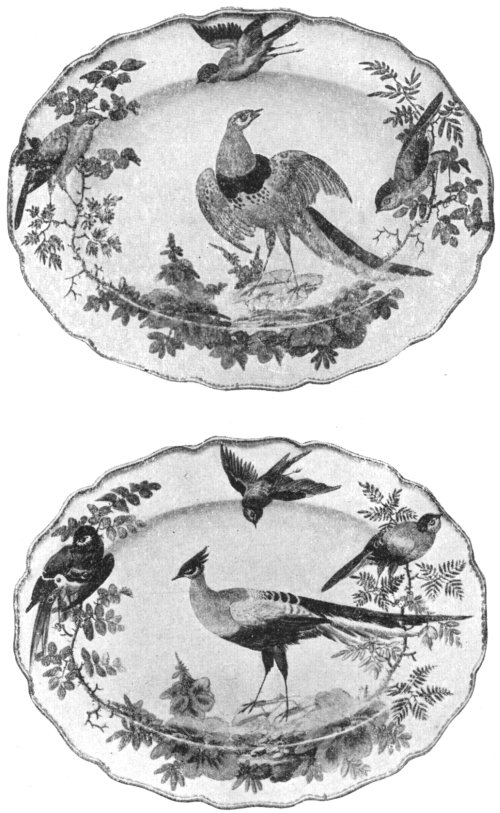
CHELSEA DISHES.
Painted with tropical birds in brilliant colours.
(Width, 121⁄2 in.).
The earliest examples of Chelsea china were in imitation of the ordinary blue Delft patterns, but later, Oriental patterns were very successfully copied, both in blue and white, and in mixed colours. Both Sèvres and Dresden were then adopted as models, and with very fine results. The colours were remarkably vivid, and only skilful artists were employed, the specimens they turned out being exquisitely decorated and finely conceived. The fine vases in the French style in imitation of Sèvres, with gros bleu, crimson, turquoise, and apple-green were made from 1760 to 1765.
Later, debased French forms were copied and an over elaboration was employed which marked the decadence of Chelsea. This over elaboration in art often marks the period of its decline. When wood engraving attempted to copy the refinements and delicacy of steel engraving it exceeded its limitations. To-day the glass-blower of Venice commits the same blunder when he, with false art puts lace patterns on his glass ware.
The two most important specimens of Chelsea china, both from their size and quality, are undoubtedly the “Chesterfield” vase, and the “Foundling” vase. They are two feet high, with bold rococo scroll handles, surmounted by dome-shaped covers; they are painted with pastoral subjects on{38} white medallions. The reverse sides are painted with exotic birds of rich plumage, and the body or ground of the vase is of a rich gros bleu colour. The former was bought for £2,000 by the Earl of Dudley, and the latter, which was a gift to the{39} Foundling Hospital, was sold by the Governors to the same nobleman, and they are now both at Dudley House. We give an illustration of the celebrated “Foundling” vase.
The raised flowers arranged in vases and ornamental figures were a feature of Chelsea ware; butterflies, bees, and other insects were introduced among the leaves, and the modelling was always well done. We reproduce a characteristic piece of Chelsea with delicate work, and exhibiting many of the individualities of Chelsea design (p. 27).

Derby-Chelsea Marks.
Mark Copied from Chinese ——.
As the earliest specimens of Chelsea were unmarked they can only be judged by the body, the general style of workmanship, and the glaze. The ordinary Chelsea marks we have already given, but we now give the marks which were used by Mr. Duesbury for a time when he was proprietor both of the Derby works and those of Chelsea. This ware is known as “Derby-Chelsea” ware, and is very much sought after. There are some finely enamelled plates in the Victoria and Albert Museum with the mark we give. They are magnificent specimens of the Derby-Chelsea and are scarcely distinguishable from their Oriental prototypes except in the softness of the paste.
It is interesting to remember that Dr. Johnson thought he could discover a means of further perfecting the Chelsea china. He applied to the proprietors, who allowed him to fire his compositions in their ovens at Chelsea. The worthy lexicographer attended there about twice a week and stayed all day, accompanied by his housekeeper, who brought a basket of provisions with her. Nothing, however, came of the experiments.
In taking leave of Chelsea we must remember that its success was an encouragement for the formation of manufactories in other parts of the country during the closing years of the eighteenth century. The workmen trained there under Sprimont found their way to Derby and to Worcester, and to parts of Staffordshire, and carried their experience with them. If for nothing else Chelsea deserves to be remembered as an art centre; and although Sprimont broke down in health and had to go to the “German spaw,” and leave his pictures to be sold at Christie’s, for all that, Chelsea spelt success.
The glaze is a softer milky white, and is not so thick as that on Bow pieces. It is carefully finished in every detail. The figure subjects are not so crudely painted as those of Bow. Three spots unglazed are sometimes found on Chelsea plates and dishes, caused by the three points on which pieces have rested. Chelsea china is remarkable for its{41} great weight. The bases and rims, particularly of smaller pieces, are ground quite smooth. Just above the rim black specks and small tears of the coagulated glaze are noticeable. As in Bow, an insect or spray was sometimes cleverly painted over flaws and defects.
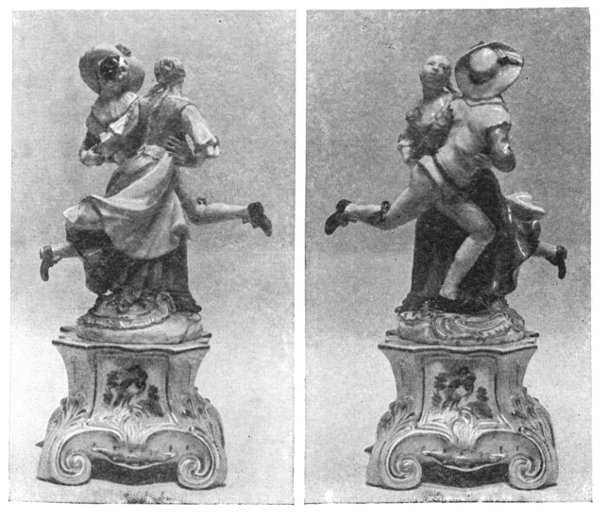
CHELSEA CHINA (1750-1760).
Pair of groups of two figures. Harlequin dancing with a girl. Painted in delicate colours.
(Height, 83⁄4 in. Mark, an anchor in red.)
| Chelsea. | £ | s. | d. | |
| Vases, pair, oviform, of tall, slender form, slightly fluted, with mottled dark blue ground, richly gilt with pheasants and other birds and foliage, and with white and gold scroll handles, entwined with groups of fruit and flowers, painted in rich colours, 161⁄2 in. high. Christie, May 2, 1902 | 756 | 0 | 0 | |
| Teacup and saucer, painted with exotic birds and fruit, and with alternate mottled dark blue panels with gilt borders. Christie, July 18, 1902 | 23 | 2 | 0 | |
| Inkstand, with sand vase and pen-box, dark blue ground, gilt with flowers, surmounted by a figure of a lamb. Christie, November 14, 1902 | 26 | 5 | 0 | |
| Plates, twelve, with turquoise and gilt scroll borders, each painted with exotic birds and foliage in three compartments, in claret-coloured riband borders, butterflies and other insects in the centre; gold anchor mark. Christie, January 23, 1903 | 65 | 2 | 0 | |
| Boar’s-head dish, forming a bowl, cover and stand, painted in natural colours, the dish moulded with an oak branch, rushes, and knife in{43} relief, on a maroon and gold ground, 103⁄4 in. high, 22 in. long. Christie, May 8, 1903 | 94 | 10 | 0 | |
| Vases, pair, flat-shaped hexagonal, with small necks, spreading lips, and white and gold scroll handles, each vase painted with a group of Bacchantes and Satyrs in a landscape, in upright panel on maroon ground, and gilt with birds, festoons of flowers and scrolls, 73⁄4 in. high. Formerly the property of Sir Robert and Horace Walpole. From Lord Cadogan’s Collection, 1865 (£155). Christie, February 27, 1903 | 304 | 10 | 0 | |
| Group of two birds on a tree-stump—raised anchor mark, 41⁄2 in. high. Christie, July 5, 1920 | 48 | 6 | 0 | |
| Figure of Justice, 11 in. high. Christie, July 5, 1920 | 9 | 9 | 0 | |
| Pair of candlesticks, with figures of Mars and Venus standing in flowering arbours, 8 in. high. Christie, July 5, 1920 | 9 | 9 | 0 | |
| Candlestick, the stem encrusted with flowers, and with a figure of Cupid holding a heart at the base, 9 in. high. Christie, July 5, 1920 | 6 | 16 | 6 | |
| Pair of candelabra, with figures of a shepherd and shepherdess leaning on{44} balustrades, holding a bird-cage and bird, with a lamb and dog at their feet, 91⁄2 in. and 11 in. high. Christie, July 5, 1920 | 28 | 7 | 0 | |
| Figure of Minerva, 13 in. high. Christie, July 5, 1920 | 5 | 5 | 0 | |
| Plate, the centre painted with a bouquet and sprays of flowers, the border with exotic birds, modelled and gilt with foliage scrolls; gold anchor mark, 83⁄4 in. diameter. Puttick & Simpson, July 16, 1920 | 5 | 5 | 0 | |
| Plate, painted with exotic birds and branches; and one, with green scroll border. Christie, July 20, 1920 | 10 | 10 | 0 | |
| Two Plates, painted with birds and insects on white ground, with white and gold scroll borders. Christie, July 20, 1920 | 6 | 6 | 0 | |
| Pair of Figures of a shepherdess, with a lamb, and a youth, with a letter, on plinths encrusted with flowers; 71⁄2 in. high. Christie, July 20, 1920 | 8 | 8 | 0 | |
| Three Figures, of Erato, Calliope and Thalia, on plinths encrusted with flowers, modelled by Roubilliac, impressed R., on scroll pedestals painted with butterflies, 151⁄4 in. high. Harland-Peck Sale. Christie, June 23, 1920 | 283 | 10 | 0{45} | |
| Set of Three Vases and Covers, painted with Venus and Cupid, Apollo and Daphne and other subjects in panels framed with gilt garlands of flowers on claret-coloured ground, and with small panels enclosing landscapes and birds on the reverse, the necks pierced with shells and scrollwork, and with scroll handles and feet, 17 in. and 14 in. high. Christie, July 22, 1920 | } | 6310 | 0 | 0 |
| Two Pairs of Vases and Covers, nearly similar, painted with Venus and Cupid and Leda and the Swan, 141⁄2 in. and 151⁄2 in. high | ||||
| Cup on circular foot, decorated with birds and flowers, 43⁄4 in. Sotheby, May 17, 1920 | 8 | 10 | 0 | |
| Dish, painted with flower-sprays and animals in colours, the borders moulded with trellis and scrollwork, 141⁄2 in. diameter. Christie, July 5, 1920 | 9 | 19 | 6 | |
| Pair of groups for candlesticks of birds in elaborate floral borders on scroll bases, inscribed “The Cock and the Jewel” and “The Vain Jackdaw,” with handles and places for sconces. Sotheby, May 17, 1920 | 41 | 0 | 0 | |
| Pair of miniature figures of a shepherd{46} and shepherdess, 3 in. high. Christie, July 12, 1920 | 21 | 0 | 0 | |
| Two Figures of Birds, 23⁄4 in. and 2 in. high. Christie, July 12, 1920 | 5 | 5 | 0 | |
| Derby-Chelsea. | ||||
| Coffee-cups and saucers, pair, painted in green and gold festoons and Cupids in lake; gold mark. Sotheby, May 4, 1903 | 25 | 10 | 0 | |
| Teacups and saucers, pair, fluted and painted with sprays of flowers in green, with alternate crimson panels, gilt, with foliage. Christie, June 16, 1903 | 52 | 10 | 0 | |
| Derby-Chelsea Figure of John Wilkes, 111⁄2 in. high. Christie, July 5, 1920 | 12 | 12 | 0 | |
| Derby-Chelsea Figure of a youth, playing drum, on gilt scroll plinth, 81⁄2 in. high. Christie, July 12, 1920 | 10 | 10 | 0 | |
| Pair of Derby-Chelsea Figures of children, emblematic of Autumn and Winter, 43⁄4 in. high. Christie, July 12, 1920 | 11 | 11 | 0 | |
| Derby-Chelsea Teapot cover and stand, painted with garlands of flowers in green, in radiating panels with pink ribbon borders, 51⁄2 in. high, teapot with gold mark. Puttick & Simpson, July 16, 1920 | 7 | 17 | 6{47} | |
| Pair of Derby-Chelsea Figures of Shakespeare and Milton on oblong white and gold pedestals, 12 in. high. Christie, July 5, 1920 | 15 | 15 | 0 | |
| Pair of Derby-Chelsea Figures of a boy and girl, with cat and dog, 6 in. high. Christie, July 20, 1920 | 22 | 1 | 0 | |
| Two Derby-Chelsea Figures of children, carrying baskets of flowers, 61⁄2 in. high; and a figure of a child, with a wreath of flowers, 6 in. high. Christie, July 20, 1920 | 17 | 17 | 0 | |
| Pair of Derby-Chelsea Figures of a boy and girl with dog and cat, 8 in. high. Christie, July 5, 1920 | 12 | 12 | 0 | |
| Derby-Chelsea group of four children around an obelisk, 91⁄2 in. high. Christie, July 5, 1920 | 6 | 6 | 0 | |
| Derby-Chelsea Figure of a youth, seated with an eagle beside him, 91⁄2 in. high. Christie, July 5, 1920 | 10 | 10 | 0 | |
| Derby-Chelsea group of a shepherd and shepherdess, with a lamb and grapes, 81⁄2 in. high. Christie, July 5, 1920 | 11 | 11 | 0 | |
| Derby-Chelsea Figure of Milton on scroll base, 121⁄2 in. high. Puttick & Simpson, July 9, 1920 | 5 | 5 | 0 | |
| Derby-Chelsea group of the Continents, modelled by John Whitaker, 111⁄4 in. high. Puttick & Simpson, July 16, 1920 | 17 | 17 | 0 | |
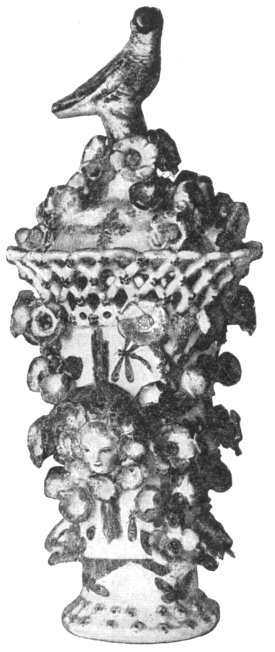
BOW VASE, WITH COVER.
(Finely decorated in colours.)

BOW INKSTAND (DIAMETER 4 IN.).
“Made at New Canton, 1751.”
At the Victoria and Albert Museum.
III
THE BOW CHINA FACTORY
In this “Chat” we shall treat of the wonderful porcelain made at Bow, or “New Canton,” as the makers called their factory on the banks of the Lea. It was established about 1730, and it ceased about 1776. That is to say, it commenced with the reign of George II. and continued for a short time during the reign of George III. Pope was not dead, Fielding was writing his novels, Burke was electrifying the country with his genius, the great Doctor Johnson was in the midst of his Dictionary, David Garrick was holding the town in a spell by his art, and Sir Joshua Reynolds was, with his brush, perpetuating the beauties of his day, while Burns and Scott, Wordsworth and Coleridge, and{50} Byron, Thackeray, and Dickens were then in the unborn future.

BOW FIGURE (6 IN. HIGH).
Woman playing pastorella.
At the Victoria and Albert Museum.
So this porcelain of Bow comes to us direct from the eighteenth century. We have been taught to regard the eighteenth century as a period of lace-ruffles and wigs, of powder and of patches, of dull, insipid ladies, of hard-drinking squires, of rough soldiers—a century with little or no love of art, when Shakespeare had been almost forgotten. Of its china, certainly, we call up only a picture of ugly grinning monsters, and little meaningless gee-gaws—snuff-boxes and patch-boxes, and china{51} handles for walking-sticks; but a glance at what Bow produced dispels so crude an idea at once, and, let us hope, for ever. Bow, in its own field, is worthy to stand by the side of what Sir Joshua has left us, and what Gainsborough bequeathed to posterity as poetic memories in paint and canvas of “dead women, loved and gone.”
As in our other “Chats” on Derby and Worcester and Chelsea, so with Bow, we shall have to tell of the human lives that have gone to the making of these fragile porcelain figures, all that is left to us of dead men’s life-work—which Polly or Molly or Elizabeth Ann may demolish by a fatal twist of the feather-brush. A patent was taken out by Edward Heylin, in the parish of Bow, and Thomas Frye, of the parish of West Ham, in 1744, for a new method of manufacturing “a certain mineral, equal to, if not exceeding in goodness and beauty, china or porcelain ware imported from abroad. The material is an earth, the produce of the Cherokee nation in America, called by the natives unaker.” In 1749, Thomas Frye took out, alone, a second patent “for a new method of making a certain ware, which is not inferior in beauty and fineness, and is rather superior in strength, than the earthenware that is brought from the East Indies, and is commonly known by the name of China, Japan, or Porcelain Ware.”
A word or two concerning Frye. Our Irish readers will be glad to learn that he was born at Dublin, in 1710. He came to London in 1738, when, he painted a portrait of Frederick, Prince of Wales{52} for Saddlers’ Hall. At the establishment of the Bow factory he took the management. To bring the china to perfection, he spent fifteen years of his life among furnaces, which had so bad an effect upon his health that his constitution nearly broke down. In 1759 he had to go to Wales for a change of air, and in 1760 he returned to London, and we find him taking a house at Hatton Garden, where he executed some important mezzotint engravings—which, as Mr. Rudyard Kipling observes, “is another story.” He died of consumption in 1762. Perhaps Oliver Goldsmith had him in mind (who knows?) when he wrote his line—
To ladies it will be especially interesting to read that Frye had two daughters, who assisted him in painting the china at Bow.
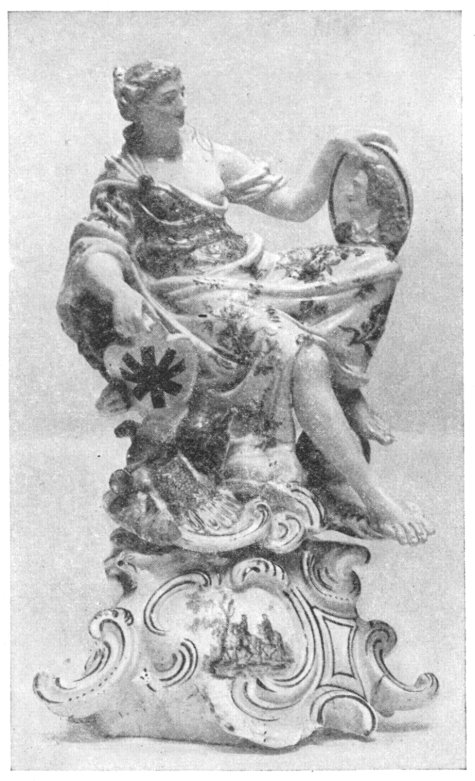
BOW CHINA.
Figure of Britannia with medallion of George II.
(Decorated in colours, on rococo base.)
Readers will, before now, have come to the conclusion that the study of old china is not superlatively easy, and that the question of marks is at the best a vexed one. Should there be any who have any lingering doubts on this point, they will speedily join the majority when they come to consider the bewildering marks of the Bow factory. These same marks, be it said, have puzzled experts who have denied each other’s conclusions, though with hardly as much vehemence as the late Mr. Bret Harte’s learned society “Upon the Stanislaus,” who engaged in conflict “with the remnants of a palæozoic age” in shameful manner—
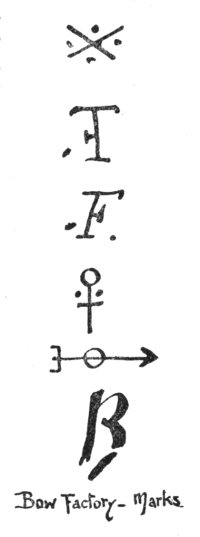
Bow Factory—Marks.
We give one set of the known marks of the Bow factory, later we shall give another set no less puzzling. It is difficult to attempt to offer any definite conclusions, or to do more in the space at our disposal than to state that these are marks known to have been used at Bow, and are upon specimens in the national or well-known private collections. The letter B and the drawn bow, of course, explain themselves. The crescent in blue and the sword and anchor in red occur together on a china figure of a sportsman with a gun. It is conjectured that the introduction of a dagger may have been due to the fact that both proprietors were freemen of the City of London, and the dagger, as is well known, is part of the City arms. The triple mark of the anchor with the vertical and horizontal daggers, by some collectors is ascribed to early{54} Chelsea, by others to Worcester; it is a disputed point.
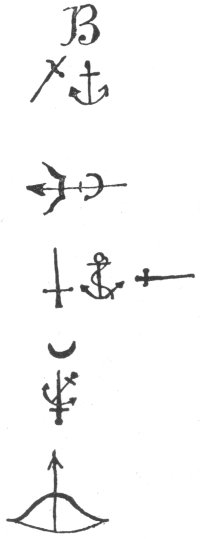
BOW FACTORY MARKS.
The little figure we reproduce (on p. 50) is of a woman playing the pastorella. It is one of a pair of figures. The other represents a man singing. Each figure is marked in red with both anchor and dagger. The pastorella represented in the figure was a musical instrument in general use previously to the introduction of the spinet. It may be remarked that at the back of each of these figures, near the base, a square hole has been pierced before glazing, for the purpose of receiving a metal stem supporting nozzles for candles. As this square hole is said never to be found on similar Chelsea pieces, it has come to be regarded as a distinctive feature of old Bow figures.

PAIR OF BOW FIGURES.
Musical Subjects.
Man with flageolet and drum, Woman with triangle.
Marked with anchor in red, cross in blue.
Among the various articles made at the Bow factory may be enumerated the following, which have been taken from the account-books of the factory: Shepherds and shepherdesses, cupids, fluter, fiddler, harlequin, columbine, pierrot or clown, tambourine player, Dutch dancer, woman with chicken, birds on pedestals,{55} swans, boars, squirrels, goats, as well as many miscellaneous articles for general use, such as salt-boxes, candlesticks, mugs, pickle-stands, &c. We reproduce an inkstand, four inches in diameter, of white glazed porcelain decorated with flowers, which decoration we call attention to as being characteristic of Bow. An inscription appears at the top: “Made at New Canton, 1751” (p. 49).
Since Chaucer’s day, Stratford-le-Bow has come down to us in rhyme, for the poet playfully pokes fun at the good nun in his “Canterbury Tales”:—
But should china collectors who travel down the Great Eastern Railway wish a further fillip to remind them of Bow, sundry soap and candle factories, with stench so strong that it knocks at the railway windows, will arrest their straying thoughts. The literary reader may, when he catches glimpses of the brown and oily ooze of the River Lea, think of Coleridge’s lines to Cologne and the River Rhine.
And here at Bow linger still the memories of the old factory—a century old—where Quin as Falstaff was turned out in porcelain, and Garrick posed as Richard III. in a china figure. A match factory stands on the site of the old Bow China factory, but there is still a “China Row” to suggest the old days of “New Canton” and its wares.

BOW PLATE.
Decorated with oriental floral design in overglaze colour in red, green, and blue. (Diameter, 83⁄4 in.).
In the collection of the Author.
The discovery is interesting of fragments of old{57} Bow porcelain, and portions of “saggers” on the site of one of the kilns while digging a drain from the match factory.
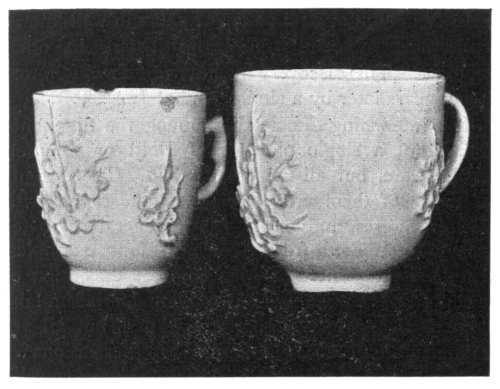
BOW WHITE CHINA CUPS HAVING RAISED MAYFLOWER PATTERN AFTER CHINESE DESIGNS.
Victoria and Albert Museum.
The children of the neighbourhood were observed to have as playthings bits of broken china of a high-class and delicate ware, never emanating from the china shops of Bow, and Mr. Higgins, attached to the match factory, henceforth kept strict watch over the excavations, and careful examination unearthed a number of broken specimens of the Bow ware.{58} He and his sister carefully arranged the broken pieces, and they form an excellent authority, these trays of broken china, for determining the paste and glaze, and identifying the decoration and designs of Bow. By means of this find it was possible to classify many doubtful pieces of china in well-known collections hitherto wrongly attributed to other factories. This discovery by excavation was followed many years later by a similar find at Lowestoft.
It is interesting to note that among the fragments found, not a single piece is of Delft or common earthenware, but all are of porcelain. The designs of many of them are of Chinese landscapes, with flowers, figures, and birds. Their general character may be gathered from sketch of four examples. They are all painted in blue with the exception of a cup painted with green leaves and crimson-lake flowers. None of the pieces is printed, but all are painted with a brush. The other two illustrations we give are of china ornamented in relief, the favourite pattern being the mayflower. Each of these Bow cups is a typical example. The design stands out very sharply, and is raised from the surface of the china. The cups are rather heavy for their size.
Among the débris were found many pieces of an ornamental character, a salt-cellar beautifully modelled, formed of three shells, with smaller shells and seaweed between, but the upper shell to hold the salt is missing. Pieces of dishes, evidently intended to hold sweetmeats, were unearthed from this sewer hole, with finely designed corals and shells and seaweeds. Some natural shells were also found,{59} which had evidently served the artists as models. Two china pug-dogs were discovered with collars bearing roses on them.
Bow paste is exceedingly hard, and the fracture when it is broken is close and compact. The pieces as a rule are very heavy for their size, but many of the cups and saucers are almost of egg-shell thinness. The colour is milky white. Should any of our readers be possessed of Bow china, they may ratify its origin by carefully examining it, if possible, under a magnifying glass. On scrutinising the blue pieces it will be found there is a peculiarity in the glaze, which arises in this manner. At that time blue was the only known colour that would bear the intense heat of the kiln. It was always painted on the biscuit before being dipped in the glaze. It is found that certain portions of the blue, however slight, are apt, while the glaze is in a fluid state, to spread over the surface, giving it a blue tinge. The other colours as well as the gold were painted over the glaze, and set in a kiln of lower temperature. Hence the blue, being under the glaze, is imperishable, and the other colours from frequent use get rubbed off.
We have given a number of marks used at Bow; we supplement that list by two others, one of which is exclusively composed of signatures actually used by Thomas Frye himself.
Although none of the ware unearthed at Bow was printed, yet printed ware did come from there. In all probability it was sent to Liverpool to have the transfer engravings, so much in vogue when Bow flourished, put on the china. As early as the year{60} 1756 this was done, for certain entries appear in the Bow books: “One pint printed mug: a sett compleat of the second printed teas.” Or it is possible that they were sent to Battersea to be printed. It is not a far cry from Bow to Battersea. Transfer printing on enamel was in vogue at Battersea before 1755. Horace Walpole, writing to a friend in 1755, says, “I send you a trifling snuff-box, only as a sample of the new manufacture at Battersea, which is done with copper-plates.” But Battersea and Battersea enamel—that is another story.
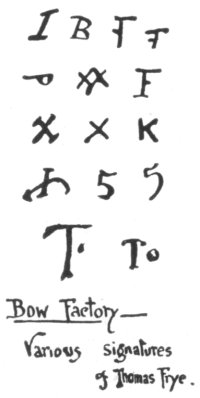
Bow Factory
Various Signatures of Thomas Frye.
It is to be hoped that this “Chat” on old Bow china will have helped readers, to whom Bow is a name, to form some idea of what went on there more than a century ago. The china cabinet holds more mysteries within it than many a good housewife dreams of. It will be seen that the difficulties of china-collecting are legion. At the modern find at Bow, lovers of china ought to be grateful, for it enabled many vexed questions to be settled, but what is Bow and what is Chelsea still puzzles experts. In all probability Bow, Bristol, and another very much debated factory, Lowestoft, will continue to offer traps and snares and pitfalls for the unwary collector (or misshapen falsities attributed to them) till connoisseurs{61} are no more and collecting days are done. The find in 1903 at Lowestoft is as important as the find at Bow, but it is exceedingly unlikely that any more facts will ever come to light respecting these old factories; every available source of information has been tapped and all that can be known concerning them is known. The potters who made the exquisite shapes, the artists who painted the roses on bowl and beaker, have long since departed with the roses of yester-years. Their life-work is scattered. Much of it, perhaps most of it, is gone for ever. Each cup and each dish of the long-dead artist is like “a good deed in a naughty world.” To-day, with a handful of facts, collectors and connoisseurs wrangle together over theories.
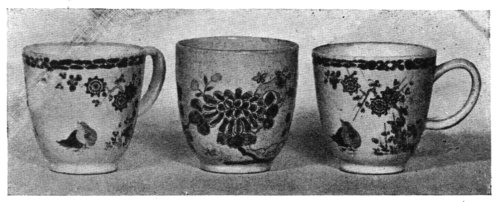
BOW CUPS.
The celebrated quail pattern; floral decoration, gilded, birds touched with blue. Middle cup, floral design in crimson and green.
In the Collection of the Author.
Disputes have been held as to the origin of certain pieces of puzzling technique. Some experts have believed them to be Chelsea or Longton Hall. Even the “Craft Bowl,” one of the earliest pieces of Bow china, now at the British Museum, is known to have been decorated in a kiln at Kentish Town.
Body and glaze often defective, pattern so arranged as to cover flaw. Insects often introduced for this purpose to hide imperfections. Coarse, chalky white ware, covered with glaze much pitted and speckled. The bottom often shows three marks representing points on which piece rested in kiln. The glaze is thickly applied, and fills up interstices of raised{62} patterns. The body and glaze varied; the earlier pieces have a yellow tinge in the glaze. The bottoms of some basins and dishes are often twice as thick as the sides. The ware, owing to large amount of lead used, is discoloured.
| Bow. | £ | s. | d. |
| Figures, pair, emblematical of Autumn and Winter, 71⁄4 in. high. Christie, February 4, 1902 | 16 | 16 | 0 |
| Groups, pair, a drummer and piper, 10 in. high. Christie, February 4, 1902 | 48 | 6 | 0 |
| Figures, pair, of a girl and youth, with bagpipes, a dog and flowers, 71⁄2 in. high. Christie, April 25, 1902 | 16 | 5 | 6 |
| Groups, pair, with figures of a Chinaman, child, and monkey; and the companion, on scroll plinths, 91⁄2 in. high; rare mark, B, intertwined with the anchor and dagger. Christie, June 20, 1902 | 42 | 0 | 0 |
| Cream-jug, with flowers in relief, coloured; impressed triangle mark. Christie, June 24, 1902 | 25 | 4 | 0 |
| Ink-stand, with ink-vase, sand-box, candlestick, and pen-tray, painted with landscapes and insects, the pen-tray surmounted by a group of a goat and two children, 91⁄2 in. wide. Christie, July 2, 1902 | 17 | 6 | 6 |
| Cream-jugs, two, with goats and bee in relief. Christie, November 28, 1902 | 16 | 16 | 0 |
| Figures of parrots, pair, holding fruit and perched upon stumps of trees,{64} resting on tripod scroll, bases encrusted with flowers, the birds are painted in natural colours, height 71⁄2 in. and 61⁄2 in. Sotheby, November 11, 1902 | 33 | 0 | 0 |
| Statuette, on scroll base, of a boy playing a drum, painted in colours, with gilding and encrusted with jesmine at sides, modelled by Tebo, height 10 in. Sotheby, November 11, 1902 | 16 | 10 | 0 |
| Figure. Bacchus squeezing grapes in cup, 11 in. high. Sotheby, May 17, 1920 | 19 | 0 | 0 |
| Figure of girl carrying basket, and her apron full of flowers, 51⁄8 in. Sotheby, May 17, 1920 | 6 | 15 | 0 |
| Figure of a child, emblematic of Winter, 63⁄4 in. high. Christie, July 20, 1920 | 8 | 18 | 6 |
| Figure of Cupid, kneeling before a flowering tree with a bird in the branches, 8 in. high. Christie, July 5, 1920 | 4 | 4 | 0 |
| Figure of two birds, perched on flowering branches, 61⁄2 in. high. Christie, July 5, 1920 | 6 | 6 | 0 |
| Pair of Figures of Neptune and Pomona, 73⁄4 in. high. Christie, July 5, 1920 | 14 | 3 | 6 |
| Figure of Jupiter, with an eagle and thunderbolt, 61⁄2 in high. Christie, July 5, 1920 | 8 | 8 | 0 |
| Figure of Minerva, richly coloured, on{65} scroll plinth encrusted with flowers, 131⁄2 in. high. Christie, July 5, 1920 | 14 | 14 | 0 |
| A nearly similar figure on white scroll plinth. Christie, July 5, 1920 | 5 | 5 | 0 |
| Pair of octagonal dishes, painted with quails and flowering plants in the Hizen taste, 91⁄2 in. wide. Puttick & Simpson, July 16, 1920 | 10 | 10 | 0 |
| Figure of Neptune holding a vase, and with dolphin, on wave base, 73⁄4 in. high. Puttick & Simpson, July 16, 1920 | 8 | 18 | 6 |
| Figure of Minerva on pierced scroll base, outlined with turquoise and gilt, red anchor and dagger mark, 81⁄2 in. high. Puttick & Simpson, July 16, 1920 | 15 | 15 | 0 |
| Pair of Figures of a boy and girl, wearing Eastern costumes, and with dog and lamb, on shaped bases, with three scroll feet, red anchor and dagger mark, 6 in. high. Puttick & Simpson, July 16, 1920 | 19 | 19 | 0 |
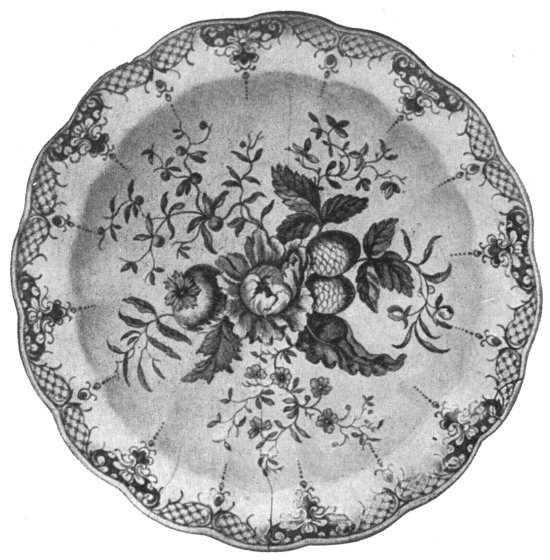
EARLY BLUE AND WHITE WORCESTER PLATE.
(Marked with crescent.)
In the Collection of the Author.
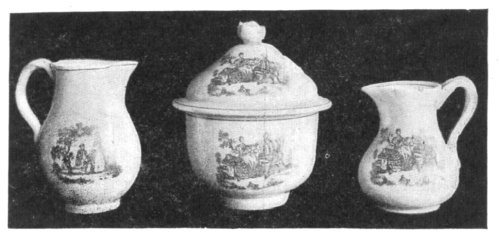
OLD WORCESTER SUGAR-BASIN AND CREAM JUGS.
(Transfer-printed in black.)
IV
OLD WORCESTER
In old Worcester china there lies a magic that appeals to the collector of fine copies and adaptation from Nankin and other Chinese porcelain. The real old blue colouring of Worcester has a charm about it which cannot be reproduced nowadays. There is something personal about the productions of the old factories; the workman was proud to make his mark at the bottom of the plate or bowl he had created, much in the same manner as the masons who built Fountains Abbey left each man his mystic sign on each stone he carved.
If the reader chooses to weave a romance of airy nothingness on an old cracked bowl of Worcester blue there is substance enough, if he has the mind to do so. Mr. Austin Dobson, in one of his charming{68} villanelles, has taught us how much lies in the dreamy depths of a plate with queer Chinese blue figures on it:—
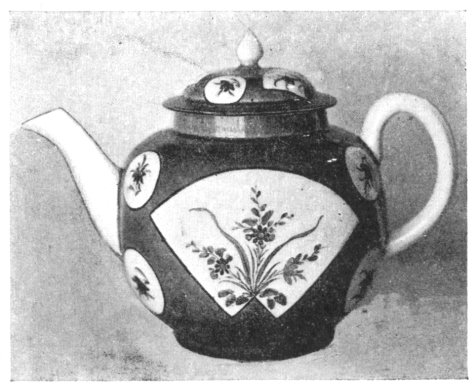
WORCESTER TEAPOT.
Powder blue ground with white reserves decorated in blue.
We have already given the story of old Derby china, and when Derby and Chelsea and Bow were establishing for themselves a reputation, Worcester was engaged in experimenting in the same direction in the person of one Dr. John Wall, a physician of{69} that city. He was a man of considerable taste, and besides being a clever practitioner, he was a practical chemist, and an artist of some ability. One of his paintings hangs in the hall of Merton College, Oxford, of which he was a Fellow. He was an etcher, and designed stained-glass windows; one of his windows is at Oriel College. What William Duesbury was to Derby and the foundation of the china factory there, and what Josiah Wedgwood was to Staffordshire, that was Dr. John Wall to Worcester. His was the guiding intellect of the Worcester enterprise, which culminated in 1751, about a year after Derby had been established, in the establishment of a manufactory of porcelain in the “faithful city.”
These were restless times, very troublesome then to domestic England, and having an influence upon art. Only six years prior to this the Pretender had invaded England with an armed force, and had penetrated as far as Derby. Party feeling ran very high. It has been asserted that the industry was introduced to Worcester for political reasons, so that the Georgian party might gain votes in the county against the Jacobites, who were strong in Worcester. It seems certain enough that Dr. Wall began his experiments merely for the love of the study, but whether he was used by politicians, or whether he used them, is of no moment to us; suffice it to say that the Worcester Porcelain Company was founded in 1751, and among the prominent co-operators with Dr. Wall were William Davies, an apothecary, and Edward Cave, the founder of the Gentleman’s Magazine. This{70} latter was of inestimable use to the factory for advertising their wares.
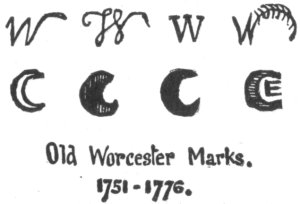
Old Worcester Marks.
1751-1776.

Old Worcester Marks.
The earliest Worcester productions were based entirely on Chinese models. Small cups, without handles, of Oriental design were decorated under the glaze in blue. All the characteristics of the Nankin ware became those of Worcester. Slowly and surely they attempted with complete success some of the{71} more brilliant colours of Eastern ceramic ware, notably from the Japanese.
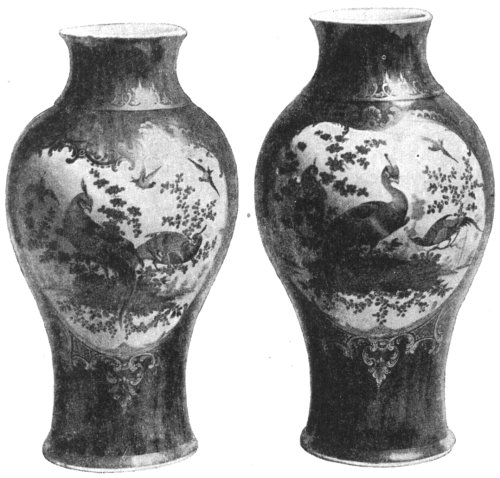
PAIR OF WORCESTER VASES.
(Dr. Wall period with square mark.)
Finely painted exotic birds in colour.
The early ware of Worcester may be known by a peculiar greenness of hue in the body of the china. The first mark used was the letter W in some form or another. This letter may stand either for Wall or for Worcester, as D marked on Derby china may stand either for Duesbury, the founder, or for Derby. We reproduce several of the earliest Worcester marks. About the same time a crescent was used, which is believed to have been adopted from the arms of the Warmstrey family, in whose ancient mansion the factory was first started.
The first two letters, ![]() , in script, were used when
the factory was under the direction of Dr. Wall, who
died in 1776. The capital W was marked in blue
on early printed china. The crescent in outline was
one of the earliest marks, while the second crescent
filled in with blue, under the glaze, occurs on
blue-printed china, which was invented about
1755.
, in script, were used when
the factory was under the direction of Dr. Wall, who
died in 1776. The capital W was marked in blue
on early printed china. The crescent in outline was
one of the earliest marks, while the second crescent
filled in with blue, under the glaze, occurs on
blue-printed china, which was invented about
1755.
Among other early Worcester marks are assimilations and variations of certain Chinese characters, probably from the models which the Worcester potters copied. Of the square marks, it may be observed that they do not always occur on Chinese patterns. Occasionally, too, a crescent in red is found with one of these squares in blue. Of the other ornate and curiously Eastern adaptations, it may be that they were workmen’s signatures, but they are only found on old Worcester. The love for Oriental flourishes is shown by a series of numbers.{72} Examples from 1 to 9 are known. We reproduce the numbers 1, 4, 5, 7.
In 1756 the important invention of transferring printed impressions from copper plates was introduced at Worcester. It is debatable ground whether Battersea, Liverpool, or Worcester invented it. But in 1757 it had arrived at a wonderful state of perfection at Worcester. The engraver, Robert Hancock, was employed. Valentine Green, the great mezzotint engraver, was his pupil. A mug bearing the head of the King of Prussia, and dated 1757, is held to be one of the most characteristic pieces of this period.
Thomas Carlyle has a graphic description of one of these King of Prussia mugs, which piece of prose is worth giving in full, for we do not often see the historian of the French Revolution in the character of a china connoisseur:—
“There stands on this mantelpiece,” says one of my correspondents, the amiable Smelfungus, in short, whom readers are acquainted with, “a small china mug, not of bad shape, declaring itself, in one obscure corner, to be made at Worcester, ‘R. I., Worcester, 1757’ (late in the season, I presume, demand being brisk); which exhibits all round it a diligent potter’s apotheosis of Friedrich, hastily got up to meet the general enthusiasm of English mankind. Worth, while it lasts unbroken, a moment’s inspection from you in a hurrying along.
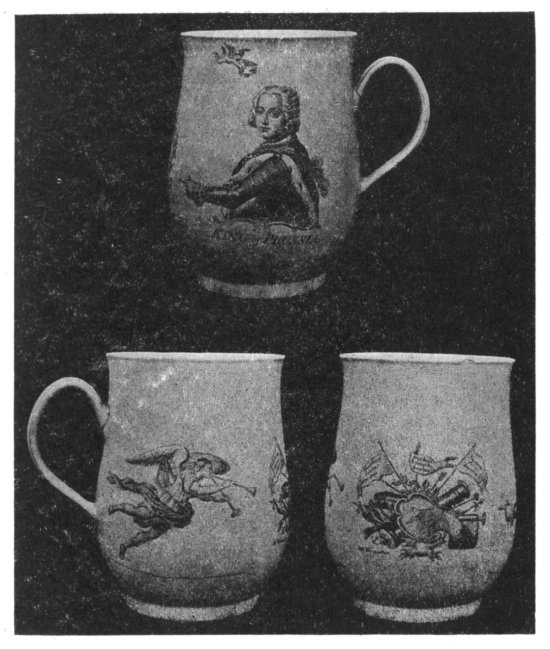
OLD WORCESTER MUG. (HEIGHT 53⁄4 IN.)
(Transfer-printed in black.)
With portrait of Frederick the Great, King of Prussia.
(Signed with initials of Robert Hancock), and Anchor.
“Front side, when you take our mug by the handle for drinking from it, offers a poor, well-meant{75} china portrait, labelled, King of Prussia: copy of Friedrich’s portrait by Pesne, twenty years too young for the time, smiling out nobly upon you; upon whom there descends with rapidity a small Genius more like Cupid, who had hastily forgotten his bow, and goes headforemost on another errand, to drop a wreath far too small for ever getting on (owing to distance, let us hope), though the artless painter makes no sign; and indeed both Genius and wreath, as he gives them, look almost like a big insect, which the King will be apt to treat harshly if he notice it. On the opposite side, again, separated from Friedrich’s back by the handle, is an enormous image of Fame, with wings, filling half the mug, with two trumpets going at once (a bass, probably, and a treble), who flies with great ease; and between her eager face and the unexpectant one of Friedrich (who is 180 deg. off, and knows nothing of it) stands a circular trophy, or imbroglio of drums, pikes, muskets, canons, field flags, and the like; very slightly tied together, the knot, if there is one, being hidden by some fantastic bit of scroll or escutcheon, with a Fame and one trumpet scratched on it; and high out of the imbroglio rise three standards inscribed with names, which we perceive are intended to be names of Friedrich’s victories; standards notable at this day, with names which I will punctually give you.
“Standard first, which lies to the westward or leftward, has ‘Reisberg’ (no such place on this distracted globe, but meaning Bevern’s Reichenberg, perhaps), ‘Reisberg,’ ‘Prague,’ ‘Collin.’ Middle{76} standard curves beautifully round its staff, and gives us to read ‘Welham’ (non-extant, too; may mean Welmina or Lobositz), ‘Rosbach’ (very good), ‘Breslau’ (poor Bevern’s, thought a victory in Worcester at this time!). Standard third, which flies to eastward or right hand, has ‘Newmark’ (that is, Neumarkt and the Austrian bread-ovens, December 4th); ‘Lissa’ (not yet Leuthen in English nomenclature); and Breslau again, which means the capture of Breslau city this time, and is a real success, December 7th to 19th; giving as the approximate date, Christmas, 1757, to this hasty mug. A mug got up for a temporary English enthusiasm, and for the accidental instruction of posterity. It is of tolerable china, holds a good pint, ‘to the Protestant hero with all the honours,’ and offers, in little, a curious eyehole into the then England, with its then lights and notions, which is now so deep-hidden from us, under volcanic ashes, French revolutions, and the wrecks of a hundred very decadent years.”
This mug bears the letters “R. H.” on it, the initials of the engraver.
In addition to this portrait of Frederick the Great there were others engraved of George II., George III., Queen Charlotte, the Marquis of Granby, and William Pitt. The full signature of Robert Hancock is often found on garden scenes and Watteau-like subjects.
We illustrate as a headpiece a group of two cream-jugs and a sugar-basin with black Worcester transfer-printed subjects on them.
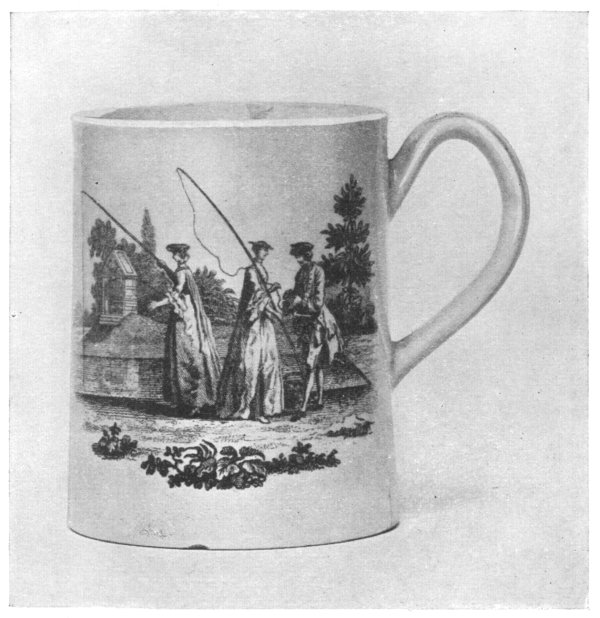
WORCESTER MUG.
(With subject in Watteau style transfer, printed in black.)
In the collection of Author.

WORCESTER DISH (MARKED WITH BLUE CRESCENT).
In Collection of Mr. W. G. Honey.
Leaving poetry and coming to fact, we arrive at the beginning of the second period in the history of the Worcester factory. Dr. Wall, the originator of the works, had died in 1776, and it must be borne in mind by the collector that from about the year 1764, when the Chelsea works became disorganised, up to the death of Dr. Wall, some of the most exquisite creations of Worcester were produced. Several of the Chelsea artists had come to Worcester, and mugs of a choice apple-green were made in imitation of the Sèvres ware, but none of these bear the Worcester mark. Vases with rich bleu-de-roi ground and{78} salmon-scale markings, with exotic birds of rich plumage, of varied and elegant design, belong to this period, and command at the present day very high prices. Donaldson and O’Neale were two of the best painters, and painted some of the finest Worcester vases so much sought after. At the Victoria and Albert Museum, in the collection of the late Lady Charlotte Schreiber, there are some particularly fine examples.

We reproduce a fine Worcester dish (103⁄4 in. by 83⁄4 in.) from the collection of Mr. W. G. Honey, recently at the Cork Exhibition. This specimen is an excellent example of the best period, and is marked with a blue crescent.
In 1783 the works passed into the hands of Mr. Thomas Flight, who, together with his two sons, Joseph and John, raised the manufactory to some eminence. In 1788, George III., with Queen Charlotte, visited the works, and the title “Royal” was added to the mark, above the word “Flight.” Later on, in 1791, Mr. Martin Barr joined the concern, the firm becoming “Flight and Barr.” It should be noted that Mr. Chamberlain, the head of the decorating department of the old factory,{79} never came under the Flight régime, but established a factory of his own at Worcester. We give in order of date the various marks used both by his factory and that of the Flights.

These two factories continued as rivals until 1840, when they amalgamated, and the two firms formed one company. The name of Flight and Barr disappears, and the business being carried on at Messrs. Chamberlain’s premises, the new Worcester mark became “Chamberlain & Co.” In 1850 Mr. W. H. Kerr joined the company, and for a little while the firm was known as “Chamberlain, Lilley, & Kerr.” In 1852 another change took place, Mr. Chamberlain and Mr. Lilley retired, and Mr. R. W. Binns entered into partnership with Mr. Kerr. From that time the manufactory, under the management of Kerr & Binns was known as “W. H. Kerr & Co.” It is important that the collector should know all these transitions in the ownership and management of the Worcester works, which has a continuous history of nearly a hundred and fifty years, a record not reached by any other English factory.
Besides the above-mentioned two main streams of Worcester porcelain manufacture, there is yet another{80} firm which was established in 1800 by Thomas Grainger, nephew to Mr. Chamberlain. The firm became Grainger, Lee & Co., and afterwards G. Grainger & Co. We give their marks, together with the other Worcester marks, to enable our readers to identify any specimens they may possess. One of the marks in the Kerr & Binns period requires explanation. The circle with the letter W radiating from the centre was especially designed for solely marking the productions of the factory made for the use of Queen Victoria and the Royal household.
The scent-bottle which we give as illustration has double sides, the outer being ornamented with perforated work, painted and gilt. The neck is beautifully decorated with flowers on a yellow ground. It is marked “Chamberlain’s Worcester.” It is an elegant piece, and very characteristically shows, for instance, in the double sides and perforated work, the influence of Chinese models. This specimen is at the Victoria and Albert Museum.

SCENT-BOTTLE.
CHAMBERLAIN-WORCESTER.
In Victoria and Albert Museum.
A set of three vases (151⁄2 in. high), marked “Grainger, Lee, & Co., Worcester,” have views on them of Camden Place, Bath, Redcliffe Church, Bristol, and St. Vincent’s Rock, Bristol.

SET OF WORCESTER VASES.
Grainger & Co. Early Nineteenth Century.
Left. Bath, Camden Place. Centre. Redcliffe Church, Bristol. Right. Bristol, St. Vincent Rock.
(Marked in script, Grainger, Lee and Co., Worcester, with titles also in script.)
About the time of the Exhibition of 1851 there was great energy displayed by the Worcester factory. Especially noticeable were the enamelled vases,{83} dishes, and ewers. This Worcester enamel is a variety of Limoges work (the Limoges being on copper and the Worcester wholly porcelain), which consists of applying semi-opaque white enamel of varying strength, produced by superimposing more or fewer layers in gradation upon a deep rich ground of blue. These enamels were designed to copy the fifteenth and sixteenth century work, and succeeded very well in their object. Later, Worcester essayed to produce jewelled porcelain, in which Berlin and Vienna had excelled a century before. It won especial praise at Paris in the 1867 Exhibition, and became a great financial success.
Whether it be with the Limoges ivory or with the newer Japanese designs which entered into the later Worcester productions, the Royal manufactory of the “faithful city” has always held its own with the foreign rivals and competitors at international exhibitions. At Berlin, Paris, Vienna, at Philadelphia, at Chicago, the success of modern Worcester is evidence enough of its vitality.
In the early period a simplicity characterised the productions. “Mandarin” designs from Chinese models prevailed. These old Worcester under-glaze blue pieces have a tone unlike any other English factory, and more nearly approach the Oriental quality of depth. Blue and white dishes with pierced borders, and open basket-work dishes were a feature.
Transfer printing over the glaze is one of the characteristics of the factory.
In the second period of Worcester were produced the elaborate vases in the style of Dresden and of Sèvres, the finest examples of Worcester.
The third period of over-elaboration in decoration marks the decline of Worcester.
The porcelain is thin and of very beautiful quality, having an ivory-like texture. There is a greenish tint in the paste when subjected to a strong light.
The varieties of bodies used at Worcester from time to time make any generalisation obviously impossible. It is only by handling specimens that the true feeling of Worcester may become instinct in a collector.
| Worcester. | £ | s. | d. |
| Dish, circular, the centre painted with butterflies, the border with exotic birds in panels, and butterflies in medallions in borders of dark blue and gold, 10 in. diameter. Christie, February 4, 1902 | 54 | 12 | 0 |
| Cups and saucers, pair two-handled, with exotic birds and insects in medallions, in gilt foliage borders on dark blue scale ground. Christie, February 4, 1902 | 90 | 6 | 0 |
| Bowl, the exterior painted with exotic birds, flowering trees and insects in scroll panels, with gilt borders on dark blue scale-pattern ground, gilt, with foliage, the interior painted with birds on white ground; 11 in. diameter; square mark. Christie, May 2, 1902 | 152 | 5 | 0 |
| Plates, pair, painted with groups of flowers and fruit in the centre in rich crimson scroll-pattern borders gilt with flowers and foliage, 9 in. diameter. Christie, June 20, 1902 | 35 | 14 | 0 |
| Cup and saucer, two-handled, painted with birds and insects in shaped panels, on pale canary scale-pattern ground. Christie, July 9, 1902 | 22 | 11 | 6{86} |
| Dessert dish, centre, scale-blue ground, painted with exotic birds, foliage and flowers in white panels of unusual shape, and surrounded by festoons of flowers and lattice designs in chased gold, also painted with flowers in colours at back. From the service made for Lady Mary Wortley Montague. Sotheby, November 11, 1902 | 101 | 0 | 0 |
| Plates, pair, painted with festoons and sprays of flowers in panels with gilt scroll borders on dark blue scale-pattern ground. Christie, November 28, 1902 | 35 | 14 | 0 |
| Teapot and cover, scale-blue ground, painted in panels of exotic birds, square mark. Sotheby, May 4, 1903 | 33 | 0 | 0 |
| Dish, large circular, painted with exotic birds, branches and insects in scroll panels with gilt borders, 13 in. diameter, with dark blue scale-pattern ground. Christie, May 28, 1903 | 132 | 16 | 0 |
| Jug, large, moulded with foliage in low relief, and bearded mask under the spout, and painted with exotic birds and foliage, butterflies and other insects in colours in two large and three smaller panels, in gilt scroll borders on a dark blue scale-pattern{87} ground, pink flowers in panels on the neck 111⁄4 in. high. Christie, May 8, 1903 | 147 | 0 | 0 |
| Jug, oviform, painted with birds and insects in scroll panels with gilt borders, 7 in. high. Christie, June 10, 1903 | 79 | 16 | 0 |
| Four old small modelled leaf Dishes, painted with flowers in the Chinese taste in blue, crescent mark, and four others. Puttick & Simpson, May 28, 1920 | 2 | 2 | 0 |
| Old Worcester teapot and cover painted with wheel pattern and gilt, 51⁄4 in. high, a saucer dish, a coffee cup and two saucers similar, all with square mark, and a saucer marked Flight and crescent. Puttick & Simpson, July 16, 1920 | 9 | 9 | 0 |
| Dessert service, by Flight, Barr and Barr, painted with named flowers on white ground, with gilt gadrooned edges, consisting of a pair of sugar-tureens and covers, a centre-dish on foot, ten shaped dishes and twenty-four plates. Christie, July 5, 1920 | 42 | 0 | 0 |
| Tea service, painted with flowers and foliage and dark blue panels, in the Oriental taste, consisting of a teapot, cover and stand, two cream-jugs,{88} milk-jug, sugar-basin, two bowls, twelve coffee-cups, nineteen tea-cups, thirty-two saucers, two egg-cups, four circular dishes and eighteen plates. Christie, July 5, 1920 | 57 | 15 | 0 |
| Tea Service, painted with flowers in colours, in the Oriental taste, and dark blue bands, consisting of a teapot, cover and stand, sugar-basin and cover, cream-jug and cover, canister, bowl, two dishes, eight tea-cups, six coffee-cups, and nine saucers. Christie, July 5, 1920 | 71 | 8 | 0 |
| Plate, Powder-blue, Dr. Wall period, octagonal 9 in., with reserve panels in white with landscape and flowers. Having mark of crossed swords, together with imitation Chinese mark. Sotheby, May 17, 1920 | 15 | 10 | 0 |
| Set of covered Vases and two Beakers, Dr. Wall period, decorated with vermilion, green, and gilt; in Chinese style with flowers and fabulous bird. Shoulders of vase and rims of covers and beakers, fine turquoise ground vase, 101⁄2 in., beakers 63⁄4 in. Sotheby, June 11, 1920 | 35 | 0 | 0 |
| Pair of Plates, Flight, Barr and Barr. Views of Barking Abbey and Melrose{89} Abbey. Scroll borders of mazarin, blue, heavily gilt. Sotheby, June 11, 1920 | 4 | 4 | 0 |
| Vase, painted with birds in heart-shaped panels with gilt scroll borders on mottled dark blue ground, 93⁄4 in. high. Christie, July 20, 1920 | 204 | 15 | 0 |
| Teapot and cover, painted with wheel pattern, 51⁄2 in. high, and two bowls, similar, 41⁄2 in. diameter, square mark. Puttick & Simpson, July 16, 1920 | 7 | 17 | 6 |
| Teacup, coffee-cup and saucer, of the same service, a cream-jug, a saucer dish, square marks, and a chamber candlestick, crescent mark | 7 | 17 | 6 |
| Pair of old square dishes, painted with groups of flowers in dark blue borders gilt with scrolls, 81⁄4 in. square. Christie, July 5, 1920 | 25 | 4 | 0 |
| Three Mugs, transfer-printed, with portraits of the King of Prussia and military trophies, by R. Hancock, 1757, 41⁄2 in. and 31⁄2 in. high. Christie, July 5, 1920 | 17 | 17 | 0 |
| Cylindrical Mug, transfer-printed, with a portrait of Shakespeare and Muses, 43⁄4 in. high; and a smaller ditto, with a portrait and figure of Fame. Christie, July 5, 1920 | 16 | 16 | 0{90} |
| Milk Jug and Cover, and a coffee-cup and saucer decorated with panels in pale blue, painted with fruit, with royal blue and gilt rims. W mark. Sotheby, May 17, 1920 | 26 | 0 | 0 |
| Plate, Powder-blue, Dr. Wall period, saucer-shaped, of Chinese form, decorated with exotic birds and insects, 71⁄4 in., square mark. Sotheby, May 17, 1920 | 13 | 0 | 0 |
| Teapot, fluted, with cover, painted with garlands of flowers, and with marbled turquoise and dark blue borders and gilt, crescent mark, 5 in. high. Puttick & Simpson, July 16, 1920 | 16 | 10 | 0 |
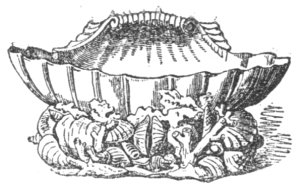
PLYMOUTH SALT-CELLAR.
At Victoria and Albert Museum.
V
The name of Plymouth stands high in the records of English china factories. Its porcelain was the first hard porcelain produced in this country. Other English chinas melted when placed inside the pieces in the Plymouth kilns.
Not so well known as Josiah Wedgwood, of the Staffordshire potteries, William Cookworthy, of Plymouth, Quaker, chemist, porcelain maker, is worthy of a niche in the gallery of dead princes of ceramic art, and his is a name that will never be forgotten by those who know the history behind the old Plymouth vases and mugs and statues.
It is true the enterprise was a failure. It only ran fourteen years, and was, in 1774, transferred to Bristol. It is true that Lord Camelford, one of his partners, laments the three thousand pounds expended on it. But it is more than true that the{92} results of William Cookworthy’s efforts were no failure.
The brief life history of the Quaker dreamer (we know he must have been a dreamer, for he translated some of Swedenborg’s works into English) is remarkable. At the age of fourteen, the eldest of a family of six fatherless children, he tramped from Plymouth up to London and commenced his apprenticeship to a chemist. His mother battled on, eking out her slender means by dressmaking. Later on, when William Cookworthy came home, his mother lived under his roof and became a leading favourite with the great people he knew. The poor Devon lad who wearily tramped to London over down and dale, dreaming golden dreams, came home to entertain Dr. Wolcot, the famous “Peter Pindar” of vitriolic pen, Sir Joseph Banks, Captain Cook, and the fighting Earl St. Vincent, who remarked, “whoever was in Mr. Cookworthy’s company was the wiser and better for having been in it”; while Smeaton, the builder of the Eddystone Lighthouse, was an inmate of his house during the erection of the lighthouse.
In an early letter of Cookworthy’s we find him speaking of a certain unnamed, strange individual who came to him with some china earth. “’Twas found in the back of Virginia, where he was in quest of mines; and having read Duhalde, discovered both the petuntse and kaolin. ’Tis the latter earth he says, is the essential thing towards the success of the manufacture. He is gone for a cargo of it, having bought the whole country of the Indians{93} where it rises.” We hear no more of this mysterious individual; but we do hear of extensive and painstaking researches by Cookworthy, till at length he is rewarded by discovering the very earth he wanted, in Cornwall, on the estate of Lord Camelford.
He established himself at Coxside, at the extreme angle which juts into the water at Sutton Pool. The buildings subsequently became a shipwright’s yard, and even then bore the name China House. We wonder, do they exist now?
The early examples of Plymouth are clumsy, sometimes very coarse and rough. Experience was wanting in firing. Most of the pieces were disfigured by fire-cracks. Of those decorated in blue the colour had run into the glazing. But Cookworthy did one thing—he was the first to produce cobalt blue direct from the ore.
The white ware of Plymouth, in which is introduced as ornament shells and seaweed and coral, is very artistic, and is one of the features of Plymouth, although none of this ware is marked. They mostly consist of salt-cellars, pickle-cups, and what would now be used to put roses in. The salt-cellar we illustrate is one of a pair in the Bethnal Green Museum; it has a plain, white body and cloudy glaze, and is unmarked. Similar shapes are believed to have been made at Bow. We reproduce a dainty piece, a shell dish of beautiful design, and ask—was Cookworthy a failure?
During the latter part of the fourteen years that Plymouth produced her china, Cookworthy, then{94} nearing his seventieth year, thought to emulate Sèvres and Dresden, and employed several artists for decoration. He engaged the services of a French artist named Soqui from Sèvres, and he and Henry Bone, of Plymouth—one of his own apprentices—produced some finely-painted birds and flowers.

WHITE PORCELAIN DISH—PLYMOUTH.
The mark of the Plymouth china is blue on the early clumsy pieces, and later was neatly drawn in red, sometimes blue. It is the chemical symbol for tin, being doubtless adopted by Cookworthy{95} to denote that his materials came from the tin district. It is like the figure four, with a little curved loop at the beginning.
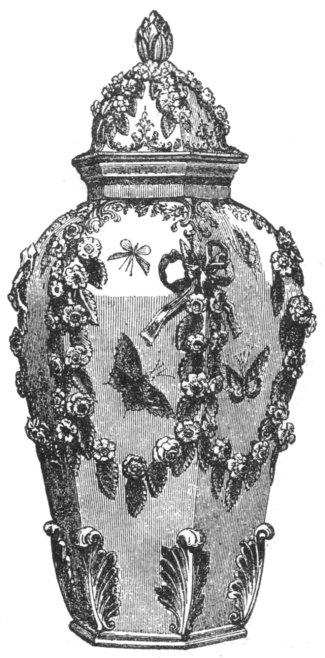
VASE (16 IN. HIGH), PLYMOUTH.
In the Fry Collection at Bristol.
We reproduce a fine specimen of a splendid vase, hexagonal shape, sixteen inches high, in the possession of the Fry family at Bristol. It is richly decorated with festoons of finely modelled raised flowers, with painted butterflies and borders. This was the forerunner of the exquisite Bristol vase made by the firm which bought Cookworthy’s life secrets.
Devon and Plymouth suggest Elizabethan days and one man’s name flashes uppermost, but—
But there are heroes of peace and the arts of peace and that art of all arts, the art of self-effacement and William Cookworthy is one.

PLYMOUTH MARKS.

BRISTOL PORCELAIN.
Under-glaze Mandarin Decoration in Blue.
For several centuries earthenware was made at Bristol, and a very fair quality of blue delft was produced there, but it is not of the old potteries of Bristol that we shall speak, but of the manufacture which was transplanted from Plymouth to Bristol. We have related the struggles of William Cookworthy to establish Plymouth porcelain. The strenuous efforts to perfect the china were carried on by Richard Champion, of Bristol, merchant, who bought Cookworthy’s patent, and established the manufactory of hard porcelain at Bristol. Champion had, it appears, been associated with Cookworthy as partner when the works were at Plymouth.
In 1775, when Champion presented a petition to the House of Commons to be granted the patent right for a further period of fourteen years to himself, he was vigorously opposed by Josiah Wedgwood, who represented that by granting a patent{98} to Champion, it would be detrimental to trade and injurious to the public, urging, among other grounds, that “the use of the natural productions of the soil ought to be the right of all.” Wedgwood presented a memorial to Parliament, and a fierce controversy ensued. “Much might be said on both sides,” as Sir Roger De Coverley observes, and much was said on both sides.
At first blush it seems hard that Cookworthy and Champion, who found the earth and worked hard at developing the manufactory in the West, should have no protection given to their secret. But Wedgwood, who speaks with authority, urged that when he invented his Queen’s Ware he did not apply for a patent, which would have limited its public utility. “Instead of one hundred manufactories of Queen’s Ware, there would have been one; and instead of an exportation to all quarters of the world, a few pretty things would have been made for the amusement of the people of fashion in England.”
Without going further into the details of a controversy which trenches upon questions of political economy two facts stand out, and the reader can judge of them as he will. The patent was granted by Parliament to Richard Champion, who was subsequently ruined, and left England to die in South Carolina; and secondly, hard paste was made at Plymouth and Bristol (never before or since in England), while the manufacture of the less difficult soft-paste porcelain and of pottery was carried on by the Staffordshire factories and Wedgwood.
During the struggle between Wedgwood and{99} Champion one curious incident occurred. When the Bill was before the House of Lords for discussion, one of Champion’s witnesses left London for Bristol without permission. As it was necessary to bring him back at once, as the end of the session was at hand, he was recalled by an “express,” which travelled the 240 miles to Bristol in twenty-seven hours!
In 1775 was passed (15 George III., cap 52) “an Act for enlarging the term of Letters Patent granted by his present Majesty to William Cookworthy, of Plymouth, Chymist, for the sole use and exercise of a discovery of certain materials for making Porcelain, in order to enable Richard Champion, of Bristol, merchant (to whom the said Letters Patent have been assigned), to carry the said discovery into effectual execution for the benefit of the public.”
So we shortly find the Bristol factory in full swing. The stock of Plymouth, and the tried workmen, were transferred to Bristol. First of all, attention was paid to common blue and white ware as likely to demand a ready sale, and to be profitable. As in the case of Worcester and other factories, Champion took Oriental models, and some of his ware is confounded with other makers who used the same models. The blue was of good colour, and dinner, tea, and coffee services, as well as jugs and mugs, were turned out, sometimes marked with the Bristol cross, but oftentimes without any distinguishing mark at all, to the confoundment of the latter-day collectors.
Bristol was very successful in imitating the commoner forms of Chinese ware. We reproduce a{100} teapot and cup and saucer. It will be observed that the cup follows the original model, and has no handle.
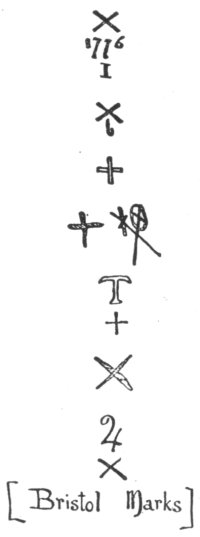
[Bristol Marks]
The usual mark of Bristol was a plain cross, sometimes in blue, sometimes in red, and often in neutral tint, or slatey-grey. The crossed swords of Dresden, accompanied by the Bristol cross and the figures 10, appear on one specimen.
Some of the following marks which we give have been assigned to Bristol. Figures sometimes occur as well as the cross; these are believed to denote the painters engaged on the piece, and are often marked in red. On one known Bristol piece, a date occurs. But to collectors of Bristol porcelain there is one test which also applies in more marked degree to the Plymouth ware; this is the series of spiral ridges which may often be observed on the surface of the ware when held in reflected light.
We have alluded to the somewhat heated controversy between Josiah Wedgwood and Richard Champion, who had transferred the plant from Plymouth and had applied for an extension of{101} Cookworthy’s patent to himself. Josiah Wedgwood, we think somewhat unfairly, alleged that both Plymouth and Bristol factories were still in an experimental stage; he belittles their art, which “neither the ingenious discoverer nor the purchaser, for want, perhaps, of skill and experience in this particular business, have been able, during the space of seven years already elapsed, to bring to any useful degree of perfection.”
This is not the place to enter into the merits of a dead conflict between Staffordshire and Bristol. That Bristol was not merely an experimental factory is more than proved by the specimens which have come down to us, specimens, be it said, that are more eagerly sought after than many of Wedgwood’s productions, since they are of hard porcelain which Staffordshire never made, and which hard paste has never again been made in England, either before or since.
One of the choicest examples of the highest art of Bristol is preserved in the national collection at the Victoria and Albert Museum. It is stated to have been “the best that the manufactory could produce.” It was made in 1774-5, within a few months of the establishment of the works at Bristol. This example is interesting too, as being one of the few examples of the Bristol works, of which the exact date can be ascertained.
In the year 1774 Edmund Burke was nominated for Bristol, the capital and richest city of the west. A fierce election contest followed, in which Burke was returned as one of the members. During this{102} election he was the guest of Mr. and Mrs. Smith, of Bristol, and it was then that Burke ordered a splendid set of china from Champion. We reproduce the cup and saucer of this service. It is profusedly and massively gilt in dead and burnished gold, the wreaths of laurel being in green, which was Burke’s electioneering colour.
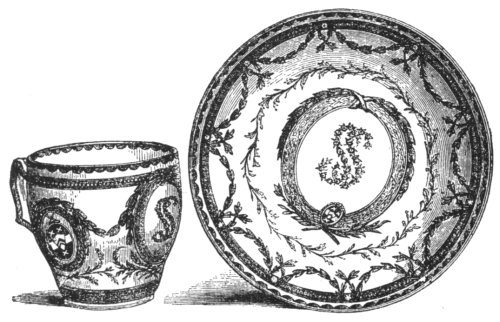
CUP AND SAUCER, BRISTOL.
From service ordered by Edmund Burke.
Each piece, as will be seen, bears the monogram of Mrs. Smith, “S. S.” interlaced, formed of wreaths of roses in pink and gold, and also the arms of the family. This service is marked with the usual Bristol cross.
It is obviously absurd to have asserted that such china was merely experimental. The collector of to-day has more than hall-marked Bristol porcelain.{103} Recently, at Christie’s Auction Rooms, £168 was paid for two small cups and a tea tray, and, alas! Cookworthy and Champion died unsuccessful men. If they are recognised to-day as martyrs to the ceramic art, their own generation were somewhat stiff-necked to their genius and enterprise.
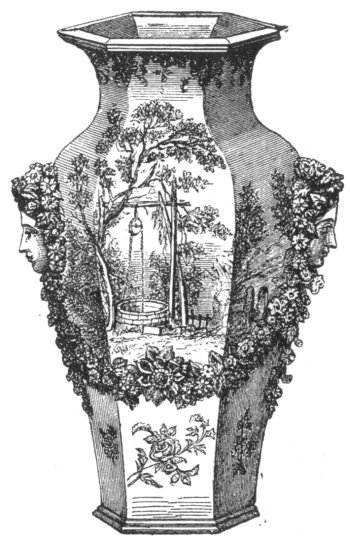
BRISTOL VASE (121⁄4 IN. HIGH).
In the Fry Collection.
The vase which we reproduce shows to what{104} perfection the manufacturers had reached. Among the decorators of Bristol was Henry Bone, afterwards an R.A., and miniature enameller to the Royal Family. Bone was apprenticed to Champion for seven years, dating from January, 1772.
This vase, in the possession of the Fry family of Bristol, is of hexagonal shape and is 121⁄4 inches in height. The landscapes are excellently painted, and it has well-modelled female busts on two of its sides, from which hang festoons of raised flowers in white. This vase and the other splendid and almost priceless vases in the possession of the same family are not marked. It appears that although only Champion’s name appears on the documents in connection with the Bristol factory, he had partners who assisted him financially, one of whom was Joseph Fry, whose only return, when the factory was discontinued, for the money he had sunk into the concern, was the set of vases now in the hands of his descendants.
We now come to the last act of Bristol. Wedgwood writes to Bentley in a letter, dated August 24, 1778, concerning Champion’s failure: “Poor Champion, you may have heard, is quite demolished; it was never likely to be otherwise, as he had neither professional knowledge, sufficient capital, nor scarcely any real acquaintance with the materials he was working upon. I suppose we might buy some Growan Stone and Growan Clay now upon easy terms, for they have prepared a large quantity this last year.”
His patent right was sold by Champion to a company of Staffordshire potters who continued the{105} manufacture at New Hall for some little time until the ordinary soft paste was allowed to supersede Champion’s hard paste. So ended the triumphs of Bristol and Plymouth. It appears that from November, 1781, to April, 1782, Champion left his native city to superintend the works of the china company who had purchased his rights. But Edmund Burke came to his rescue, and, conjointly with Burke’s son Richard, Champion was appointed deputy paymaster-general. Champion occupied official apartments in Chelsea Hospital. In July a change of ministry lost him his post, but in April, 1783, he regained it, only to resign on the fall of the famous Coalition Ministry in January, 1784. In October, 1784, he left England for South Carolina, where he became a planter. Seven years after leaving England he died of fever, and lies buried in the New World.
There is nothing to be said—his fate was the fate of so many enthusiasts and workers in the field of art. Nobody has ever unveiled a monument to Champion’s memory or to Cookworthy’s memory. Nobody has designed a stained-glass window to record their ceramic triumphs.[1] Their monument—and it is a lasting one—lies on the china shelf; the votaries of Plymouth and of Bristol porcelain need no spark to quicken their fire.
We know Browning’s “Waring” and his unfulfilled promise of greatness, and how the friend who has lost him, “like a ghost at break of day,” wishes him back—
And the world would call back its neglected and unrequited men of genius if it could, and herein lies the principle that makes china command high prices—these conscience-prickings are the tribute posterity pays.
Among special features of Plymouth and Bristol china, spiral ridges are to be seen, though often barely noticeable, running from the base transversely around the body of piece, more noticeable in basins and teapots, at an angle of 45°. The china of these factories is often untrue owing to imperfect firing, and is frequently cracked at base. The Bristol decorators had a partiality for wreaths and festoons of laurel in green, interspersed with detached bouquets of flowers. The Bristol glaze is rich and creamy white, and upon examination a series of minute depressions, somewhat similar to the bubbles on Oriental glaze, may be discovered.
| Plymouth. | £ | s. | d. |
| Bowls and covers, pair, formed as doves on their nests. Christie, February 5, 1902 | 7 | 7 | 0 |
| Shell sweetmeat-dishes, two, painted with flowers in colours in the Chinese taste, and encrusted with coloured shells and seaweed; and a smaller white ditto. Christie, February 5, 1902 | 5 | 5 | 0 |
| Tankards, pair, painted with birds, trees and flowers in colours. Christie, February 5, 1902 | 46 | 4 | 0 |
| Mug, bell-shaped, 51⁄2 in. high, painted exotic birds and continuous landscape in brilliant colours (marked with Plymouth mark). Edwards, Son & Bigwood, Birmingham, May 13, 1902 | 12 | 0 | 0 |
| Plymouth shaped Mug, painted with exotic birds and branches, and with gilt border, marked, 41⁄4 in. high. Puttick & Simpson, July 9, 1920 | 13 | 13 | 0 |
| Plymouth Mug, painted with birds and branches, 51⁄4 in. high; and a Plymouth Sauce-boat, painted with flowers in the Oriental taste. Christie, July 5, 1920 | 19 | 19 | 0{108} |
| Bristol. | |||
| Teacups and saucers, two, and a small tray, painted with medallion heads in gilt borders and festoons of green laurel-wreaths between; and a bowl and cream-jug nearly similar. Christie, February 4, 1902 | 168 | 0 | 0 |
| Teapot and cover and bowl, painted with bouquets of flowers. Christie, February 28, 1902 | 7 | 15 | 0 |
| Dishes, oval-shaped pair, painted with festoons and sprays of flowers, in colours, gilt edges. Christie, February 28, 1902 | 16 | 16 | 0 |
| Bowls, pair, fluted, painted with bouquets of flowers, 111⁄4 in. diameter. Christie, July 2, 1902 | 28 | 7 | 0 |
| Cabaret, decorated with festoons of foliage in green and horizontal gilt lines, consisting of oval plateau, teapot, sucrier and covers, milk-jug, and cup and saucer; mark, Dresden crossed swords. Christie, July 2, 1902 | 27 | 6 | 0 |
| Figures, pair, of a lady with tambourine, and a gentleman with a lyre, 11 in. high. Christie, June 10, 1902 | 52 | 10 | 0 |
| Figures, Mars and Minerva, 131⁄2 in. high. Christie, June 20, 1902 | 19 | 19 | 0{109} |
| Figure of a Nymph, allegorical of “Water,” 101⁄2 in. high. Christie, July 2, 1902 | 10 | 10 | 0 |
| Teacup and saucer, painted with portrait medallions, green laurel festoons, gilt lines, and the interlaced initials R. S. Part of service made by Champion for Sir Robert Smyth. From the Edkins Collection. Christie, June 16, 1903 | 37 | 16 | 0 |
| Bristol china Teapot and cover, decorated with birds on branches and insects, inscribed Mary Cowling, 1771. Sotheby, May 17, 1920 | 29 | 0 | 0 |
| Bristol china deep Dish, octagonal, with floral festoons, deep blue edge and centre, 83⁄4 in. Sotheby, May 17, 1920 | 3 | 6 | 0 |
| Two Bristol Plates, painted with festoons of flowers in colours on white ground, 8 in. diameter. Christie, July 5, 1920 | 9 | 9 | 0 |
| Bristol Plaque, painted with a bouquet of flowers, inscribed “J. Pardoe, Bristol,” 93⁄4 in. by 51⁄2 in. Christie, July 20, 1920 | 18 | 18 | 0 |
| Bristol figure of a girl, carrying a basket of flowers, 41⁄2 in. high. Christie, July 12, 1920 | 10 | 10 | 0 |
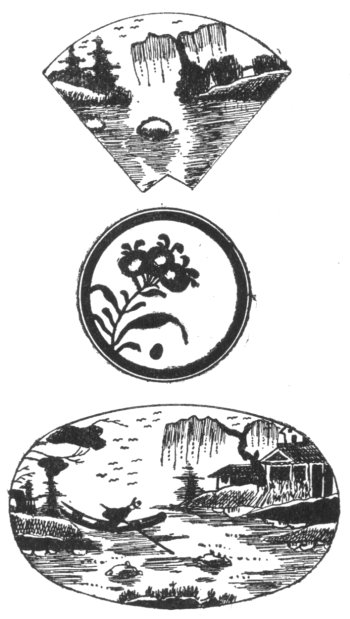
THREE PANELS FROM LOWESTOFT POWDER-BLUE OCTAGONAL DISH.
(Marked with imitation Chinese mark in blue.)
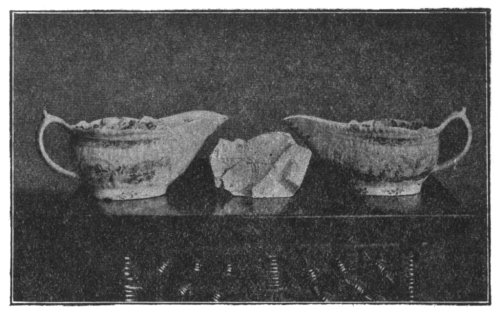
LOWESTOFT SAUCE-BOATS (BLUE and WHITE).
(With fragment of Mould from which they were made.)
VI
THE LOWESTOFT FACTORY
We have dealt with Worcester and with Derby, with Chelsea and with Bow. Of the latter, we told of the difficulty of determining the marks, and of accurately naming the china; but what are we to think of a factory, which we may term the “Mrs. Harris” among china factories, inasmuch as some people with no less scepticism than Sairey Gamp’s friend, believe it did not exist at all. The legends of Lowestoft are many and varied, but we think we shall succeed in presenting some sort of rational account of the factory to our readers, which may dispel many notions, perhaps wrongly, held by those to whom “Lowestoft” is a{114} myth and the collecting of it a snare and a delusion.

BLUE AND WHITE DELFT MARRIAGE PLATE, WITH INSCRIPTION.
(Dated 1755.)
It is stated that a Dutch sailor, wrecked on the coast, in return for the hospitality of a gentleman who brought him to his house, was instrumental in pointing out the value of the white earth which he discovered on the gentleman’s estate. It is certain that the sand on the coast of Suffolk at Lowestoft is of great purity, as compared with that of other parts of the country, and, when the Lowestoft works were closed, the Worcester factory availed themselves of it in making their best porcelain.
There are certain plates of reputed Lowestoft manufacture, dated 1752 and thereabouts, bearing the names of Quinton, of Yarmouth, Parrish, of Norwich, and other local families. These plates are of earthenware body, with coarse decorations in blue, and having a yellow rim. They were made to celebrate the marriage of the persons named on them. In the one we reproduce, specially photographed for this volume, the inscription runs: “Henrÿ and Marÿ Qu̓inton, Yarmou̓th, nor f f: olk. 1755.” This lettering, with the two dots over the letters y, and the peculiar placing of the commas over the letters u, is conclusive evidence that it was written by a foreigner, and presumably plates such as these were made in Holland to order of some shipmaster.
One of the owners of the original factory was Robert Browne, who died in 1771, when the management was undertaken by his son—also Robert Browne—who made great experiments in pastes. There is a story of how Robert Browne the second paid a visit to London disguised as a workman, and by secreting himself in a barrel, was enabled to watch the mixing of the ingredients forming the paste of Chelsea or of Bow.
The presence of coats of arms upon genuine known pieces of Lowestoft may have caused some confusion, which has continued to the present day. At the end of the last century a great deal of Oriental china was made having coats of arms of English families upon it. Although Lowestoft bore no resemblance in its body to Oriental ware, people came to suppose that, in some way or another, the ware was brought in its{116} unfinished state from the East, and then decorated and re-fired at Lowestoft. With the exception of Plymouth and Bristol, Lowestoft is the only factory in England which is credited with producing the true hard-paste porcelain, as made in the East; all other old English chinas are of soft paste, and a great deal of our wares are earthenware, for instance, Wedgwood. But the claim that Lowestoft made hard paste has never been substantiated by facts.
Lowestoft may be divided into two parts, the first dealing with the early period when blue and white ware was made, and the second period, when a finer and higher class of goods, with heraldic designs and floral intricacies, were introduced. At one period of its history the paste of Lowestoft appears to have been harder than that of Bow or Chelsea. Roughly, just a half of a century saw the rise and fall of Lowestoft. It was established from 1756, and in 1802 the factory had ceased.
Many families in the Eastern Counties to this day possess specimens of the Lowestoft china with names and dates painted on them. This china with names or initials upon it, or bearing a date, in addition to its personal value is of historic interest in determining periods of manufacture. We give a highly interesting and very rare pair of dated cups and saucers, with unusual decorations, vine leaves in gold, clusters of grapes in red, and tablet in centre with inscription, “M. and E. Calder, Norwich, 1776,” rich blue glaze and gold bands.
Among other dated specimens of Lowestoft white and blue ware is a fine bowl, with Chinese figures of{117} mandarins painted in blue, and inscribed at the bottom with the name, “Elizabeth Buckle, 1768.” This Elizabeth Buckle is known to have been an eccentric old dame, and the service, of which this bowl is a remnant, was made for her by her nephew, Robert Allen. This Allen was one of the worthies of Lowestoft. In 1819, in his seventy-fourth year, he executed a design for the East window of the Parish Church (we know not whether it is still in existence at Lowestoft). In acknowledgment of this service, a silver cup was presented to him, with the inscription: “A token of respect to Mr. Robert Allen from his fellow-townsmen of Lowestoft, for having, at the advanced age of seventy-four, gratuitously and elegantly ornamented the East window of their Parish Church. Ann. Dom. 1819.”
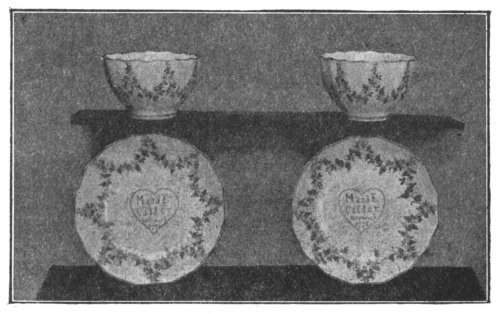
By courtesy of Mr. F. U. Yallop, Lowestoft.
OLD LOWESTOFT CUPS AND SAUCERS.
Red and gold decoration. (Dated 1776.)
After the closing of the Lowestoft works, Allen put up a small kiln at his own house, where he carried on operations on a limited scale. He bought the unfinished ware from Mr. Brameld, of the Rockingham factory, and painted it and refired it, selling it himself afterwards.

We reproduce a design of a mug painted by Thomas Curtis for his father and mother, whose names appear on it. It is said that Curtis was formerly employed at Dresden, and that he was a “silent partner” in the Lowestoft works. Many other examples of blue and white exist with dates and names upon them, and there is more than enough evidence to show that, short as was the history of the Lowestoft factory, it did good work.
We shall now proceed to give an account of the wonderful decorative qualities of a great artist in{119} Lowestoft china, whose works now are worth many pounds, but whose latter days, when he was blind, were spent in poverty.
We have dealt with the earlier ware made there—of the blue and white porcelain and of the delft ware probably made in Holland; we now come to the higher and finer products of Lowestoft, over which so many debates have taken place. It has been held that this ware was decorated at Lowestoft, but that it was real Oriental body imported in its half-finished state from the East, and only painted and re-fired in this country. However, on the signed testimony of one of the workmen, it is positively stated that no Oriental porcelain ever came into the factory at Lowestoft to be decorated. “No manufactured articles were brought there to be painted, and every article painted in the factory had been previously made there.”
The question, too, of hard paste being made at Lowestoft is now disproved; among all the recently discovered fragments is nothing of hard paste.
The theory that porcelain came over from China through Holland to Lowestoft, if it be examined, does not hold water. First, it would not have paid, especially as then a large duty existed on china imported, whereas Lowestoft china was produced at a fairly cheap cost, and supplied to the public to compete with Worcester, and Derby, and the Staffordshire makers. Again, when the Lowestoft factory broke up, there would naturally have been a lot of unfinished Oriental porcelain in its white state, prior to the decoration, thrown on the market. What became of{120} it all in 1802? Nobody ever seems to have seen any white china bowls, or white tea services, or white vases.
But there is a certain amount of mystery about Lowestoft, and a great quantity of ware exists both in this country and abroad, which is classed as Lowestoft china, but which is really Oriental porcelain with British armorial bearings.
In fact, the little factory has provided a considerable field for speculation as to what it did and what it did not produce. For so small a factory there is quite a literature in magazine articles, and one volume has been written upon it. The factory started about 1765, and closed down in 1802. When it closed its kilns and heaps of shards were hurriedly buried, it extinguished the hope of an art that promised to be greater. The abandonment of an art industry always breaks some hearts. There is just one fleeting glimpse of one of the old painters when teacups and roses were no longer wanted.
Perhaps some of our readers will look under the rose and read a story, sad enough, but true of many a craftsman at the end of the day. One old artist who, by your leave, ladies, painted red roses and twined chains of rosy wreaths, who put smiles and sunshine with his artful brush on to your tea services, had a very aching heart at the end of the journey. Fate herself twined a chain of grey roses for him. He was blind and poor. In his old age, he laboured, a broken-down old man, in the heat of the sun. A couple of donkeys given to him out of charity enabled him to bring water into Lowestoft. A{121} beggar, he would slake a beggar’s thirst. “Wreaths of roses”—there is something gruesome in the sound of the words. Handle your china cups with more tenderness: human lives have gone to the making of them. The white-hot furnace and the minute brush-mark of your rose petal turned a man’s day to dark night. Roses and wreaths of roses, and behind them all—tears.
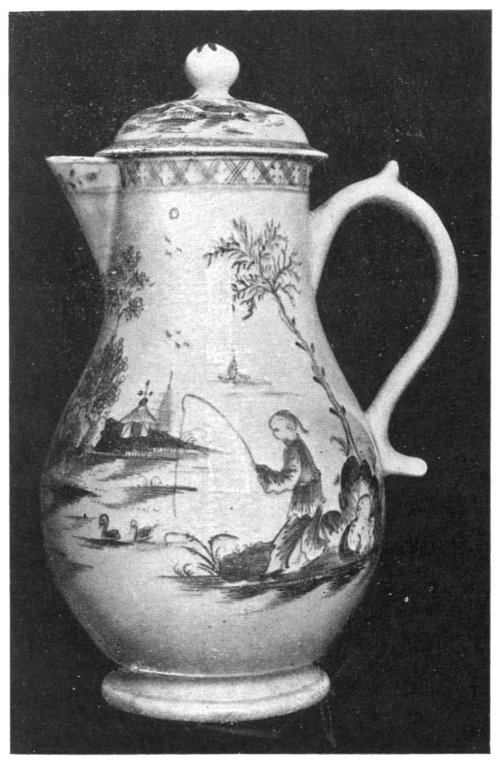
RARE LOWESTOFT COFFEE-POT.
Decoration in Oriental style in blue.
In the possession of Mr. Merrington Smith, Lowestoft.
The writer is able to confirm the above statements respecting Lowestoft by information which has been courteously supplied by a kinswoman of the celebrated designer of the bouquets of roses on the Lowestoft porcelain. The first clay was discovered by Mr. Luson of Gunter Hall in 1756 (now the estate of Miss Fowler), who sent a small quantity to London to ascertain its quality. Upon trial it was found to be excellent, and Mr. Hewlin Luson procured workmen and erected a temporary kiln on his estate near the old Warren Houses on the Dunes north of Lowestoft. A good deal of jealousy was aroused and trade rivals attempted to wreck the scheme and tampered with the workmen engaged. After a year’s struggle a company was formed who purchased some houses in Bell Lane, now Crown Street, and established a factory.
In December, 1902, an interesting discovery was made on the site of the old Lowestoft factory. The kiln for drying malt of Messrs. Morse, brewers, is actually the old kiln in which the Lowestoft ware was fired, and upon the flooring of this being removed to make a drain, several moulds and fragments of china were found. I am especially indebted for many{122} curious touches of Lowestoft colour and much information concerning this find to those present while the digging operations were going on.

Copyright.]
[A. Merrington Smith,
Lowestoft.
INTERIOR OF THE LOWER ROOM OF THE OLD LOWESTOFT CHINA FACTORY.
Digging for Moulds, July, 1903.
This important discovery led to a complete investigation of the old site, and, largely owing to the enterprise of Mr. A. Merrington Smith, of Lowestoft, steps were taken to commence excavations. These resulted, in July, 1903, in the further find of several bushels of broken moulds and fragments of china. We give an illustration of the scene when the moulds and fragments had been discovered.
Among these fragments are some decorated pieces ready for glazing, which cannot be washed, as the colours, of course, come off. There are glazed fragments in blue and other colours. There is quite a variety of handles for cups, mugs, &c., and there are cups made without handles. There are some birthday tablets, and some clay pipes with heraldic devices made for William Harvey, of Yarmouth. One small piece, evidently part of the bottom of a cup, has a crescent marked in blue; but this does not prove that Lowestoft used the crescent as a mark; in all probability it is the fragment of some Worcester piece they had for purposes of copying.
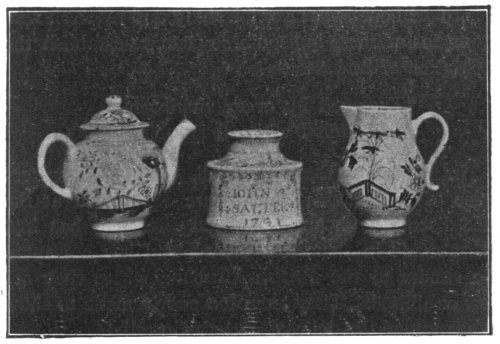
OLD LOWESTOFT (BLUE AND WHITE).
Toy Teapot and Cream Jug (2 in. high). Inkstand (dated 1791).
There are also unglazed fragments for basket-work,{124} and Lowestoft figures, unglazed, ready for firing. There are ribbed tea-cups and cups with cornflower decoration. Among other fragments are a great number of toy teapots and toy cups only an inch or two in height, decorated in blue. We give an illustration of this toy ware painted under-glaze in blue.
The bulk of these moulds and fragments are in the possession of W. Rix Spelman, Esq., of Norwich, and it is to be hoped that careful study and research will, by means of these indisputable facts, re-establish the reputation of Lowestoft—
Mr. Crisp, of Denmark Hill, London, possesses some of the moulds which were disinterred at the first discovery on the Lowestoft site. He has had china made in them and baked, and has presented the results to the British Museum, where they are now exhibited. They seem too poorly made to show to advantage the delicate patterns in relief.
The headpiece (p. 113) shows two sauce-boats, blue and white, with raised decoration. It will be seen from the fragment of mould, photographed with them, how exactly this newly discovered mould helps to identify the pieces.
Among the fragments is part of a teapot mould, on which is the date 1761. Chaffers, in his authoritative work on china, remarks of Lowestoft that some of the larger pieces bear traces of having been “made in a mould,” and here, just a hundred years after the factory ceased, comes corroborative evidence.
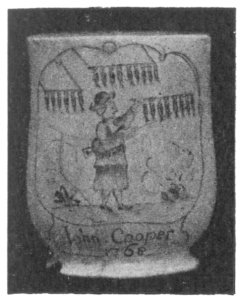
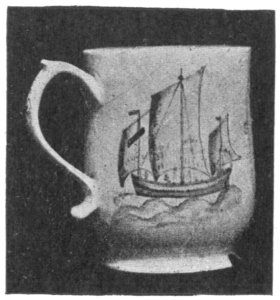
BLUE AND WHITE LOWESTOFT MUG (SOFT PASTE).
With fisherman drying herrings.
Inscribed “John Cooper, 1768.”
Reverse of mug.
With Lowestoft fishing smack.
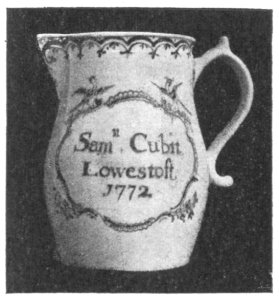
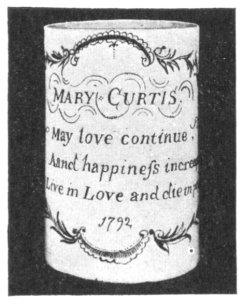
LOWESTOFT CHINA.
Jug, decorated with floral festoons at rim, and having medallion with inscription: “Sam Cubitt Lowestoft 1772.”
Mug, inscribed: “Mary Curtis.
May love continue
Aand happiness increase
Live in Love and die in peace
1792.”
Both decorated in blue overglaze.
There is an interesting mould for an oval perforated basket, such as Bow and Chelsea produced, with diamond spaces to be cut out; and upon one of the fragments of a mould for a sugar basin appears the most delicate tracery and exquisite designs in leaves and scrolls, and prominent among the decoration is the Japanese chrysanthemum.
All East Anglians and lovers of old Lowestoft will be pleased at this piece of new evidence in favour of the theories held concerning the old factory, whose reputation has been well-nigh blasted by thousands of spurious imitations made in France—literally covered by vulgar design and more vulgar coats of arms.
We are able to reproduce some genuine old Lowestoft. A remarkable piece is the old mug, about 6 in. high, depicting an old fishwife with bellows under her arm, and holding a spit of herrings. This is decorated in blue and white. On the reverse side of mug is a fishing boat. At the bottom it bears the name “John Cooper, 1768.” Under the scroll of the handle are the letters “R. P.,” probably signifying that it is the work of Richard Philips, a painter at the Lowestoft factory. Unfortunately it is damaged, as will be seen by the illustration, but for all that it is a specimen of considerable value. The jug we illustrate, having the “Mandarin” decoration common to Worcester and Bristol, is a fine example of Lowestoft under-glaze blue painting. It bears the figure 5 upon it as a mark. It may be observed that many of the Lowestoft pieces of blue and white bear a striking resemblance to old Worcester. At first blush one is{128} inclined to believe them to be Worcester, but the blue is not quite the Worcester blue, and the glaze tells its own story. There are pits and dimples, and little raised surfaces here and there, particularly under the bases of cups, that are characteristic of Lowestoft.

LOWESTOFT BLUE AND WHITE JUG (5 IN. HIGH).
(Marked with workman’s mark. Figure 5.)
“A Trifle from Lowestoft,” a legend which is a{129} familiar one on Lowestoft ware, is an inkstand, with floral design in that shade of red peculiar to Lowestoft but so difficult to describe in words. The decoration on this piece is especially characteristic of the factory, and we ask readers to make a note of it.
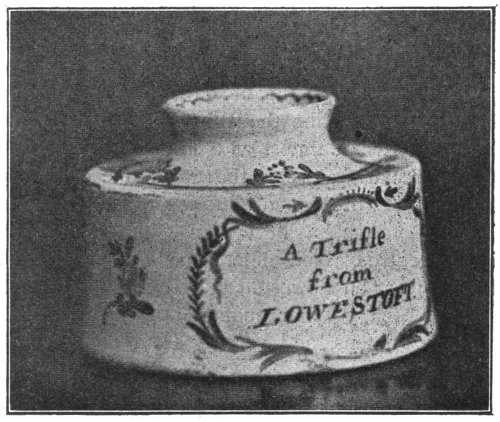
LOWESTOFT CHINA INKSTAND.
(Floral Decoration in Red.)
There are certain marks on undoubted Lowestoft
pieces which the writer has examined. The letter
“R,” which might be the signature of Redgrave the
painter. On another piece the letter “H” appears
under the rim, which may stand for Hughes. The
letters “R. P.” on the mug we illustrate (p. 125) may
equally stand for Richard Powles or Richard Philips.{130}
On one piece two L’s appear back to back (![]() ). Is
this Luson, Lowestoft? While on other pieces
appear the mark
). Is
this Luson, Lowestoft? While on other pieces
appear the mark ![]() in red and in blue.
in red and in blue.
The china is soft paste, and is often very badly potted. The blue is inclined to run. There is a gritty appearance in places on the glaze, which is spotted as if by sand. In some of the blue decorated pieces, where a flight of birds is introduced, the crescent moon (like the Worcester crescent mark) has been put in almost as a challenge to Worcester. One especial feature is the green hue of the glaze settled under the rims of saucers and basins and cups. The paste often has little bumps on it, and a mound in the centre of base under rim. Roses, set back to back, appear on Lowestoft pieces. The red of Lowestoft is of a peculiar quality, approaching puce in some specimens, and varying from mauve pink to carmine.
| Lowestoft. | £ | s. | d. |
| Bowl, 101⁄2 in., painted in flowers, with trees and cattle. S. Mealing Mills, Norwich, December 3, 1902 | 7 | 5 | 0 |
| Mug, decorated in blue, with figure holding spit of herrings. Fishing boats on reverse side, inscribed “John Cooper, 1768.” Signed “R. P.”—Richard Philips, a painter at Lowestoft. Messrs. Notley, Lowestoft, July, 1903 (illustrated p. 125) | 11 | 0 | 0 |
| Mug, painted in blue, with inscription—“Add to knowledge, temperance (Peter II), James Last of Saxmundham, 1769.” Christie, March 8, 1904 | 16 | 10 | 6 |
| Bowl, painted with pastoral subjects, in panels, foliage, scrolls in red, and inscription inside, dated 1774. Christie, April 8, 1904 | 26 | 5 | 0 |
| Bowl, large, painted with medallion views in brown and with ribands and foliage round the border in dark blue and gold. Diameter, 131⁄2 in. Christie, March 2, 1905 | 6 | 0 | 0 |
| Mugs, two, roughly decorated with blue, and inscribed below “Abim Moore, August 29, 1765.” Christie, April 7, 1905 | 5 | 5 | 0{132} |
| Lowestoft china, ten teacups and eight saucers decorated with border and sprays of flowers in crimson, red, blue, and green. Sotheby, May 17, 1920 | 5 | 0 | 0 |
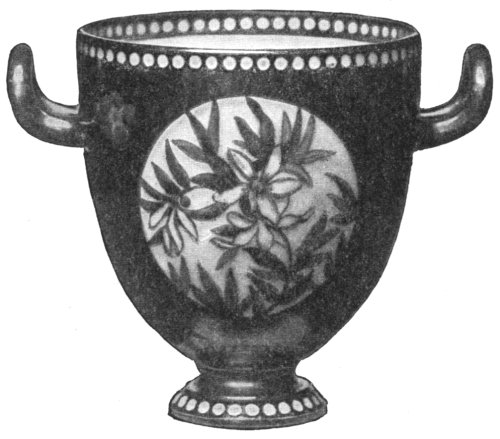
TWO-HANDLED CUP, RICHLY GILDED, WITH BLUE AND WHITE PANELS. COALBROOKDALE. MARKED CBD.
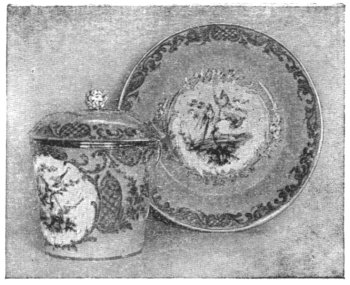
COVERED CUP AND SAUCER, OLD COALPORT. IN SÈVRES STYLE.
VII
COALPORT
The history of Coalport porcelain manufactured in Shropshire on the banks of the Severn is worth the telling, and those readers who are possessed of specimens of the older ware issuing from this factory will be glad to hear of its first beginnings.
Unlike some of the other great manufactories, Coalport, we are happy to say, is still in existence. Bow and Chelsea, Nantgarw and Swansea, Bristol and Plymouth have disappeared. The potter’s wheel is silent, and the brush of the artist has been laid aside for ever. Long since the potters have turned into clay themselves. At Bow, where the exquisite ware was produced on the banks of the Lea (“New Canton,” as the manufactory styled itself), a match factory stands on the old foundation. Instead of{136} delicate and fragile cupids they now make matches, but of the kind more associated with Lucifer than with Cupid.
With Derby and with Worcester, Coalport can boast that it was established in the middle of the eighteenth century. Indeed, there is evidence that the Salopian china made in Colebrookdale is taken from the same beds of clay which fifteen hundred years ago supplied the Romans with material for their white ware, for their jugs, their mortaria, and their bowls, which are constantly being unearthed at various spots in the valley of the Severn.
The site of the first works was at Caughley, where a small pottery was begun about 1754. Early in its history the names of Brown, Gallimore, and Turner occur. In my “Chat” on the great Worcester factory I showed that Dr. Wall was the leading spirit who infused life into the concern, and it would appear that Thomas Turner was in some measure induced to emulate him, and it is seen on comparison that the early examples of Caughley were very similar to those of contemporary Worcester. The patterns were principally confined to blue flowers and decorations on a white ground. From 1756 to 1776 the manufactory attained a great excellence. There exists a mug bearing the date 1776, and the name “Francis Benbow.” There is a nautical ring about the name. One recollects Admiral Benbow and his gallant deeds; our Francis Benbow was a bargeman, for whom the mug was made, but his name will go down to posterity on this Caughley mug, as it is the most perfect specimen of its kind.
We give a reproduction of this mug, and readers will observe the anchor marked over the name, and we would call especial attention to the nature of the decoration upon the mug. Dated chinas of old manufacture are specimens very worthy of notice, as they are much sought after, and in many cases are being reproduced with the old dates upon them.
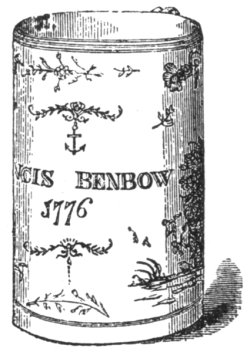
CAUGHLEY. OLD BLUE MUG.
(Inscribed and Dated 1776.)
The excellence of Turner’s porcelain and the invention of the beautiful dark blue of the Caughley china, attributed to him, brought the factory into great prominence. But great secrecy was employed in its manufacture, and the place hidden away in the hills was an ideal spot for a manufactory wishing to be self-contained and free from prying strangers. In 1780 was produced the celebrated “Willow Pattern,” which is in demand even at the present day, and has been copied by all the other manufactories.{138} The “Blue Dragon,” another favourite pattern, originated at Caughley, and it was here that the first blue-printed table service was made in England. It was made for Thomas Whitmore, Esq., of Apley Park, near Bridgnorth, the pattern was called the “Nankin.” It is interesting to note that Thomas Minton, of Stoke, assisted in the completion of this service, being articled as an engraver there.
Until the end of 1790 Messrs. Chamberlain, of Worcester, had their porcelain in the white from Thomas Turner, of Caughley. As an instance of the great secrecy employed by Turner, we may say that he used to mix all the bodies himself, but afterwards instructed his sister how to do it. It may add an additional zest to your old white and blue Caughley ware to know that a woman who could keep a secret was intimately associated with its manufacture.
In 1780 Turner, who had paid a visit to France to study the foreign methods, brought back with him a number of skilled artists and workmen. About this time, too, Mr. John Rose, who had learned the art of pottery under Turner, left him to establish a factory of his own at Jackfield. Jackfield, it may be noticed in passing, is one of the oldest potteries in the country. As early as 1560 entries occur in the parish registers of Stoke-upon-Trent of potters “from Jackfield.” In a disused coal mine here, some years ago, a brown mug was found which bore the date 1634. Jackfield was noted for some of its black decanters of superior glaze, and up to quite a modern date made a yellow glazed earthenware.
Finally, the competition between Mr. Rose and the old Caughley works became so great that the old factory was swallowed up by the new one, and Coalport became the headquarters and the name of the firm became John Rose and Company, Mr. Turner withdrawing from the business.
The exact dates are as follows: Between 1780 to 1790 John Rose established his works at Coalport (he was only at Jackfield for a few years). He carried on these and the Caughley, which he purchased in 1799, up till 1814, when Caughley was finally discontinued.

All these are very dry facts which you must master in order to understand the specimens on your china shelf. There is an additional interest, it always seems to me, in knowing of the men and women who gave their lives to the perfection of an industry. There are in existence portraits of Thomas Turner and his wife, and we should particularly like to see the likeness of the lady who secretly mixed the chinas. Perhaps some of our readers may come across some family in Shropshire who may possess them.
With regard to marks, unfortunately not all the specimens of Caughley were marked. The above are some of the varieties of the crescent occurring on some of the ware, and show pretty clearly the transition from a half-moon to the engraved C. The word “Salopian” is sometimes impressed, and on one known specimen is the name “Turner.” Various forms of the letter “S,” sometimes with a cross, are used.
At the beginning of the nineteenth century the written name “Coalport” was used, though not extensively, and another mark, the letters “C. D.,” standing for Colebrookdale, was also used, but somewhat sparingly.
In 1820 both Swansea and Nantgarw factories were incorporated with Coalport, and Messrs. Billingsley and Walker, well-known names in the history of English china manufacture, came to Coalport. In 1820 Mr. Rose received the gold medal of the Society of Arts for his Felspar porcelain, and this date is a turning point in the history of Coalport.
At this time Coalport began to establish a reputation for its excellence, which placed it on a level with the other great manufactories—a reputation, be it said, that has increased as time has gone on. We reproduce a handsome vase of Coalport manufacture, richly decorated with pink and gold, on a blue ground. Its elegant form is typical of the ware at its best period.
At the present moment the productions of Coalport, both old and modern, are unequalled in their domain. The old traditions of the firm are still{141} maintained, and the ware of to-day is of the highest possible artistic merit and excellence.
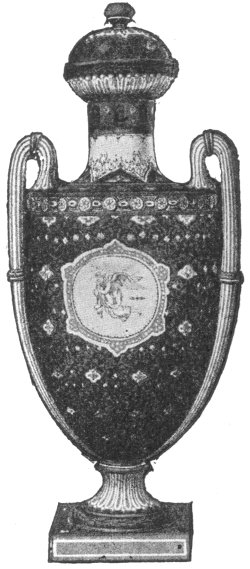
COALPORT VASE.
(Blue Ground, richly Decorated in Pink and Gold.)
By the kindness of the proprietors of the Coalport manufactory, we are enabled to give some further account of the modern ware, and to reproduce illustrations of the later marks used and of the sumptuous plates turned out at the present day from Iron Bridge, in Shropshire.
In the year 1820, the first year of the reign of George IV., Mr. John Rose obtained the gold medal of the Society of Arts for his “improved glaze for porcelain.” At this time a mark was adopted on some of the ware, “Coalport Improved Felspar Porcelain,” enclosed in a wreath of laurel. Surrounding the wreath are the words “Patronised by the Society of Arts.” The name “I. Rose and Co.” is marked underneath. If any of our readers have any porcelain having this mark, they will notice how good is the paste and how excellent the glaze.

Just prior to the mark above alluded to, the word Coalport was used and sometimes the letters “C. D.”—standing for Cole-Brook-Dale. Other marks of a later date are a monogram formed of the letters “C. B. D.,” and the same enclosed in a circle with the word “Daniell, London,” an eminent firm acting as agents and connected with the sale of the ware in London. This firm had depôts in Bond Street and in Wigmore Street, and there is in the national collection a plate with bleu-de-roi ground, enriched with gilding, one of a service executed by command of Her Majesty the late Queen Victoria for presentation to the Emperor of Russia. This service was exhibited at the Great Exhibition of 1851. In the centre of the plate is painted the Order of St. Andrew, while the body{143} is ornamented with Russian orders painted on ivory-coloured ground in six compartments.
We now come to a very curious mark which may have puzzled some of our readers, but which is easily explained. It is a scroll somewhat like that which stands for the word “and”—&. Within its curves appear the three letters “C. S. N.” Upon examination it will be found that the aforesaid curves really make two letters, viz., “C. and S.,” which stand for Coalport and Salopian, while the other three letters stand for Caughley, Swansea, and Nantgarw—the whole emblematical of the development of the manufactory and its absorption of the smaller factories.
We give an illustration of the various marks placed in order of date used, up to and including the one now in use by the firm. Our readers may be able to form some idea by comparison of the dates of their specimens.

LATEST COALPORT MARKS.
It must be observed that much of the earlier Coalport was unmarked, while—we blush to have to print it—some of the ware imitated the double “L” mark of Sèvres, and the “C” and anchor of Chelsea and the crossed swords of Dresden, so successfully as to delude the unwary collector. The celebrated egg-shell{144} porcelain of Coalport ranks among the most marvellous china ever produced in this country. It is rarely marked with any letters or signs, but it carries upon it a signature of perfection of manufacture and exquisite symmetry of design such as no other factory dared emulate, and no other factory has since approached. These tiny cups and saucers (the cup follows Chinese models by having no handle) are gems of ceramic art, and happy is the collector who can number one or two good specimens in his china cabinet.
The well-known “Willow Pattern,” first manufactured here, is from a Chinese model. It is still manufactured by the Coalport Company, and is one of their stock patterns. It appears on a list of some forty patterns, which can be and are manufactured without the use of lead.
Readers may find the words “Leadless Glaze” on some of their quite recent purchases in modern china. The terrible effects of lead on the workpeople in china factories is a subject which has received the attention of Parliament (see p. xxiii). But in passing it is highly satisfactory to find that the Coalport Company turn out, without special order, forty patterns entirely “leadless.” Any one who is specially desirous of having “leadless glaze” on any other of the Coalport ware may do so by ordering it.
To come down to the very latest marks, there are three that have been in use. The first in the seventies, the second in the eighties, and the last, now solely used, was adopted some twelve years ago with the{145} addition of the word “England” to meet the requirements of the American Tariff Act, which made it compulsory for foreign goods to be thus stamped.

OLD COALPORT VASE.
(Decorated in pink and white. Marked CBD.)
The first has the words “Salopian, Coalport,” in a scroll, which has within it the old mark of Caughley, a crescent with “A.D. 1750” beneath it, and in addition the letters “C. S. N.,” in scroll as before alluded to, and having the date, “A.D. 1790,” underneath. This is a very complicated mark, and is not generally known.
The second is a crown with the word “Coalport, A.D. 1750,” underneath. The third is the same with the addition of the word “England.”
In conclusion we may quote the fact, to give our readers some idea of the quality of the ware now being exported by the Coalport Company, that some of the dinner ware sent to America costs no less a sum than £5 per plate, while there are even more sumptuous and magnificent specimens of their manufacture which cost £15 each plate. One of these, amongst others, is a plate with a coloured design painted after Sir Joshua Reynolds’ celebrated portrait of Mrs. Robinson.
Caughley.—The early pieces, printed in under-glaze blue, resemble the early Worcester blue and white; but Caughley is whiter in appearance, and the blue has not the mellowness of old Worcester. Introduction of “Willow pattern,” and similar designs, and the “Broseley dragon.”
Coalport.—“Chantilly sprig,” “Tournay sprig,” “Worm sprig,” introduced by Billingsley from Pinxton. A maroon ground, introduced by Walker from Nantgarw about 1822. The deep mazarine blue of Derby, reproduced at Coalport, is quite equal to Derby pieces in tone. The rich ground colours of old Sèvres porcelain were copied with great success at Coalport, particularly the turquoise blue and the rose-du-Barri.
| Caughley. | £ | s. | d. |
| Tea and coffee service, fluted, flowers in blue and gold and dark blue and gold borders, 31 pieces. Christie, January 30, 1902 | 7 | 7 | 0 |
| Vases, pair, 14 in., decorated with raised flowers and gilt, and choicely painted in birds and Watteau subjects. Gudgeon & Sons, Winchester, April 3, 1902 | 15 | 10 | 0 |
| Coalport. | |||
| Bowl and cover, two-handled, encrusted with branches of coloured flowers and foliage, 11 in. high. Christie, April 4, 1902 | 16 | 5 | 6 |
| Coalport vase, with gilt decoration on turquoise ground, 101⁄2 in. high. Christie, July 5, 1920 | 17 | 17 | 0 |
| Pair of Coalport vases and covers, painted with panels of flowers in gilt scroll borders on dark blue ground, the covers surmounted by figures of children with garlands of flowers, 17 in. high. Christie, July 20, 1920 | 40 | 19 | 0 |

COPELAND VASES.
Cobalt-blue ground, painted panels of Flowers and Landscapes. Raised border, richly gilded.
Reproduced by courtesy of W. T. Copeland & Sons, Stoke-on-Trent.
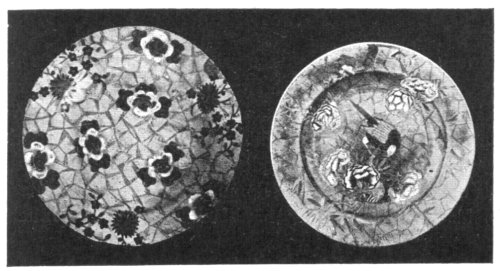
SPODE EARTHENWARE PLATES.
(May-blossom on dark blue ground, and tropical bird and flowers on canary yellow ground.)
In the Collection of the Author.
VIII
SPODE AND HIS SUCCESSORS
The chain of potters is complete from the day on which Josiah Spode was apprenticed to Whieldon in 1749. The entry in the old account book runs: “1749, April 9th. Hired Siah Spode, to give him from this time to Martelmas next 2s. 3d., or 2s. 6d. if he deserves it, 2nd year 2s. 9d., 3rd year 3s. 3d.” The successors to Spode, Messrs. Copeland, have done much to develop the manufacture of English porcelain in the nineteenth century, and at the present day they are producing china of the highest excellence.
The first Josiah Spode established a factory at Stoke-upon-Trent about 1770. Some of his earliest productions bear the name “Spode” impressed in the paste. Those of my readers who have blue willow-pattern{152} plates with this mark upon them are the possessors of some of the first plates of that pattern made. About 1780 the willow pattern was introduced by Turner at Caughley, and very shortly afterwards, in 1784, Josiah Spode was turning out at Stoke his blue printed plates. Some of his china is printed in black, and pieces of this black printing are much sought after by collectors, but they must bear the word “Spode” impressed on them.

OLD SPODE PASTILLE-BURNER.
(Red body with black ornaments in relief.)
At Victoria and Albert Museum.
The vase which we reproduce from the collection at the Victoria and Albert Museum is a pastille-burner having perforated cover; it is mounted on tripod stand formed by three dolphins on triangular base; it is red in colour and ornamented in black in relief. It has the impressed mark “Spode,” and is earthenware,{153} but we give it here on account of its fine form.
On the death of old Josiah Spode, in 1798, his son Josiah continued the business, and commenced the manufacture of porcelain, which he improved by the addition of bone-ash and of felspar. He died in 1827, and was succeeded by his cousin, Josiah Spode. This third Josiah Spode died a few years afterwards, at which date the name Spode practically disappears from the firm.
Josiah Spode the second was the most successful potter of his day. It is pleasing to be able to record that he acquired a considerable fortune—a lot not often within the reach of potters, successful or otherwise.
About the year 1805 he introduced a fine ware which he termed opaque porcelain. This ware became very popular and was of excellent manufacture. While Nelson was fighting the French at Trafalgar, and breaking their naval pretensions, Josiah Spode was inflicting a commercial blow upon that unhappy country. Spode—and in his wake came other Staffordshire manufacturers—inundated France and other countries on the Continent with this new stone china of his, which entirely superseded their fayence. This injury was a very real one to the poor potters of France, inasmuch as a great number of them had to abandon the manufacture.
We have already alluded to the impressed mark Spode or SPODE. On some of the finer pieces the name is painted in red, and sometimes it is written in gold, as in our third mark in an angular hand, running{154} upwards. The stamped mark usually in red, “Spode’s New Fayence” and “Spode Stone China,” appears on the ironstone ware. Oftentimes the mark is not stamped on the middle of the plate underneath, but at the side, while sometimes the name is both stamped and impressed. Besides the marks we give there are more than half a dozen other forms used by the factory, but all of them containing the word “Spode,” and therefore not presenting difficulties to the collector.
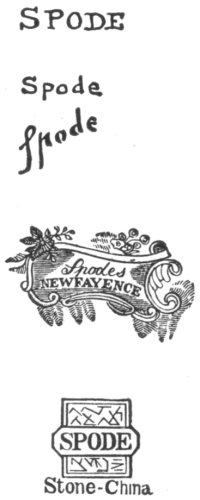
SOME SPODE MARKS.
Of three marked Spode plates in possession of the writer, of typical Spode decoration, which was largely influenced by Japanese art, we give two as a headpiece. It will be observed that the left-hand plate in the headpiece, which has a vivid blue background, is fretted with a geometric pattern as a design. This is intended to represent ice, and the may-flowers of the covering decoration are intended to convey, by the Chinese artist who invented it, the symbolic meaning of young love being chilled by adversity. The other plate in the same illustration is of a brilliant canary-coloured ground, covered with a gossamer-like network of cobwebs, above which bird and flowers are painted.
The third plate shows very strongly the influence of the East in its method of decoration; but instead of pagoda and delicate curves, the English artist has almost brutally placed a piece of European architecture on the other half of the plate, which by its incongruity mars the remainder.
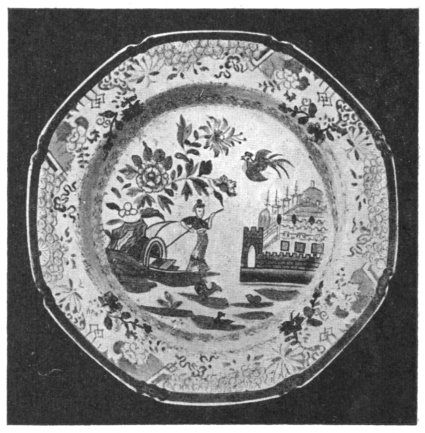
SPODE PLATE.
(Decorated in blue and red and gold.)
In the Collection of the Author.
We must turn aside from Spode, and introduce our readers to his successors, the Copelands. One word in passing. Those who have specimens of Spode ware will do well to remember that his was a great factory, not so well known as Derby and Worcester,{156} but a formidable rival of theirs. Not many months ago at Christie’s a pair of Spode vases, square shaped, decorated with landscapes, birds and flowers in the Chinese style, forty-two inches, brought £21.

MARKS OF MESSRS. COPELAND.
The list of marks used by Messrs. Copeland will show at a glance the changes in the title of the firm. In 1833 the firm became Copeland, late Spode, and the china was marked accordingly.
There are a good many other marks besides those we give, but all are more or less similar, with slight variation to those we produce. A word of explanation is necessary as to the mark “C. and G.” This is frequently accompanied by the words, “New Blanche,” “Royal Opal,” “Saxon Blue,” or “New Japan Stone,” according to the composition or decoration of the ware.
About the date of the International Exhibition of 1861, many purely English novelties were attempted. Mistletoe, holly, and simple popular designs were then in favour and were produced. Nobody could possibly mistake the homely robin or the holly-wreath decoration for that of any other country than ours. There is a suggestion of roast beef and plum-pudding and Christmas{157} fare. All purely English art is homely, whether it be the Staffordshire potter’s farmyard quadrupeds that adorn the cottage mantelshelf, or the old blue{158} dinner services of our great grandmothers. It is a debatable point if that is the highest art, but there it is. Ruskin would have had some hard things to say about it, and maybe William Morris preferred the potsherd of an Italian shepherd. The fact remains that it is our art, and whatever we may in our innermost hearts wish it to be, we have to take it and study it as we find it.
Before leaving the subject of these later and more modern chinas we may say, in passing, that the firm of Messrs. Copeland have done more than any other existing firm to maintain the traditions of a great factory. They have adhered to early designs, and all through the nineteenth century their record has been an exceedingly high one. It was Messrs. Copeland who first introduced, in 1845, their Parian ware, a very near approach to true porcelain. The writer has seen a Copeland and Garrett plate which in appearance was fully equal to Derby at its best period.
Spode ware is well potted, and feels to the touch like turned ivory. It can readily be distinguished from any of the glassy porcelains. It is light in weight. In design it follows Japanese more than Chinese models. The glaze is very even and smooth.
| Spode. | £ | s. | d. |
| Vase and cover, octagonal-shape, decorated with flowers in Oriental taste in colours and gold, 24 in. high. Christie, January 14, 1902 | 5 | 15 | 6 |
| Vases, five, purple, crimson, and gilt decoration. Foster, January 9, 1902 | 9 | 5 | 0 |
| Basket and cover, dark blue and gold ground, and painted with bouquets of flowers. Sotheby, February 24, 1902 | 6 | 2 | 6 |
| Dishes, two, oblong shaped, decorated in the Japanese taste, blue, red, and gold. Hepper & Sons, Leeds, February 5, 1902 | 3 | 15 | 0 |
| Spill-vases, pair, gold ground, painted in flowers. Hepper & Sons, Leeds, February 5, 1902 | 2 | 0 | 0 |
| Cake-plates, three, gilt and painted landscapes, “The Church and Castle of Scurlogstown, Co. of East Meath,” “The Remains of Wolvesey Castle,” and “The Bridge and Priory, Newtown, Co. of East Meath” (marked “Spode”). Edwards, Son & Bigwood, Birmingham, May 13, 1902 | 10 | 10 | 0 |
| Dessert service, apple-green border, gilt, each piece painted in flowers{160} and fruit, consisting of one tall compôte, seven oval dishes, four leaf-shaped ditto, two sauce-tureens, covers and stands, and seventeen plates. Bennett & Son, Dublin, June 18, 1902 | 27 | 10 | 0 |
| Dessert service, decorated in Oriental colourings, 37 pieces. Brady & Sons, Perth, September 1, 1902 | 16 | 16 | 0 |
| Dinner set, decorated with sprays, leaves, and flowers, comprising 119 pieces. Brady & Sons, Perth, September 1, 1902 | 25 | 0 | 0 |
| Dinner set, decorated in scarlet, blue, green, and gold, comprising 133 pieces. Brady & Sons, Perth, September 1, 1902 | 45 | 0 | 0 |
| Tea service, gilt and decorated, 45 pieces. Jabez Jones & Sons, Preston, December 15, 1902 | 28 | 7 | 0 |
| Vases and covers, pair, large square shaped, decorated with landscapes, birds and flowers in the Chinese taste in sunk panels on dark-blue ground, gilt with foliage, and with dragon handles in high relief and figures on the covers, 42 in. high, on wood pedestals, painted white. Christie, December 19, 1902 | 21 | 0 | 0 |
| Pair of Spode pastille-burners and{161} covers, painted with flowers in the Chinese taste on dark blue ground, supported by three gilt dolphins, on triangular bases, mark in red, 7 in. high. Puttick & Simpson, July 9, 1920 | 6 | 6 | 0 |
| Set of three Spode vases, gilt with foliage scrolls on dark blue ground, and with scroll handles, outlined with gilt. Puttick & Simpson, July 9, 1920 | 5 | 15 | 6 |
| Copeland. | |||
| Vases, set of three, rich blue, gilt, white scroll handles, and painted in colours, with wild flowers, centre vase 15 in. high, side vases 131⁄2 in. high (marked “Copeland & Garrett, Felspar Porcelain, late Spode”). Edwards, Son & Bigwood, Birmingham, May 13, 1902 | 26 | 0 | 0 |
| Dessert service of 24 pieces, pink ground, decorated with gold, the centres painted in panels of hunting and other sporting scenes, each different, marked “Copeland and Garrett,” centre compôte, two oblong, two oval, and four circular side dishes, and fifteen plates. De Rome & Son, Kendal, May 13, 1903 | 18 | 0 | 0 |
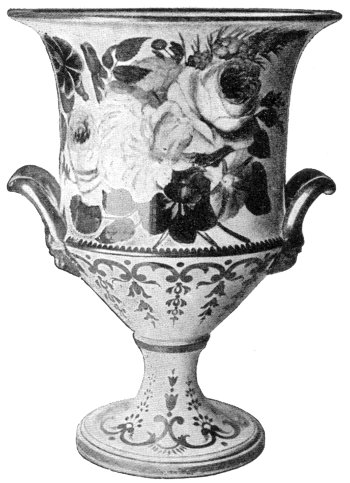
SWANSEA VASE.
(With flowers painted by Billingsley.)
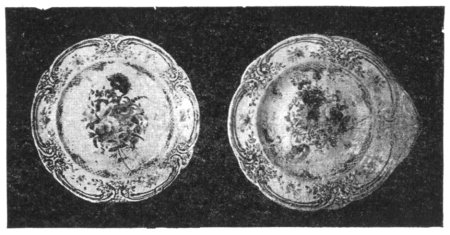
NANTGARW PLATES.
Richly decorated in colours and gilded.
IX
NANTGARW AND SWANSEA
The history of these two factories in Wales is bound up together. Billingsley, the chief flower-painter of Derby, was the founder of the little factory at Nantgarw, a small village a few miles north of Cardiff.
His was a restless, roving career. In other “Chats” we have alluded to him. Apprenticed at Derby under Duesbury, he left there in 1796, to commence the manufacture of porcelain at Pinxton. In 1801 we find he had left Pinxton and was engaged upon the decoration of Staffordshire porcelain at Mansfield, in Nottinghamshire. He is next described as “of Torksey,” which is near Gainsborough. At Worcester he engaged himself under Messrs. Flight and Barr, and was employed on flower-painting from 1808 to 1811.
Billingsley was known as “Beeley” at this time. Monetary difficulties had compelled him to take precautions against his arrest for debt. About this time, too, together with his son-in-law, Samuel Walker, he appears to have visited the Coalport{166} Factory and erected a new kiln, the invention of Walker.
Of late, a considerable interest has been shown in the porcelain of Nantgarw and Swansea. Collectors have ascribed to it artistic qualities greater than those of Worcester or Derby. The lovers of Nantgarw, and those connoisseurs who collect this and no other porcelain, will not admit that it is in any way inferior to the greatest factories that have existed in this country, and compare it to Sèvres.
Recently at Christie’s Auction Rooms a dessert service of Nantgarw manufacture brought £128 2s. Each piece was painted with a bouquet of flowers in the centre, the borders with raised white scrolls, painted with birds and flowers. This service consisted of centre dish, on feet, four square-shaped dishes, two-leaf shaped dishes, seventeen plates and two small plates. This works out at nearly £4 15s. each piece.
At another London auction room, seven Nantgarw plates, painted with birds and bouquets of flowers in border, all with impressed mark, in December last brought under the hammer, £97, which is nearly £14 each plate! After this it is useless to deny that Nantgarw is a factory which must be reckoned with from a collector’s point of view.
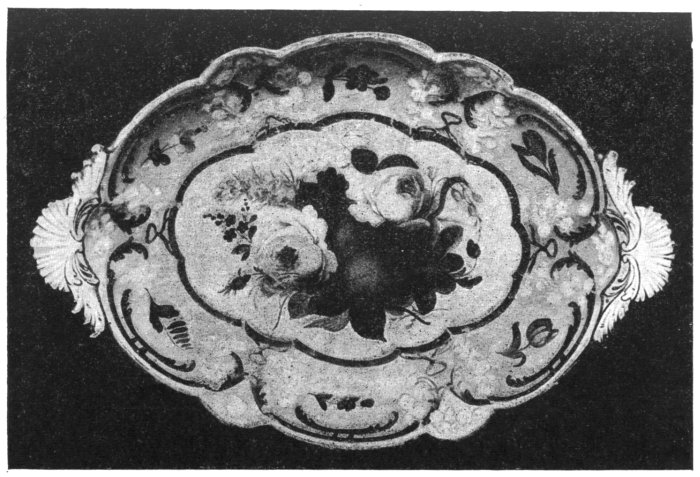
NANTGARW DISH (12 IN. IN LENGTH).
Marked “Nantgarw, C. W.”
(Pink ground; raised white floral sprays; richly gilded scrolls. The centre white, with handsome fruit and flower piece painted by Billingsley.)
Great stress has been laid by those who affect the collecting of Nantgarw on its whiteness and transparency. By its detractors this is said to be its fault—that it is too white and too cold to compete with the older productions of the better-known{169} factories. Of course only experts come to blows on this matter. Whether it is too glassy and too cold, and lacking the mellow warmth of the older glassy porcelains, matters little to the modest collector who desires to have Nantgarw represented in his or her scanty collection.
It may be observed in passing that the distinguishing feature of Nantgarw is the elaborate painting of flowers and fruit on the pieces manufactured there. We reproduce a beautiful Nantgarw dish, marked “NANTGARW. C. W.,” with pink ground, having garlands of raised white flowers bound with a knot, and encircled with richly gilded scrolls. The centre is white, with a handsome floral piece from the brush of Billingsley. The roses are exquisitely drawn, such as no other ceramic artist ever drew them; and the pear, of a warm, luscious brown, has all the bloom of the natural fruit upon it.
Mr. Dillwyn, of the Swansea works, has left us an interesting memorandum concerning the proprietors of Nantgarw. He says:—
“My friend Sir Joseph Banks informed me that two persons, named Walker and Beeley, had sent to Government, from a small manufactory at Nantgarw (ten or twelve miles north of Cardiff), a specimen of beautiful china, with a petition for their patronage, and that, as one of the Board of Trade, he requested me to examine and report upon that manufactory. Upon witnessing the firing of a kiln at Nantgarw, I found much reason for considering that the body used was too nearly allied to glass to bear the necessary heat, and observed that{170} nine-tenths of the articles were either shivered, or more or less injured in shape by the firing. The parties, however, succeeded in making me believe that the defects in their porcelain arose entirely from imperfections in their small trial-kiln, and I agreed with them for a removal to the Cambrian Pottery, at which two new kilns under their direction were prepared. While endeavouring to strengthen and improve this beautiful body, I was surprised at receiving a notice from Messrs. Flight & Barr, of Worcester, charging the parties calling themselves Walker and Beeley with having clandestinely left an engagement at their works, and forbidding me to employ them.” This was in 1814, and it was in the same year that Billingsley and Walker entered the service of Mr. Dillwyn at Swansea and commenced to make the beautiful china, highly decorated and of exquisite finish.
In concluding our remarks on Nantgarw we may observe that this factory was not finally abandoned till 1820. From 1812 to 1814 is its first period, when Billingsley and Walker and Young (of whom we shall have more to say later) were all at Nantgarw. Its second period is when the trio appear there again from 1817 to 1819. Billingsley and Walker then left for Coalport, and Young carried on the works till their close.
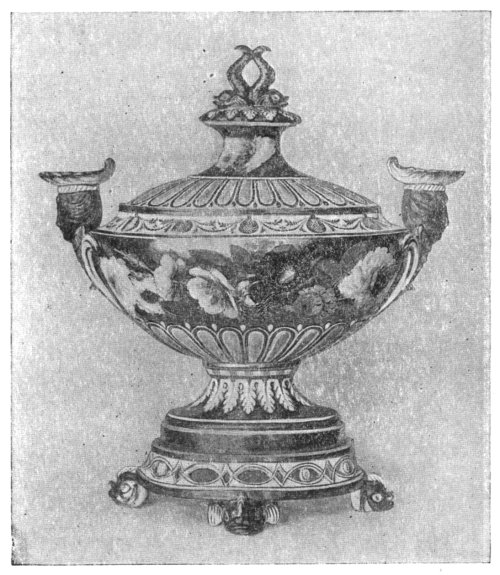
FINE SWANSEA VASE AND COVER. HEIGHT, 141⁄2 IN.
(Richly decorated and gilded. With exquisite flower painting.)
The only marks that appear on the china are the word “Nantgarw” with the letters “C. W.” underneath, which in all probability meant China Works, but which by some collectors are said to denote the name of the artist. This is impressed{171} in the china. Sometimes the word “Nantgarw” is found in red, but this must be regarded with suspicion, as a great many forgeries have been perpetrated in this china owing to its rarity and the favour which it finds with collectors.
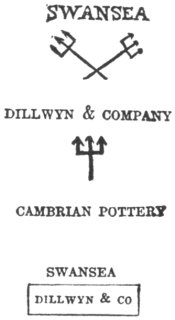
Swansea has a more extended history. In the middle of the eighteenth century a small manufactory of earthenware existed here. This gradually grew into the “Cambrian Pottery,” which, at the beginning of the nineteenth century, passed into the hands of Mr. Lewis Weston Dillwyn, a Fellow of the Linnæan Society and author of works on botany.
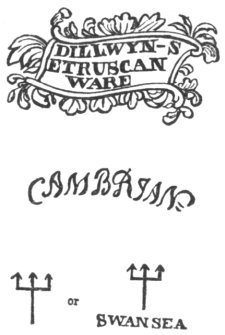
Before Mr. Dillwyn’s day a fine opaque china was produced at Swansea, but under his management and guidance the china assumed a more artistic appearance.
W. W. Young, whom we spoke of as having come over from Nantgarw, was especially skilful at painting flowers and birds, butterflies and insects, and sometimes shells. Some of the pieces of Swansea{172} bear his name upon them. Young was also employed by Mr. Dillwyn to illustrate his works on botany and natural history.

SWANSEA PLATE (8 IN. HIGH).
Marked “Swansea,” in red.
(White ground, finely decorated with red roses.)
Besides Young and the two Nantgarw flower painters and decorators, there was at Swansea Baxter, who was considered one of the cleverest painters on china of his day. He came originally{173} from Worcester and eventually returned there. Some of the subjects from the canvases of Sir Joshua Reynolds were successfully copied by him. Baxter was at Swansea for three years, and while there{174} decorated a service with garden scenery in the style peculiarly his own. There was Morris, a clever fruit painter, and Beddoes, a noted heraldic painter, and, above all, Billingsley, the first flower painter of his day.
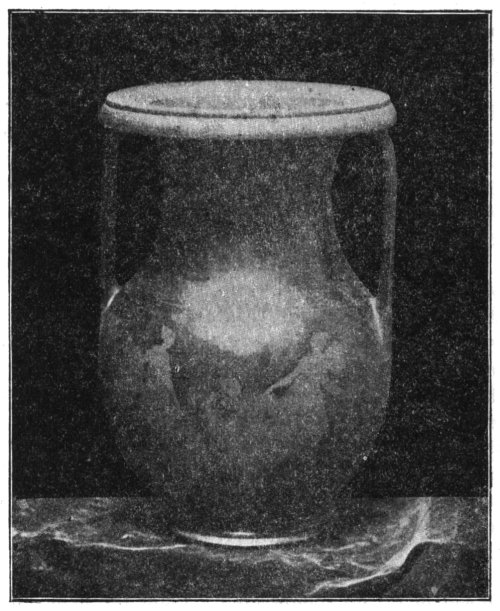
SWANSEA VASE.
Stamped “Dillwyn’s Etruscan Ware.”
In Collection of Mr. W. G. Honey.
About the year 1820 the Swansea factory was discontinued and the whole of the moulds and appliances were transferred by Mr. John Rose to Coalport. Since that date no china has been made at Swansea. Some of the marks that we give are of a later date than 1820, and are upon earthenware.
Among the marks of Swansea will be seen the oblong mark stamped on “Dillwyn’s Etruscan Ware.” This ware was introduced in 1848, and was of a fine rich red body. On this was printed, in black outline, Etruscan figures, borders, and other details. The general surface was then painted over, with the exception of the figures and designs within the black outlines. The result was that the figures were left the original red of the body and the effect was extremely good. The illustration we give is of a specimen in Mr. W. G. Honey’s collection, late at the Cork Exhibition.
The older pieces stamped with the above-mentioned mark are sought after. Later the name and title of the firm changed and passed into the hands of Messrs. Evans & Co. Besides the manufacture of white, and blue and white china, they supplied Ireland and the West of England with agate earthenware, and a good deal of it found its way to America. No trade-mark was used by them.
Nantgarw porcelain is of very fine texture; it has a glassy appearance, and when held up to a strong light, such as an incandescent electric globe, it exhibits a number of small bubbles, like pin-holes, in the body. It is inclined to have the glaze cracked in parts with a network almost like Chinese crackle ware. Some of the thinner pieces will be found to be not quite true, being slightly warped or bent, owing to its uncertainty in the kiln.
Swansea china is frequently decorated with birds, butterflies, and shells, drawn from nature by W. W. Young. Much of it is of a glassy nature like Nantgarw; but later the Swansea ware was of a duller, heavier nature, and having a hard white appearance.
| Nantgarw. | £ | s. | d. |
| Plates, seven, painted with birds, bouquets of flowers in border, all with impressed mark. Foster, December 4, 1902 | 97 | 0 | 0 |
| Dessert service, each piece painted with a bouquet of flowers in the centre, the borders with raised white scrolls painted with birds and flowers, consisting of centre dish, on foot, four square-shaped dishes, two leaf-shaped dishes, seventeen plates, two small plates. Christie, January 23, 1903 | 128 | 2 | 0 |
| Plate, painted with border of stippled gold and roses, the centre painted with a pastoral landscape, figures and sheep, exhibited at the 1851 Exhibition. De Rome & Son, Kendal, May 13, 1903 | 27 | 16 | 6 |
| Plates, pair, painted with groups of flowers, in gilt borders, and birds in centre; impressed mark. Sotheby, May 4, 1903 | 33 | 0 | 0 |
| Plate, the centre with three roses, and the rim with rose festoons on a dotted gold ground, impressed mark. Sotheby, May 17, 1920 | 18 | 0 | 0 |
| Pair of Plates, painted with flowers{177} and fruit, and the borders moulded with scrolls in relief, impressed mark. Christie, July 20, 1920 | 26 | 5 | 0 |
| Swansea. | |||
| Jug, painted with bouquets and wreaths of flowers and gilt, and with a shield of arms, 10 in. high; and a pair of plates with a wreath of flowers, impressed mark. Christie, February 18, 1902 | 17 | 6 | 6 |
| Jug, moulded with leaves, and with flowers and butterflies in green and colours, 103⁄4 in. high. Christie, February 5, 1902 | 8 | 8 | 0 |
| Dessert Service, painted with cornflowers and with gilt edges, consisting of centre dish, on foot; eight oblong, four shell-shaped and four octagonal dishes; pair of sugar tureens, covers and stands; thirty plates; eighteen small plates. Christie, November 21, 1902 | 65 | 2 | 0 |
| Swansea china covered Porringer and Saucer, finely decorated with flowers in natural colours on a dotted gold ground. Sotheby, May 17, 1920 | 14 | 0 | 0 |
| Swansea Dessert Service, painted with named flowers with gilt foliage and{178} trellis work round borders, consisting of pair of sugar-tureens and covers, four octagonal dishes and twelve plates. Christie, July 5, 1920 | 25 | 4 | 0 |
| A pair of Swansea small vases, painted with panels of flowers on dark blue ground, richly gilt, and with swan handles, 7 in. high. Christie, July 20, 1920 | 22 | 1 | 0 |

MINTON VASE.
Mazarin blue ground, raised and chased gold scrolls. First half 19th century.
(By permission of Messrs. Mortlock, Oxford Street.)
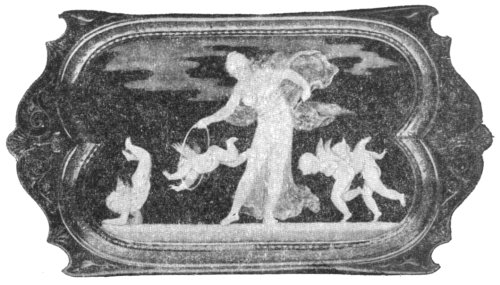
MINTON DISH, pâte-sur-pâte, BY M. L. SOLON.
By courtesy of Messrs. Minton & Sons.
X
MINTON
Messrs. Minton, of Stoke, in Staffordshire, manufacture pottery, porcelain, and majolica. By this latter, that massive ware, of bold design and bolder ornamentation and positive colours, principally blues, yellows, and greens, Minton’s at the Paris Exhibition of 1855 created quite a sensation, and won universal admiration.
Ten years before the commencement of the nineteenth century Thomas Minton established his factory at Stoke-upon-Trent. Only earthenware was manufactured at Stoke Works up till 1798, chiefly ordinary white ware, ornamented with blue, in imitation of Nankin china. From about 1799 down to 1811 a semi-transparent china was also made, but was abandoned as unprofitable. In 1817 Mr. Minton’s two sons entered the firm. In 1821 the manufacture{182} of china was again resumed; about this time, too, a very marked improvement was noticeable in Minton’s printed earthenware; the body was whiter, and the glaze was more highly finished.
We give the two early marks of the firm down to 1837. These were usually in blue, and very often had a number underneath. In these earlier examples the flowers and other decorations were painted. They very shortly became mostly printed designs, except in elaborate pieces, and the personal character of the ordinary china grew, in consequence, of less interest.

[Minton and Boyle
1837]

[1851.]
Sometimes “M. and C.” (the C. standing for Company), with an impressed stamp “BB.” or “BB. New Stone,” occurs. BB. signifies “best body.” A design of passion-flowers printed in blue is a favourite subject.
In 1836 Mr. John Boyle was admitted a partner, on the death of Thomas Minton; the firm became then Minton and Boyle, and the marks were accordingly changed. After continuing for five years Mr. Boyle went over to the Wedgwoods.
Mr. Minton was subsequently joined by his nephews, M. D. Hollins and Colin Minton-Campbell. The second Minton seems to have been of considerable{183} business ability. In his father’s day fifty hands were employed at Stoke, but in his time the factory employed no less than 1,500. The various branches he developed were earthenware, and ordinary soft{184} porcelain, hard porcelain, parian, coloured and enamelled tiles, mosaics, Della Robbia ware, majolica, and Palissy ware.
It will be seen from the accompanying illustrations how highly decorative Minton porcelain is. The vase we reproduce was one of the most admired specimens of china in the Paris Exhibition of 1867.
What is known as the ermine mark (the dark trefoil with the three dots), either indented or painted in gold and colours, has been used on porcelain since 1851, and since 1865 the word “Minton,” impressed, has been used for both china and earthenware.
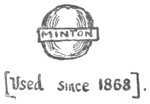
[Used since 1868].
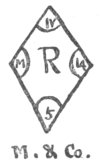
M. & Co.
In 1868 the globe, with the word “Minton” across it, was first used, and all the firm’s works subsequent to that date are so stamped. In 1872 the design was registered, and frequently a rhomboidal stamp occurs either without or in addition to the globe mark, which has the letter R in the centre, denoting that the particular pattern of china is “Registered” as a design. This rhomboidal mark occurs on chinas other than Minton’s, and is a feature of modern china.
“Minton, Hollins & Co.” are a firm at Stoke largely engaged in manufacturing encaustic and majolica tiles. They are an offshoot of the main branch.
The illustration we give of the lion ewer is a fine example of Minton’s reproduction of the celebrated{185} Henri II. faïence. This wonderful ware is of distinct character and ornamentation, differing from every other kind of pottery. It was made at Oiron, in France, from 1524 to 1550. There are less than one hundred known pieces. Five pieces are in the Victoria and Albert Museum. Two are in the Louvre. Some of the pieces are valued at over £3,000 each. Who shall say that there is no romance in old china and pottery when vases and ewers, tazzas and salt-cellars, have pedigrees as long as a race-horse’s, and whose whereabouts are as well known as that of a reigning prince?
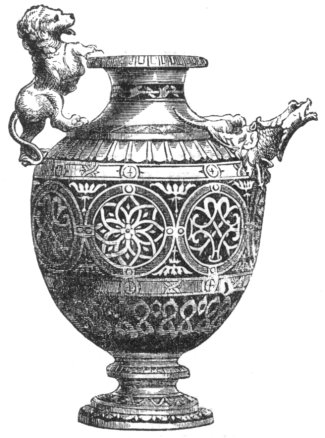
MINTON. LION EWER.
Reproduction of “Henri II. Ware.”
The plaque of painted majolica is a good specimen of what Minton can do. It was made about 1865, as was the lion ewer alluded to on p. 184, and the candelabrum is also of the same period. There is a fine fountain executed in Minton majolica; it is 36 feet high and 39 feet in diameter. At the summit there is a group, larger than life size, of St. George and the Dragon. It was one of the features of the International Exhibition of 1862; it now embellishes the scanty grass plot in front of the Bethnal Green Museum.
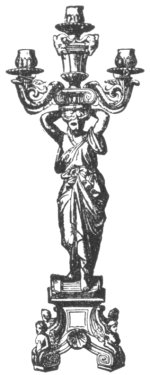
MINTON. PORCELAIN CANDELABRUM.
Some fine old Sèvres pieces have been copied by Mintons, and great fidelity has been shown in reproducing the old ground colours of rose-du-Barri, gros-bleu, turquoise, and pea-green. Chinese porcelain has been imitated with especial success. The most notable artistic achievement is the pâte-sur-pâte work, by M. Leon Solon. The coloured background is worked upon in white clay, and the delicate modelling of figures in this material is of great artistic beauty. Each result is a personal creation of the potter which cannot be duplicated.
| Minton. | £ | s. | d. |
| Vases, pair, gold wreath handles, with panels of Cupids in gold and pink on an ivory ground, 161⁄2 in. high; and a vase nearly similar, by A. Birks. Christie, January, 1902 | 42 | 0 | 0 |
| (These first nine items were from the Colin Minton-Campbell Collection.) | |||
| Vases, pair, and covers, nearly similar, with fruit in the Oriental taste on brown ground, by A. Green, 46 in. high. Christie, January, 1902 | 15 | 4 | 6 |
| Vases, pair, beaker-shaped, painted with lilies and grasses in colours and gold on dark-blue ground, richly gilt, by Leroi, 33 in. high. Christie, January, 1902 | 33 | 12 | 0 |
| Vases, pair, with Cupids and flowers in white and colours on black ground, in coloured and gilt borders, by L. Birks, 33 in. high. Christie, January, 1902 | 63 | 0 | 0{188} |
| Vases, pair, oviform and covers, the bodies encircled by four shaped medallions in relief, suspended by gilt cords and oak foliage, alternately painted with camp scenes in the Moran School and trophies-of-arms, apple-green borders; the ground of the vase gros bleu with marble decoration in gold, the whole executed in the style of old Sèvres, by Boullemin and Leroi, 21 in. high. Christie, January, 1902 | 162 | 15 | 0 |
| Cup and saucer, with panels of figures, vases and festoons of drapery in white on a sage-green ground, by Solon. Christie, January, 1902 | 11 | 0 | 6 |
| Candlesticks, pair, decorated in grisaille and gold in the taste of Limoges enamel, 12 in. high. Christie, January, 1902 | 6 | 6 | 0 |
| Dish, on pedestal, with a figure of Fortune in white on sage-green ground, by Solon, 111⁄4 in. diameter. Christie, January, 1902 | 17 | 6 | 6 |
| Jardinières, pair, fan-shaped, with panels of figures and exotic flowers in colours on a Rose-du-Barry ground, painted in the taste of old Sèvres, by Leroi, 7 in. high. Christie, January, 1902 | 63 | 0 | 0 |
| Vases and covers, pair, Solon ware, by Minton, with Classical figures and Cupids in arabesque borders, in white on a sage-green ground, richly gilt, 15 in. high. Christie, April 17, 1903 | 22 | 1 | 0{189} |
| Pair of Minton pilgrim bottles and stoppers, decorated with Cupids in white on blue medallions, in the manner of Solon, on pink ground richly gilt, 91⁄2 in. high. Christie, July 5, 1920 | 7 | 7 | 0 |
| Minton Sèvres pattern vase and cover, painted with panels of flowers and trophies on green ground, 15 in. high. Christie, July 5, 1920 | 9 | 9 | 0 |
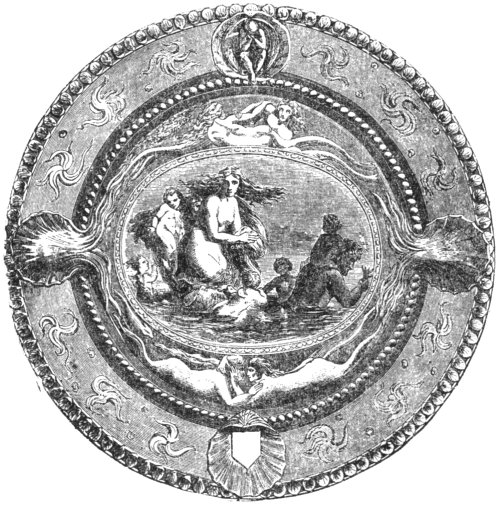
MINTON. PAINTED MAJOLICA PLAQUE.

BUST OF PRINCE RUPERT.
Made by John Dwight in Fulham Stoneware about 1671.
At British Museum.
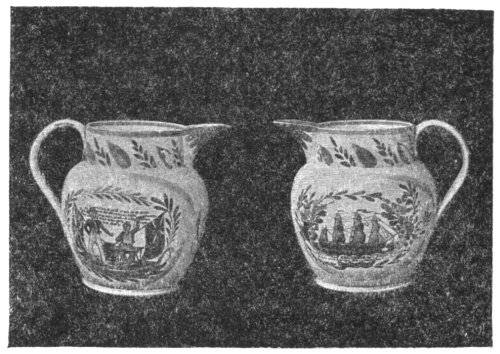
W. G. Honey.]
[Cork.
SUNDERLAND JUG.
(Two positions.)
XI
OLD ENGLISH EARTHENWARE[2]
It requires a word of apology for including the following “Chats” on earthenware in a volume bearing the title “Chats on English China,” but as the chief end of this little volume is to render to the beginner such aid as may be useful in the determination of the various classes of china, it was thought desirable in his interest to treat somewhat generally of earthenware in this and the succeeding chapters.
Earthenware suggests pots and pans, and the word is redolent of kitchen smells, but a Wedgwood teapot{194} or a Toby jug, though earthenware they be, are worth the having. Pottery is the poor relation of porcelain. The one comes in silks and satins, in purple and fine linen; the other in cotton gown, like Phyllis at the fair.
The following remarks may lend a zest to dusting days, and, mayhap, the poor relation may be invited to come down from the top shelf in the kitchen to occupy a niche in the drawing-room.
It is to be hoped that what has already been said on china may have created a taste in the reader for the inventions of the potter. A blue bowl may convey a world of meaning, and may be fragrant with memories of the eighteenth century, if one cares to peer beneath the surface. To the uninitiated it will be a blue bowl—and ugly maybe at that. To some the potter’s art is as dead a thing as was Nature’s message to Wordsworth’s insensate:—
That it is not always easy to determine where a piece of china may have come from we have already shown, even if it be “A Present from the Crystal Palace.” The ordinary mind may possibly imagine some hitherto unknown factory away at Sydenham, but the legend “Made in Germany” underneath instantly dispels that illusion.
It is necessary here to state that the world of bric-à-brac is divided into two parts—earthenware or{195} pottery, and china or porcelain. All that is not earthenware is porcelain, and all that is not porcelain is earthenware. One may liken it to prose and poetry; what is not one must be the other, as Monsieur Jourdain discovered after he had spoken prose for forty years without knowing it. To continue the simile, some of Ruskin’s prose writings approach as near to poetry as do Wedgwood’s finer wares to porcelain.
Porcelain is produced by the artificial mixture of certain minerals known by their Chinese names of kaolin and petuntse, or their English ones of china-clay and felspar. The former is infusible under the greatest heat, the latter is not, but unites in a state of fusion with the china-clay, making a paste or “body,” which is hard, and, when broken, shows a smooth, vitreous fracture. Those who have attempted to mend old china must have noticed how different the broken surface is from that of pottery with its rougher edges.
Strictly speaking these “Chats” on earthenware ought to have appeared at the commencement of the volume, for earthenware comes first chronologically. In passing we will glance for a moment as to how porcelain came into Europe.
Porcelain was first invented by the Chinese some two centuries before Christ. It reached Europe as the Eastern civilisation penetrated to the west, and for hundreds of years vain attempts were made by potters to reproduce the fineness of porcelain with its beautiful glaze and hard paste. At Venice, at Florence, in France, and in Spain, during the sixteenth{196} and seventeenth centuries, an approximate success had been arrived at; soft paste had been developed to its furthest limit, but the real ingredients of the Chinese hard paste were unknown.
Accident, however, completed what centuries of industry had attempted. From perruque to porcelain seems a far cry, but the story is worth telling.
John Schnorr, an ironmaster, riding near Aue, observed that a soft earth adhered strongly to his horse’s hoofs. Considering that this earth might be used as a substitute for wheat flour as hair powder, he carried some away with him, and it was subsequently sold in large quantities for this purpose at Dresden, Leipsic, and other places. This kaolin (the base of hard paste) continued to be known as “Schnorr’s white earth.”
Johann Friedrich Böttcher, chemist to the Elector of Saxony and King of Poland, discovered the secret about 1709. One morning, on taking up his wig, he noticed it was much heavier than usual. He was informed by his valet that a new kind of hair-powder had been used. This was the ironmaster’s white earth. Böttcher was convinced that he had discovered at last the base of porcelain.
This was the foundation of the manufacture of porcelain at Meissen, and the factory then established has supplied the world with Dresden china ever since.
So great was the secrecy at first, that Böttcher and his assistants, when Charles XII. of Sweden invaded Saxony, were removed by the Elector for greater safety to the castle at Königstein, where they were practically imprisoned. Even the clay was sealed up{197} in barrels by dumb persons, and every workman was required to take a solemn oath not to reveal the secret. “Be silent unto death” was the motto of the establishment.
How the method of manufacture and the secrets of Meissen finally became known to other countries, and how manufactories came to be set up at Vienna and Petersburg, is one of the romances of trade.
So much for the early history of porcelain in Europe. During this period the art of the potter had not made very great progress in England. These “Chats” have shown of the heroic attempts to emulate the success of Meissen, but it was slow, uphill work to reach the heights of Worcester and of Derby in porcelain and of Wedgwood in earthenware.
Stoneware mugs were more in accordance with the taste of our forefathers than pewter pots for drinking purposes, a comparatively modern prejudice. A variety of mugs called Longbeards, largely imported from Low Countries, were in general use during the sixteenth and seventeenth centuries at inns for serving all the customers. The name “Bellarmine” was sarcastically given them in reference to the cardinal most conspicuous in opposing the Reformed faith in the Netherlands, the potter representing, with grotesque art, his Eminence with short stature and rotund figure.
It is but a short step from the ware imported from the Low Countries to the pottery of Staffordshire. The celebrated pattern of the Toby jug is well known. Dickens, in “Barnaby Rudge,” makes Gabriel Varden ask Dolly to “put Toby this way.” Uncle Toby{198} himself might have suggested the design, but it is said to be derived from one Toby Philpot, “a thirsty old soul as e’er drank a bottle or fathomed a bowl.” We give, from Mr. W. G. Honey’s collection at Cork, two fine specimens—one an old Staffordshire jug (101⁄2 in. high), representing John Bull, and marked{199} “I. W.”; the other, the well-known pattern of the Vicar and Moses (91⁄4 in. high). This latter is the work of Ralph Wood, of Burslem, and was frequently reproduced by later potters. Both these pieces are blue and white.
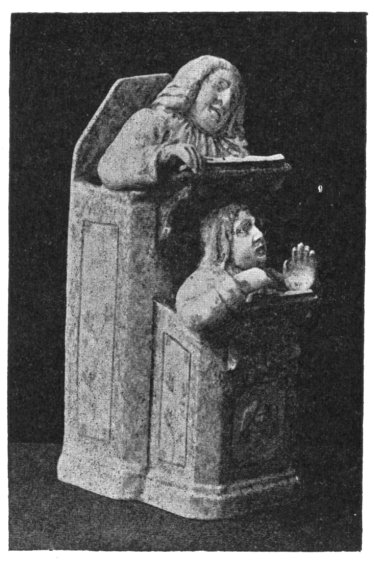
W. G. Honey.]
[Cork.
THE VICAR AND MOSES.
Blue and white (91⁄4 in. high).
Of Josiah Wedgwood, the English Palissy, we deal in a separate “Chat.”
A whole volume could be written about him and his work. His busts, magnificently produced in black basalt, his cameos and gems, with which the name of Flaxman must be coupled, his white terra-cotta, and his cream-coloured earthenware, known as Queen’s ware (first made for Queen Charlotte), may be ranked among the most important factors in the history and development of the potter’s art in England.
Of the most important of the other Staffordshire potters, perhaps the name of Spode is the best known. After 1798, Spode the younger commenced to make porcelain.
Concerning Liverpool, to which we devote a separate “Chat,” it seems remarkable to read that in 1754 the making of pottery was the staple manufacture of the city. “The blue and white earthenware almost vie with china,” so says an eighteenth-century journal.
John Sadler conceived the idea of transferring prints from copper on to pottery, and struck out a new line in printing on earthenware.
Another factory, called the “Herculaneum Pottery,” was started on the Mersey side by Messrs. Abbey and Graham in 1794. The making of china was started here in 1800.
About the end of the eighteenth century, a potter named Absolon had works at a place called “The Ovens” at Yarmouth. The work consisted of decorating the articles which were manufactured elsewhere, and very little more is known about it.
At Swansea both pottery and porcelain were made. In 1750 works were established, and in 1790{201} “Cambrian Pottery” became quite well known. In the early part of the next century a superior kind of ware, called “Opaque China,” was made.
Leeds pottery is well known. At one time it had quite an extensive Continental trade, and the pattern-book of the pottery was issued in several languages. Alas! now it is the French and the German and the Japanese pottery books that are issued in several languages.
It is largely cream-coloured ware and such articles as candlesticks, teapots, mustard-pots, cruet-stands, tea-canisters, and sugar-basins, with covers, together with the usual dinner and tea services, that were manufactured.
Bristol claims to have made pottery at a period as remote as Edward I. Wherever excavations have been made in the city, along the north bank of the river from Bristol Bridge to Redcliffe Pit, remains of pottery and shard heaps have been discovered.
Joseph Ring, in 1787, successfully imitated the Queen’s ware of Wedgwood and the best Staffordshire pottery. Ring’s cream-ware is thin and well made, the edges being remarkably sharp, and the fluted pieces very regular and well defined. It is generally yellower than either Wedgwood’s cream-ware or the Leeds pottery. Both of these have coloured bodies, but Ring’s Bristol ware has a white body, the yellow surface tint being obtained by means of a glaze.
The mugs and jugs of Newcastle and Sunderland are much sought after on account of their quaint inscriptions.
By kind permission, we reproduce some fine specimens of this ware from the collection of Mr. W. G. Honey, of Cork, which were on view at the Cork Exhibition. Many of these jugs have a frog in the interior of the vessel. As the liquor is drunk the creature appears to be leaping into the drinker’s mouth.
The mug in commemoration of the cast-iron bridge across the Wear bears the date 1793. We give three positions of the mug, and in the inverted one the frog can be plainly seen. On the reverse side are the following lines:—
The Sailor’s Tear.
Nottingham, too, has produced some excellent earthenware. Wrotham, in Kent, had an old-established factory. A dish in the British Museum is dated “Wrotham, 1699.”
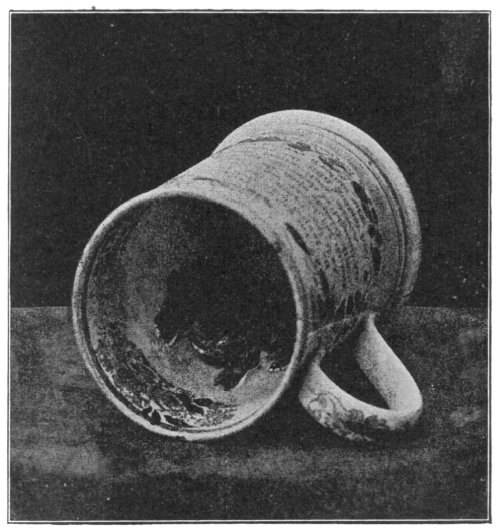
W. G. Honey.]
[Cork.
SUNDERLAND FROG MUG.
(Showing interior.)
London and its environs has given birth to several celebrated potteries. Fulham pottery has a worthy history. Letters patent were granted in 1671 to John Dwight, for the “misterie of transparent{205} earthenware, commonly knowne by the names of porcelain or China and Persian ware, as alsoe the misterie of the stone ware, vulgarly called Cologne ware.” There was, too, a pottery at Mortlake. “Kishere, Mortlake,” is the mark generally used. Isleworth had a small factory at Railshead Creek, Isleworth. Much of the coarse pottery made here was known as “Welsh ware.”
Lambeth pottery is well known, the art productions of Messrs. Doulton having done much to popularise their ware. In the middle of the seventeenth century certain Dutch potters settled at Lambeth, and made pottery tiles. Lambeth delft ware had quite a reputation in the eighteenth century.
Some particularly quaint devices appear on the old English jugs and mugs during the seventeenth and eighteenth centuries. They were used by the common people who could not afford silver and for whom glass was too expensive a luxury. They succeeded the old leathern jacks and leathern bottles, and played no inconspicuous part in social gatherings both at home and in alehouses. Many of the mugs have two (and sometimes as many as four) handles, which were made to supply the needs of several drinkers.
These English mugs possess little artistic merit, but they come as a very interesting link in the history of the manufacture of pottery in this country. One would have thought that the conquering Roman who settled in various colonies in our islands would have left some permanent mark on our pottery; that the Norman, who possessed some artistic skill, or peradventure the Spaniard who settled in the West in Armada{206} days, would have taught the Anglo-Saxon a lesson in pottery; but it appears that the principles of art fell upon very stony ground in these islands.
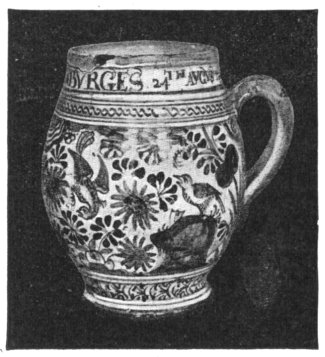
OLD ENGLISH DELFT MUG.
(Dated 1631.)
At Victoria and Albert Museum.
In the national collection in the Bethnal Green Museum is a barrel-shaped mug (51⁄2 inches high), which we reproduce; it is painted in blue with birds and flowers, and inscribed “William and Elizabeth Burges, 24th August, 1631.” This delft mug is believed to be of Lambeth manufacture.
A mug of elegant shape was quite recently dug up in some excavation near Bishopsgate Street, London, for the Great Eastern Railway extension. It bore the inscription—
and was dated 1650, which conjures up pictures of crop-eared ’prentice lads and mercers of busy Chepe, and junketings at the fair by London Bridge in days when train-bands and Ironsides were as integral a part of City history as were the C.I.V.’s of a year or so ago.
Brown and chocolate-coloured body with yellow dotted decorations is a very common form of this old English ware. A Posset Mug, dated 1697, bears the inscription: “The best is not too good for you”—evidently a present of some sort, although much of this class of ware was in common use in taverns, as the inscriptions go to show. We reproduce this dated Posset Mug in the accompanying illustration; next to it, on the lowest shelf, is an old Fuddling Cup. On the top shelf is a Cradle with incised decoration. The other cradle has slip decoration by Joseph Glass, 1703; while beside it is an old Posset Pot inscribed “God bless Queen Ann.” These specimens are reproduced by the kindness of Mr. S. G. Fenton, of Cranbourne Street, W.
Puzzle jugs were known in the time of Henry VIII. There is a puzzle jug at the Bethnal Green Museum, which was made by Mr. John Wedgwood, great-uncle to Joshua Wedgwood, and is dated 1691. The principle of the puzzle is that there are three spouts, each projecting from a tube which runs round the rim and down the handle to the bottom of the vessel. The top of the neck being perforated, it seems impossible to obtain any of the liquor without spilling it. The secret is to stop two of the spouts with the fingers while drinking at the third.
Other forms are the Tyg, a tall cup, with two or more handles, and decorated either with names or initials; and the Piggin, a small shallow vessel some few inches high, provided with a long handle, and used for ladling out the liquor brewed in the tyg. The doubled-handled tygs are generally called “parting-cups,” while those with more than two handles pass under the name of “loving-cups.” The word tyg comes from the Anglo-Saxon “tigel,” or tile, and survives in the word “tilewright” and other corruptions common in Staffordshire.
Some of the puzzle jugs bear interesting doggerel lines upon them. One runs—
Not a very good recommendation for a jug, but a very profitable alehouse amusement from mine host’s point of view.
Another bears the lines—
There is a very quaint inscription on a four-handled goblet, possibly a christening cup. It is dated 1692, and has the sides decorated with rough devices.{211} Attached to one of the sides is a whistle; the mug has written upon it in atrocious spelling—
The orthography of potters in the age before School Boards is something to marvel at. Apparently the following is the gift of an amorous potter to his lady-love. I. W. has gone the way of all lovers, but the little mug he made for his sweetheart lies on the museum shelf, an object-lesson to all “golden lads and lasses” who, as Herrick’s fair daffodils, “haste away so soon.”
“Ann Draper, this cup I made for you, and so no more.—I. W.”
Dated 1707, in the days of the great Marlborough.
Some mugs have the precept, “Obeay the King,” while others bear the superscription, “Come let us drink to the pious memory of Good Queen Anne.” One or two utter the toast, “God Save King George.” A Gossip’s Bowl, dated 1726, has the couplet—
Another old mug, doubtless sent as a present, has the words—
There is one quaint piece of advice given to all lovers who wish for success in their love affairs. It is on a level with the Shakesperian methods adopted in the conquest of Kate in the “Taming of the Shrew”—

OLD PUZZLE JUG.
(Dated 1691.)
Victoria and Albert Museum.
Some of the pronunciation is as curious as the spelling. We know Pope makes “tea” rhyme with “day,” as does the modern Irishman; but in the following lines “join” is evidently pronounced “jine”—
—an invitation issued to the frequenters of some inn where the brown jug bearing the inscription had an abiding place.
Another mug essays to point a moral while the toper is draining its contents. The potter who would strew his moral lessons in stoneware had about as much sense of the ludicrous as the gentleman who used to mark the London pavements with the text “Watch and Pray,” which he had printed in reverse{213} on the soles of indiarubber shoes he would wear. On the bottom of a drinking mug the notion is quaint enough—
For our part, we prefer the following, which has a truer ring about it—
A large bowl of Bristol delft bears on it “Success to the British Arms.”
A fine breezy inscription, dated 1724, smacks of the hunting field. One can hear the rollicking voices of the eighteenth-century squires such as Randolph Caldecott loved to depict. Only two lines, but they ring in one’s ears as a message from the good old times—
Not classical English, perhaps, any more than that of the ladies from town who declare in the family circle of the Vicar of Wakefield that they are in a “muck-sweat.”
A set of six plates bear a line of the following inscription on each—
There is an exceedingly interesting Fulham ware flip mug, which bears an inscription on it showing that it once belonged to Alexander Selkirk, from whose adventures Defoe built up his story of “Robinson Crusoe.” Doubtless this mug accompanied the Scots sailor to the lonely island of Juan Fernandez when he set sail with the Cinque Ports galley—
which suggests that it may have been a parting present from one of his friends.
Jugs and mugs with portraits of Nelson are not uncommon. A quart jug in white ware with crimson border has a man-of-war in full sail on one side, and on the other a copy of West’s picture of the “Death of General Wolfe,” probably made by Thomas Wolfe, of Stoke-on-Trent, who was related to the general. On one mug is a view of the Thames Tunnel and a portrait of the engineer Brunel, to commemorate the opening in 1843. We give as a headpiece a Sunderland jug from Mr. Honey’s collection, having floral decorations in purple lustre, and having on one side a picture of the “Columbus, the largest ship ever{215} built.” On the reverse side are two jolly tars, and the inscription runs—
Mugs seem to have in former days been manufactured to celebrate some political event or great victory. There were the coronation mugs of the present Czar of Russia, at the distribution of which so many peasants lost their lives. The Transvaal War produced no china mementoes. Mafeking buttons and ticklers are more representative of modern feeling.
To us these old English mugs are as the dry bones which, if one is only skilful enough magician, resolve themselves into dream-pictures, historically accurate enough, of our forbears of the eighteenth century. Our children’s children, when they come to examine our everyday ware, will find little else to observe save the legend “Made in Germany.”
The field of English earthenware is very large and very diverse. We have been prohibited by space from saying anything of salt-glaze ware, of Elers, or of Astbury, and we regretfully have to pass on without touching Leeds ware. But we give an interesting illustration of a group of Mason’s jugs of the celebrated “Patent Ironstone China.” The largest of these jugs is 91⁄2 in. high. This is not{216} a complete set, as the writer knows of the existence of a jug of smaller size, and another size between the second and third largest, which make a set of eight.

[Earliest mark 1780].
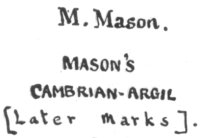
[Later Marks].
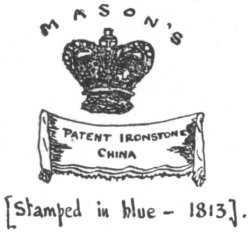
[Stamped in blue—1813].
MARKS ON MASON’S WARE.
We give, too, a set of marks used by the firm of Mason, from the early days till the factory ceased. In the advertisement mentioned below he says, “The articles are stamped on the bottom of the large pieces to prevent imposition.”
Miles Mason established his pottery at Lane Delph, in Staffordshire, about 1780. “Miles Mason, late of Fenchurch St., London,” so runs his advertisement in the Morning Herald, October 1, 1804, “having been a principal purchaser of Indian porcelain, till the prohibition of that article by heavy duties, has established a manufactory at Lane Delph, near Newcastle-under-Lyme.” The “Ironstone China” was patented by Charles James Mason in 1813. It consisted in using the slag of ironstone pounded with water together with flint, Cornwall stone, and clay, and{217} blue oxide of cobalt. The ware is usually outlined with flowers in transfer printing, and painted and gilded by hand. Some of Mason’s blue plates are in colour equal to old blue Delft. On account of its handsome decorative effect it is rapidly rising in value.
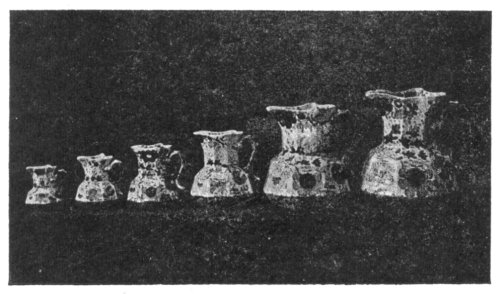
GROUP OF MASON’S JUGS.
(Largest 91⁄2 in. high.)
In Collection of Mr. W. G. Honey.
| Staffordshire. | £ | s. | d. |
| Jug, Bacchanalian, 13 in. high, figures in bold relief of “Bacchus” and “Pan” supported by a barrel with grotesque animal handle and dolphin spout, in rare colours and highly glazed by Voyez, Cobridge, 1788. Edwards, Son & Bigwood, Birmingham, May 13, 1902 | 15 | 0 | 0 |
| Vase, Etruscan, 18 in. high, snake-and-mask handles, marked S. A. & Co. (Alcock & Co). Edwards, Son & Bigwood, Birmingham, May 13, 1902 | 10 | 0 | 0 |
| Mason’s Ware. | |||
| Vase 27 in., decorated with flowers and gilt, and ornamented with gilded head handles supporting a cornucopia and mermaid. Gudgeon & Sons, Winchester, April 3, 1902 | 8 | 5 | 0 |
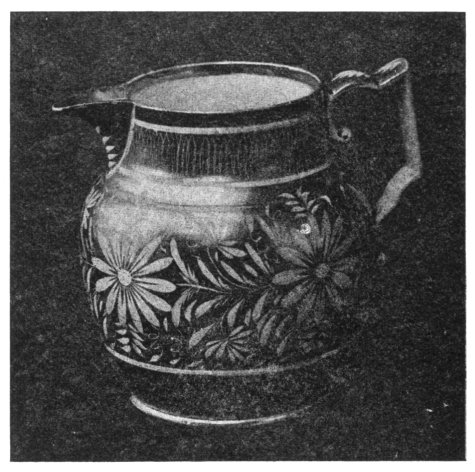
SILVER LUSTRE JUG.
In the Collection of Mr. W. G. Honey.
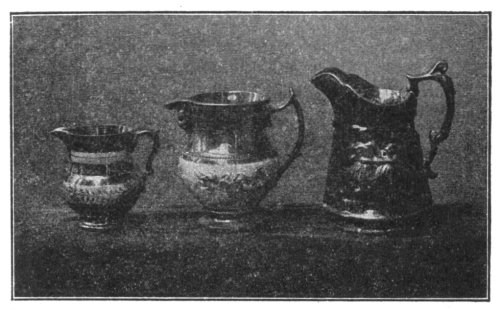
W. G. Honey.]
[Cork.
COPPER LUSTRE JUGS.
(43⁄4 in., 63⁄4 in., 71⁄4 in. high.)
XII
LUSTRE WARE
The old Spanish golden red and canary coloured lustrous dishes with Moorish ornamentation, and the wonderful Italian majolica, with its copper and purple and amber surfaces glowing like beaten metal, are probably the early masters from which our English potters took the idea which they adapted to the decoration of their pottery.
In this chapter we shall treat solely of English lustre ware. It is roughly divided into three classes—copper, silver, and gold.
The copper or brown lustre was made at Brislington, near Bristol, as early as 1770. Compared with the Spanish lustre dishes, it is more rudely ornamented{222} and poor and inartistic in form compared with their Arabic designs. Our English copper lustre, or “gilty” ware, as it is called in some parts of the country and in Ireland, may be sub-divided into two classes. The plain copper lustre, in which the jug, or dish, or teapot is entirely covered with the copper lustre; and secondly, the partially lustrous ware, in which some portions of the pottery are in relief and are coloured with some bright pigments, or left white.
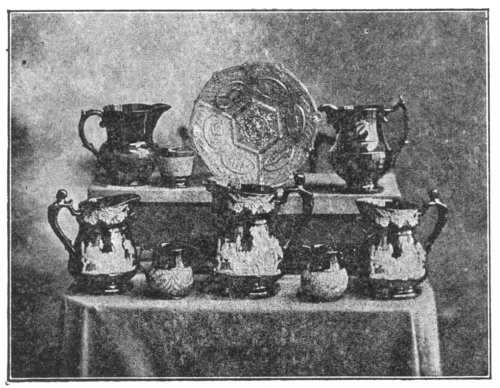
GROUP OF COPPER LUSTRE WARE.
In the group of lustre ware, which we reproduce, with the exception of the centre dish, all the pieces are copper lustre. The three fine jugs are decorated with turquoise blue, as are also the two cream jugs.{225} This blue, though it comes out white in our illustration, is of a deep turquoise. On the top shelf, the jug to the right is decorated with red as well as blue. It will be observed that the spouts of the jugs are in the form of a man’s head with long beard, and the handle is the figure of a man’s body. The scenes depicted on them are typically English in treatment. A castle in background and a shepherd with his flock in foreground. The small lustre cup has simply a rough-surfaced band of white running round it. The whole form a representative group of this class of ware.
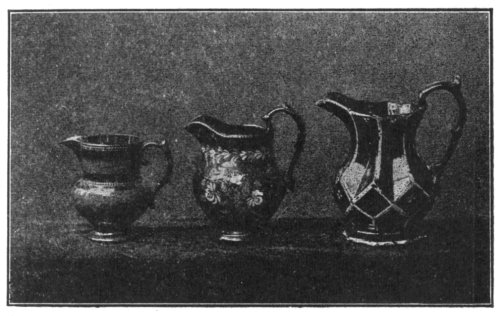
W. G. Honey.]
[Cork.
COPPER LUSTRE JUGS.
(41⁄4 in., 61⁄2 in., 71⁄2 in. high.)
The best period in the copper lustre is in the first years of the nineteenth century, before the introduction of colours in conjunction with the coppered surface. It may be observed in passing that the art{226} of producing copper lustre has continued in a spasmodic manner down to the present day, the latter specimens being of a rougher exterior and of a coarser finish.

COPPER LUSTRE JUG.
(83⁄4 in. high.)
From the Collection of Mr. W. G. Honey.
By the kindness of Mr. W. G. Honey we are enabled to reproduce some fine examples of lustre ware from his collection on view last year at the{227} Cork Exhibition. The copper lustre bust, 151⁄2 in. high, is a perfect example of lustre ware at its highest level. This specimen has no equal in any of the public collections. Two other illustrations, one of which appears as a headpiece, giving half a dozen forms of copper lustre jugs, are from the same collection. While the copper lustre jug, 83⁄4 in. high, is a beautiful specimen of fine modelling.
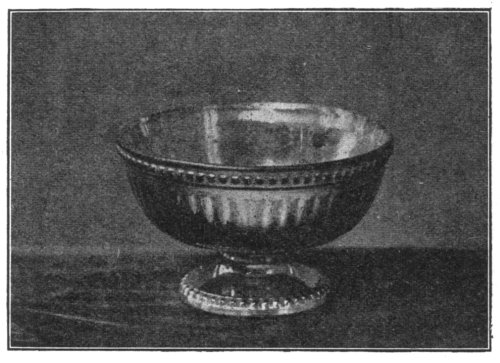
W. G. Honey.]
[Cork.
SILVER LUSTRE SUGAR-BOWL.
(3 in. high.)
With regard to silver and gold lustre, that in all probability became extinct for a little time, but in recent years the great demand for silver lustre has produced a corresponding supply, manufactured abroad for the English collector, but it is very inferior{228} and easily detected from the early examples by its coarse and dull surface and slovenly finish.
The places where lustre ware is known to have been manufactured are at Brislington, by R. Frank, about 1770; at Etruria, by Wedgwood, in 1780; and by Wilson, in Staffordshire, in 1785; also by Moore & Co. and Dixon & Co., at Sunderland, about 1820.
Swansea, at the Dillwyn pottery (of which we spoke in our “Chat” on Swansea), also, about 1800, is known to have produced lustre ware.
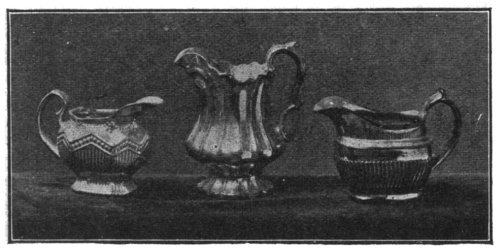
W. G. Honey.]
[Cork.
SILVER LUSTRE JUGS.
Different processes were employed in producing the lustre, but they all consist in reducing the metal from a state of combination, by dissolving it in some chemical, and depositing it in a particularly thin layer on the surface of the pottery, so that it exhibits its characteristic lustre without burnishing. As may readily be supposed, the amount of platinum used for{229} the silver ware, and gold for the purple or gold lustre, is extremely small.
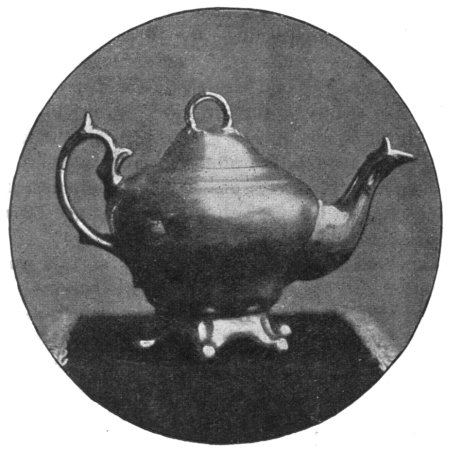
SILVER LUSTRE TEAPOT.
Of the silver or platinum lustre very many fine examples exist, and it is extremely popular owing to its similitude to old English silver or plate. The sugar bowl we reproduce, with beaded pattern and fluted design, is quite in the style of the Sheffield plate of the Georgian period. Of the three silver lustre cream jugs, that in the extreme right is of the same design, while the other two show at a glance{230} the beauty of form that silver lustre in its best period reached.
Other varieties of this silver lustre are quite plain, as in the teapot we reproduce (p. 229), which is an example of a slightly later period. This is a fine specimen of the unornamented variety of silver lustre which is undistinguishable from silver. In fact the highly burnished surface of such a teapot as this cannot be obtained on silver, the lustre is of a richer and deeper quality. Alas! it possesses the dangerous property of dissolving, like a fairy gift, into nothingness. Elfin gold will turn into a circle of whirring, dancing, mocking leaves, and if your wondrous lustre teapot slips to the ground, it lies a heap of brown earthenware fragments.
One word in passing to collectors of this ware. Do not wash your specimens any more than you can help, as warm water has a deleterious effect on the lustre, and tends to make it less brilliant; we recommend our readers to polish their lustre ware with a soft cloth, and we wish them absolute and entire freedom from all mishaps. Treat the ware lovingly and kindly, it will never come again; the potters who made it are dead, the modern imitator is but a poor imitator, fraudulent at heart and feeble in result; if cunning lie in his heart it is not in his finger-tips, for, of a truth, his hand has lost its cunning.
Besides the plain silver lustre, there is a decorated variety which is very handsome, and much sought after. Sometimes the ground is of silver lustre decorated in white, and sometimes the ground is white with an elaborate pattern of foliage, of fruit,{231} or of birds, woven in silver thread. The rarest of this variety is the silver pattern on a canary ground.
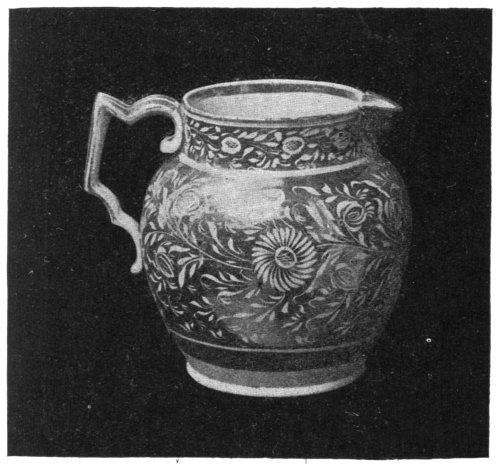
SILVER LUSTRE JUG (5 IN. HIGH).
(White Decoration.)
From the Collection of Mr. W. G. Honey.
The first method, with the design left in white, was produced in handsome and highly artistic styles, and there is a pattern known as the “Resist” pattern which is much sought after.
From Mr. W. G. Honey’s collection we have selected a very good example of this silver lustre{232} with design in white. This is of the “Resist” pattern, its artistic excellence speaks for itself.
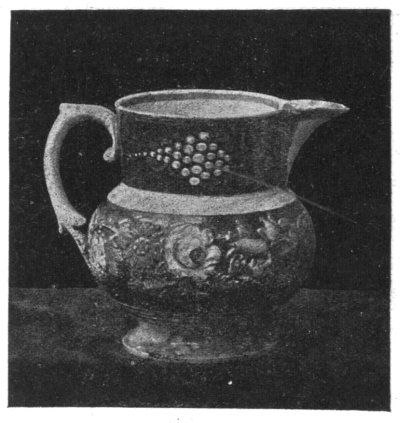
GOLD LUSTRE JUG
(Raised coloured flowers.)
From the Collection of Mr. W. G. Honey.
With regard to gold or purple lustre, the middle dish in the group in our illustration is gold lustre ware, and is probably of Swansea manufacture. Wedgwood produced a gold lustre of remarkable brilliancy. The dish above alluded to is decorated with stags and staghounds, but in some of the gold undecorated examples, such as Wedgwood’s, covered with a{233} mottled ruby-gold lustre, the effect was due entirely to the shape and to the lustre.
The reason that this variety is called gold or purple lustre is that in the lights it shines like gold, and the rest of the pattern in those pieces decorated with flowers and floral pattern, glows with a rich purple.
This purple lustre shows more signs of the hand of time than any of the other lustres, and it is nearly always found to be partially worn off. We give an interesting example of a jug with gold lustre ground and raised coloured flowers from Mr. W. G. Honey’s collection.
Note.—Lustre ware is more fully treated in a chapter in the companion volume, “Chats on English Earthenware.”
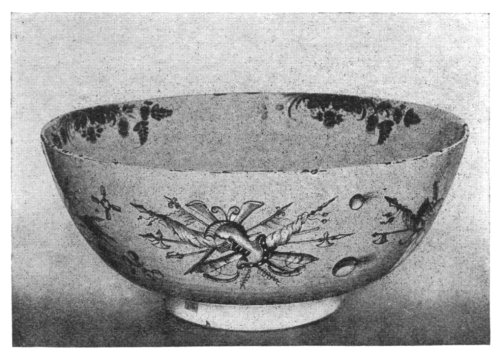
LIVERPOOL DELFT PUNCH BOWL.
(Decorated with military trophies in blue, and having three-masted man-of-war inside.)
Diameter, 201⁄2 in.
At Victoria and Albert Museum.

In possession of Messrs.
Fenton & Son.
OLD LIVERPOOL TILES.
(Transfer-printed in black.)
XIII
LIVERPOOL WARE
It is the hope of the writer of these “Chats” that Worcester and Derby, Bristol and Plymouth, Bow and Chelsea have become something more than mere names to the readers who have followed our journeyings. The china-shelf has been shown to hold the monuments of men’s lives. Behind the delicate pencillings and the shower of rose-leaves lies many a tragic story. Liverpool and its ware is not the least of the great landmarks in the history of English ceramic art.
In entering on the threshold of the history of Liverpool, and of the printed ware stated to have been first produced there, we find ourselves in the midst of a controversy. If discussions upon points of china-collecting were waged physically, the{238} opponents in their heat would have demolished each other long ago with their own china collections, but luckily, they have confined themselves to hurling opinions and nothing more tangible. Philosophically, they have agreed to differ, and have parted good friends, to renew the argument another day, or they have each gone to his last home and the echoes of the conflict have come down to us, and fresh battles are fought over the theories of dead collectors. Up till quite recently a wordy war was being waged over Lowestoft, and the laurels of that much-disputed factory were in great danger of being snatched away.
To John Sadler, of Liverpool, is generally ascribed the honour of having discovered the useful art of printing on pottery from copper-plate engravings. He was the son of Adam Sadler, a printer, in Liverpool, who had formerly served as a soldier under the Duke of Marlborough in the wars in the Low Countries. John Sadler carried on the business of an engraver in Harrington Street, and having noticed that some of his waste prints were used by children to stick on to fragments of earthenware obtained from the potteries, he commenced experiments with a view of extending this application to the purposes of decoration.
He associated himself about the year 1750 with Guy Green, who had succeeded to the printing business of Adam Sadler.
The secret of the manner in which an engraving was transferred from a copper-plate to the rounded surface of a bowl or a teapot, was well kept, but it{239} was fairly obvious that in some way or another the design was transferred to paper and then retransferred to the china object to be decorated.
Sadler and Green, after working at the discovery, applied for a patent. The value of the invention can best be understood by the following affidavit made by John Sadler and Guy Green, in 1756.
“I, John Sadler, of Liverpoole, in the county of Lancaster, printer, and Guy Green, of Liverpoole aforesaid, printer, severally maketh oath, that on Tuesday, the 27th July, inst., they, these deponents, without the aid or assistance of any other person or persons, did, within the space of six hours, to wit, betwixt the hours of nine in the morning and three in the afternoon of the same day, print upwards of 1,200 earthenware tiles of different patterns, at Liverpoole aforesaid, and which, as these deponents have heard and believe, were more in number, and better, and neater than 100 skilful pot painters could have painted in the like space of time in the common and usual way of painting with a pencil; and these deponents say that they have been upwards of seven years in finding out the method of printing tiles, and in making tryals and experiments for that purpose, which they have now, through great pains and expense, brought to perfection.”
Two printers doing the work of a hundred tile painters! The stupendous nature of the invention is seen in the light of this statement. Caxton never made a greater discovery when he set his type moving, and the illuminated manuscripts of the monks became the printed page in the hands of the{240} common people. Josiah Wedgwood, with characteristic foresight, saw the value of the work of Sadler and Green, and his waggons made weekly journeys from Staffordshire up to Liverpool laden with his Queen’s ware to be decorated in the new style.
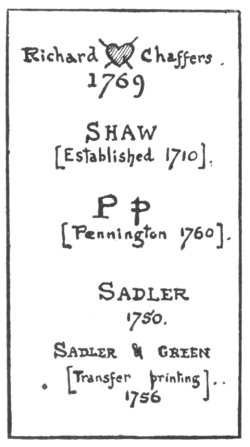
[Established 1710].
[Pennington 1760].
[Transfer Printing
1756]
EARLY LIVERPOOL MARKS.
To come back to the controversy for a moment, it is claimed that Worcester was first to produce printed china. There is at the Bethnal Green Museum a printed mug of Worcester, dated 1757. It will be remembered that the date of Sadler and Green’s affidavit was 1756. But a claim is made for a third factory—Battersea. There is a letter from Horace Walpole to Bentley, dated 1755, in which he says: “I shall send you, too, a trifling snuff-box, only as a sample of the new manufacture of Battersea, which is done from copper-plates.” There are also dated pieces of this Battersea enamel with the design printed upon them, dated as early as 1753 and 1754. In all probability Worcester derived the secret from Battersea, as Robert Hancock, of Worcester fame, who signed some of{241} the older pieces, was formerly an engraver at Battersea.

LIVERPOOL MARKS
(1756-1822).
In spite of this fact there is every reason for believing that at Liverpool, Sadler and Green independently discovered the art of printing on china, as their affidavit declares them to have been engaged upon it for seven years, which takes them back to 1749.

LIVERPOOL MARKS
(1822-1841).
Of the earlier potters of Liverpool, we have little space to deal in this “Chat.” Chaffers, a contemporary of Josiah Wedgwood, and a formidable rival of the Staffordshire potter; Thomas and Samuel Shaw; John Pennington, celebrated for his punch-bowls and for a very fine blue ware, are all well known to collectors of Liverpool ware. We give the marks of these factories, and of other Liverpool makers: Philip Christian (1760-1775), W. Reid & Co. (1756-1760), Herculaneum Pottery (1790-1841). Staffordshire had its Etruria and Lancashire its Herculaneum. In the earlier days of the potter{242} classic names were much in vogue. A favourite pattern in Herculaneum china was a series of the towns of England printed on the pieces, with the name in a medallion at the bottom of the piece. The bird is the liver, being the crest of the city of Liverpool, and was used at Herculaneum by Messrs. Case, Mort & Co. in 1833. The anchor mark is between this date and 1841, when the factory ceased.
When it is remembered that Wedgwood had his ware printed by Sadler and Green and that Bow sent to Liverpool to have the Liverpool designs transferred to the Bow china, it is easy to understand how complicated it becomes to determine with exactitude how little or how much was actually printed at Liverpool, because there came a time when the secret leaked out and when other factories besides Liverpool and Worcester began to print their own wares.
We reproduce a Liverpool mug, printed in brownish red colour, representing a lover and his lass. It is typically English in treatment and design, and it is this quality which makes Liverpool printed ware so interesting. There is nothing like it in any of the Continental wares. The quaint and delicate English pastoral scene breathes of the eighteenth century. The refrain might run:—
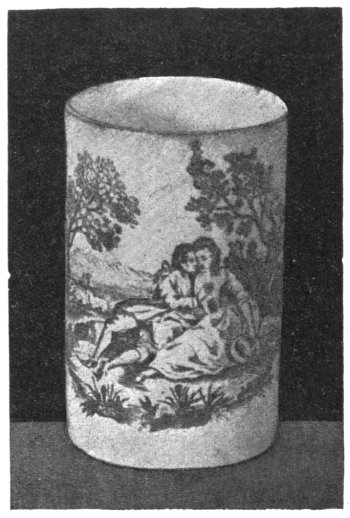
In possession of Mr. S. G. Fenton,
Cranbourne Street.
OLD LIVERPOOL MUG (4 IN. HIGH).
(Printed in brown.)
Or take the old Liverpool jug with the landscape printed in black on one side, and the humorous heads, entitled “Courtship and Matrimony,” on the other; which heads, by the way, will our readers kindly turn upside down to gather what the acid doggerel written underneath alludes to. It is a pity the jug is not perfect, but the top has a metal band which remedies the broken spout. The lines underneath the heads run:—
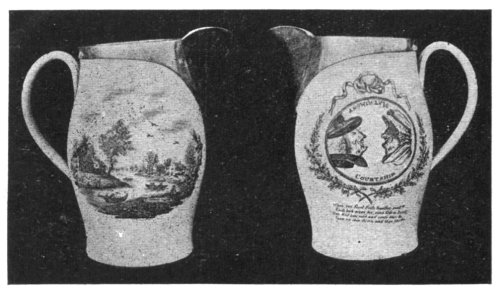
OLD LIVERPOOL JUG (71⁄4 IN. HIGH).
(Transfer-printed in black.)
Landscape and Heads entitled “Courtship and Matrimony.”
From the Collection of Capt. H. F. Maclean.
We reproduce as a headpiece two exquisitely black{245} printed Liverpool tiles. It is true they are badly damaged, but their quaint designs were worth the preserving. The one with the gallant sportsman firing at a deer at very close range is queerly out of perspective. The other tile is a typically English rural scene, and pity it is that more of our rustic scenery has not found its way to our national china.
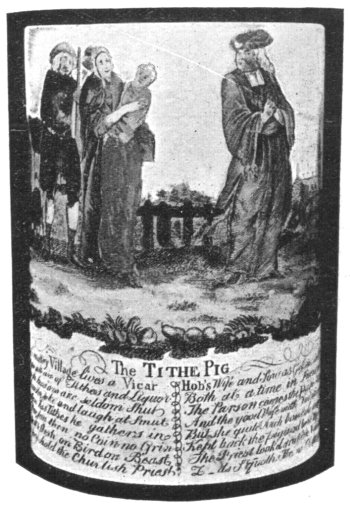
LIVERPOOL MUG (6 IN. HIGH).
(Transfer-printed and partly coloured after glazing.)
From the Collection of Capt. H. F. Maclean.
Another of our illustrations is that of a Liverpool{246} mug with subject entitled “The Tithe Pig,” in which the vicar appears to have come off worst in a wordy encounter with two of his parishioners. There is a grim humour about many of the eighteenth-century decorated mugs and jugs which are a record in ceramics of party strifes and of long-forgotten social enmities.
It will be seen that the Liverpool printed ware has in it an element of decoration which some of the other wares do not possess. Many of our readers doubtless possess specimens of this black or brown printed ware, mugs, or tiles, or teapots with old-world scenes upon them like the landscapes of our illustration. Shepherds and herds, fifers and fiddlers and dancers, village-green sports, lads and lasses “dancing the hays”—these are the homely scenes transferred from the old copper-plates.
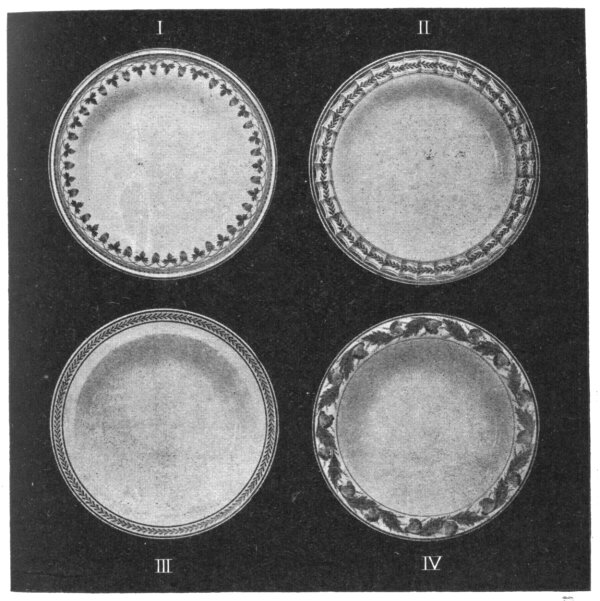
WEDGWOOD DINNER PLATES FROM DESIGNS IN FLAXMAN’S SKETCH-BOOK. PRODUCED OVER 100 YEARS AGO AT ETRURIA, AND STILL MADE BY THE FIRM.
I. Strawberry. II. Lag and Feather. III. Feather border. IV. Bell-flower and leaf pattern.
By courteous permission of Messrs. Josiah Wedgwood & Sons.
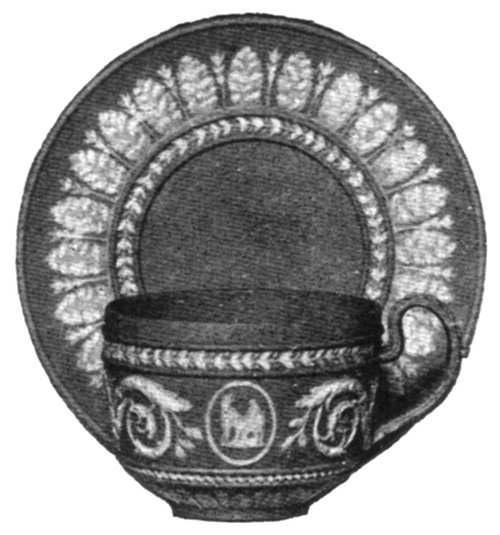
WEDGWOOD JASPER CUP AND SAUCER.
By courtesy of Messrs. Josiah Wedgwood & Sons.
XIV
WEDGWOOD
The pottery made in England did not exhibit any marked characteristic, nor was it of much artistic value until Josiah Wedgwood, by his genius, raised Staffordshire ware to such a degree of perfection that it was universally used on the Continent of Europe.
Josiah Wedgwood, the youngest of a family of thirteen, was born in 1730, and came of a race of potters. There were Wedgwoods, potters, at Burslem, in the seventeenth century. We give an illustration of a puzzle jug having the inscription, “John Wedg Wood, 1691” (see p. 212).
Young Josiah left school at the age of nine and was apprenticed to his brother. At eleven, he had a most virulent attack of small-pox, which left him a weakling. Later on in life, he had to have one of his legs amputated owing to a weakness which he{250} always had after his first terrible illness. Physically handicapped from the start, Josiah Wedgwood—wooden-legged though he was for over a quarter of a century—was the prince of English potters. His genius was coupled with great business capability. His inventions were eminently successful. Starting with £20, which his father left him, he died worth over half a million.
Thoroughness seems to have been his policy, and prosperity always attended him. He interested himself in getting an Act of Parliament for better roads in the vicinity of the Staffordshire potteries. He cut the first sod of the Grand Trunk Canal.
His aim was a glorious one. “Let us make all the good, fine, and new things we can,” he said to his partner Bentley once, “and so far from being afraid of other people getting our patterns, we should glory in it, and throw out all the hints we can, and, if possible, have all the artists in Europe working after our models.”
He allowed no imperfect thing to leave his factory. It is a quaint scene one conjures up of the potter who, when going through his works, used to lift the stick he leant on and smash to pieces some offending dish or vase, saying, “This won’t do for Josiah Wedgwood.”
The beginnings of Wedgwood ware were simple enough. In 1752, Josiah left Burslem to go to Stoke, where he was engaged in manufacturing knife-handles and like objects in imitation of agate and tortoiseshell. Subsequently he entered into partnership with John Harrison, of Newcastle, and{251} their wares were made at Stoke. In 1754, Wedgwood and Harrison entered into partnership with Thomas Whieldon at Little Fenton, the most eminent potter of his day. Shortly after Harrison disappears from the partnership. This connection between Whieldon and Wedgwood was a most important one. Their principal manufactures were tortoiseshell plates and dishes, cauliflower jugs, teapots with crabstock handles, and agate knife-handles. While with Whieldon, Wedgwood produced a new green earthenware, highly glazed and decorated with flowers and fruit, which was mainly used for dessert services.

CUP AND SAUCER.
WHIELDON TORTOISESHELL WARE.
The tortoiseshell ware now known by Whieldon’s name is very beautifully made. Usually the plates and dishes are hexagonal or octagonal in shape, with very finely moulded edges, and having a mottled and variegated arrangement in colour, which more resembles marble than tortoiseshell.
Wedgwood made snuff-boxes, and various trinkets intended to be mounted in metal. These productions of his were coloured to represent precious stones. When the jewellers of London and Bath were shown these wares, they considered them a valuable discovery, the secret of which they could not discover. But learning the low price at which Wedgwood was intending to sell them they grew less favourable, probably from thinking the imitation would ruin the sale of genuine jewels.
We learn, too, that Wedgwood at this time was so incapacitated from attending to his business, owing to the remains of his old complaint, that he was obliged to communicate the secret of the method and proportions of his mixtures to a workman.
The ware manufactured by Whieldon, both during his partnership with Wedgwood and afterwards, are of good quality, and are highly prized by collectors. A tortoiseshell plate costs a sovereign to-day.
Of course none of these early wares of Wedgwood are marked. We shall show how he laid the foundation of his manufactory, which he called “Etruria,” after the Italian home of the famous Etruscans, whose work he admired and imitated.
What Wedgwood did for Staffordshire is shown best in the following sentence by M. Faujas de Saint Font in his “Travels,” who says, speaking of the Wedgwood ware: “Its excellent workmanship, its solidity the advantage which it possesses of sustaining the action of fire, its fine glaze, impenetrable to acids, the beauty and convenience of{253} its form, and the cheapness of its price, have given rise to a commerce so active and so universal that in travelling from Paris to Petersburg, from Amsterdam to the furthest part of Sweden, and from Dunkirk to the extremity of the South of France, one is served at every inn with English ware. Spain, Portugal, and Italy are supplied, and vessels are loaded with it for the East and West Indies and the continent of America.”
Leaving the biographical side of the subject, we come to the actual productions of Josiah Wedgwood. We left him in partnership with Whieldon. That partnership ended, he commenced manufacturing on his own behalf. He speedily found that one pottery was not enough to satisfy his tireless energies. He became the owner of two. In 1762, he presented Queen Charlotte with a breakfast service of cream-coloured earthenware. In return he received the title of “Potter to her Majesty,” and his Queen’s Ware became a great success. Every fortnight a waggon left Burslem for Liverpool with a freight of this ware, to be decorated by Messrs. Sadler and Green by their transfer process at Liverpool.
About this time he took his cousin, Thomas Wedgwood, into partnership, and later Thomas Bentley, of Liverpool, a man of great taste, who exercised no inconsiderable influence upon the style of design of the new pottery at Etruria. A man of wide reading and culture, it was he who supplemented Wedgwood’s practical efforts by his theories. It was always Wedgwood first, but Bentley was{254} an ideal second. He took no part in what Wedgwood termed the “useful” side of the manufactory, such as, for example, the manufacture of Queen’s Ware and other articles for everyday use. Bentley’s partnership was only concerned with the “ornamental” side of the pottery, such as the manufacture of vases and works of art.
In 1769 Etruria was opened, and Josiah Wedgwood might have been seen at the potter’s bench and Thomas Bentley at the wheel, and their united labours produced the first vase, having an inscription which runs:—
JUNE XIII., MDCCLXIX.
ONE OF THE FIRST DAY’S PRODUCTIONS
AT
ETRURIA IN STAFFORDSHIRE,
BY
WEDGWOOD AND BENTLEY.
ARTES ETRURIÆ RENASCUNTER.
The subject of decoration is Hercules in the Garden of the Hesperides, and was a forerunner of those classical pieces which have made Wedgwood as honoured a name in Europe as that of Palissy the Frenchman, of Lucca del Robbia the Italian, or of Böttcher the German.
The range of the Wedgwood ware may be gathered from the fact that in one of the catalogues the productions are divided into twenty distinct classes. It is not our intention to enumerate these, but they comprised series of medals and medallions of the{255} Cæsars, the Roman emperors, the heads of the Popes (consisting of no less than two hundred and fifty-three medallions), a hundred heads of the kings of England and France, together with “heads of illustrious moderns.” In addition to these there were admirable busts, some being twenty-five inches in height, of Lord Chatham, Cornelius De Witt, John De Witt, Plato, and many more. These were in black basaltes, durable as marble. Lamps and candelabra of antique forms were produced from “two shillings apiece to five guineas.”
In passing, we may refer to the above fact to show why Wedgwood or any other ware varies in value so much at the present day. Obviously a two-shilling lamp will not be as valuable as a five-guinea one. Readers learn that certain china has fetched a large price in the auction-room. Sometimes they erroneously infer that other china they possess, which bears the mark of the same factory, is equally valuable. The above will point the moral of the story. It is a fact that cannot be too often insisted upon that the great factories turned out productions by the ton, many of them intended for ordinary everyday use, and though bearing their mark, yet not valuable from the collector’s point of view.
There are, of course, other reasons why china is or is not valuable, but this is a very solid reason too often overlooked. To be able to differentiate the good from the bad, “that is the question.” To know that a specimen is good is one thing, to give the reason why is another. When the reader begins to do this he or she is already a connoisseur.
In order to give a fairly proportionate idea of what Wedgwood ware is, we quote a list and description of six different kinds of ware in his own words:—
“1. A terra-cotta; resembling porphyry, granite Egyptian, pebble, and other beautiful stones of the silicious or crystalline order.

WEDGWOOD TERRA-COTTA VASES
In Museum at Etruria.
By courtesy of Messrs. Josiah Wedgwood & Sons.
“2. Basaltes or black ware; a black porcelain biscuit of nearly the same properties with the natural stone; striking fire with steel, receiving a high polish, serving as a touchstone for metals, resisting all the acids, and bearing without injury a strong fire; stronger, indeed, than the basaltes itself.
“3. White porcelain biscuit, of a smooth, wax-like surface, of the same properties with the preceding, except in what depends upon colour.
“4. Jasper; a white porcelain biscuit of exquisite beauty and delicacy, possessing the general properties of the basaltes, together with the singular one of receiving through its whole substance, from the admixture of metallic calces with the other materials, the same colours which those calces communicate to glass or enamels in fusion—a property which no other porcelain or earthenware body of ancient or modern composition has been found to possess. This renders it peculiarly fit for making cameos, portraits, and all subjects in bas-relief, as the ground may be of any particular colour, while the raised figures are of a pure white.
“5. Bamboo, or cane-coloured biscuit porcelain, of the same nature as No. 3.
“6. A porcelain biscuit, remarkable for great hardness, little inferior to that of agate. This property, together with its resistance to the strongest acids and corrosives, and its impenetrability by every known liquid, adapts it for mortars and many different kinds of chemical vessels.
“These six distinct species, with the Queen’s Ware already mentioned, expanded by the industry and ingenuity of the different manufacturers into an infinity of forms for ornament and use, variously painted and embellished, constitute nearly the whole of the present fine English earthenwares and porcelain which are now become the source of a very extensive trade, and which, considered as an object{258} of national art, industry, and commerce, may be ranked amongst the most important manufactures of the kingdom.”
Of these various wares we give illustrations. The three vases we reproduce are fine examples in imitation of porphyry and other precious stones (see p. 256). The material is so hard that it can be worked upon by the lapidary, and takes as fine a polish as the real stone it resembles.
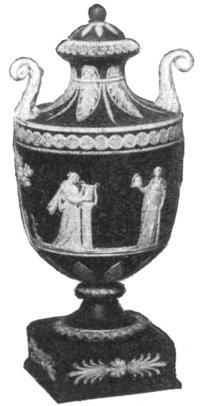
WEDGWOOD JASPER VASE.
By courtesy of Messrs. Josiah Wedgwood & Sons.
Of the celebrated basaltes or black ware, sometimes called Egyptian ware, the vase we reproduce as the first made at Etruria was of this class, and we give two other examples.
We give two very beautiful specimens of the Jasper ware. This wonderful ware was made in seven colours: blue, lilac, pink, sage-green, olive-green, black, and yellow. Specimens of this last colour are very rare.
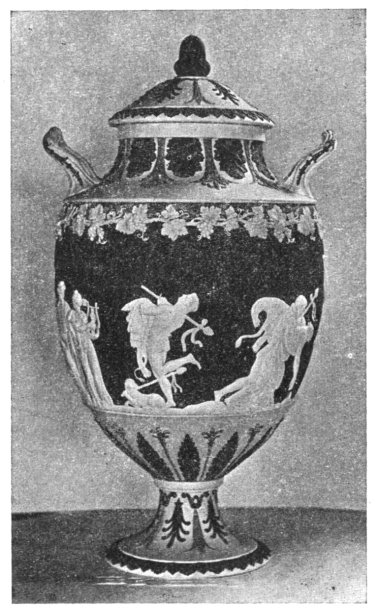
WEDGWOOD BLUE AND WHITE JASPER VASE.
In Museum at Etruria.
“Future ages may view the productions of the age of George III. with the same veneration that we now behold those of Alexander and Augustus,” writes{260} Wedgwood of his cameo portraits, with fine enthusiasm.

Reproduced by kind permission
of Messrs. Wedgwood & Sons.
WEDGWOOD PLAQUE (designed by Flaxman).
L’Entente Cordiale.
Mercury uniting the hands of England and France.
Having dealt with the biographic side of Wedgwood ware, and of the genius of the great Josiah Wedgwood, and having enumerated the various classes of ware originated by him, we come now to the consideration of his classic wares, of which the wonderful replica of the Portland Vase stands as the most notable example.

THE BARBERINI OR PORTLAND VASE.
(Copied by Josiah Wedgwood.)
In British Museum.
In passing, we mention the celebrated service of Wedgwood made for the Empress Catherine II. of Russia, which took eight years to complete. It consisted of 952 pieces, of which the cost was about £3,000. This splendid service had upwards of 1,200 views of the seats of noblemen and gentlemen in various parts of England. A large service for Queen Charlotte of views in black enamel of palaces and seats of the nobility took three years to execute.
To his celebrated “Jasper” ware, Wedgwood devoted immense and never-ending skill to bring it to its final perfection.
The use to which he put this jasper is well illustrated in his series of beautiful portrait medallions. We reproduce a design of a plaque by Flaxman, representing the hands of France and England being joined together by the god Mercury.
Wedgwood was enabled, by the patronage of noblemen who possessed fine classic examples and gladly lent them to the great potter, to copy some of the finest specimens of the old art of the Greeks. He was thus enabled to produce the celebrated “Dancing Nymphs” and the “Head of Medusa” from Sir William Hamilton’s collection; and to other great collections he was similarly indebted.
In 1787, the collection of the Duchess of Portland came under the hammer. The sale included the celebrated Barberini Vase, which was dug up by order of the Pope Barberini, named Urban VIII., about the first quarter of the seventeenth century. This urn contained the ashes of the Roman Emperor{264} Alexander Severus and his mother, and had been deposited in the earth about the year 235 A.D.
The body of this vase, now known as the Portland Vase, which was composed of glass, is a rich dark blue, approaching black. The snow-white figures which appear on it are in bas-relief. It is a magnificent example of ancient art.
At the sale above alluded to, the Duke of Portland and Wedgwood were contesting hotly for possession of the vase. The price had reached a thousand guineas. At this moment the Duke, crossing to Wedgwood, asked him why he wished to possess the vase, to which the potter replied that he was desirous of copying it. The Duke immediately offered the loan of the piece, and the vase was thus knocked down to the Duke of Portland, and Wedgwood borrowed it from the owner for a twelvemonth.
The subsequent history of the vase is interesting. The Duke of Portland, as one of the trustees of the British Museum, allowed it to be exhibited there. In 1845 a fanatic dashed this priceless gem to pieces with a stone. Owing to the defective state of the law he escaped with a very slight punishment. But so great a sensation did the affair cause that an Act was at once passed by Parliament making similar offences punishable by terms of imprisonment. The pieces of the vase were skilfully joined, but the fractures are still visible, as will be seen from our illustration. It is now in the “Gold medals room” of the British Museum, and by its side is one of the fifty copies which Wedgwood made for subscribers at fifty guineas apiece. The vase itself once changed{265} hands for eighteen hundred guineas, and one of Wedgwood’s copies fetched two hundred and fifteen guineas in 1892.
The body used for this vase was black jasper, a body used on but three other occasions. The figures on it were worked up and cut to the utmost degree of sharpness and finish, by the seal and gem engraver—a striking piece of reproduction. The original moulds are still in existence, and Messrs. Wedgwood still produce copies both in black and in a deep blue ground. But the price is in shillings and not in guineas nowadays.
Among the various catalogues issued by Wedgwood, some were issued in Dutch and in French. There is one, dated 1775, which contains a perfect little essay to the possible buyer of his ware. From the point of view of the potter and artist, he gives reasons for the genuine work of art costing more money than an unworthy and feeble imitation.
Wedgwood writes so simply and naturally that it is worth the perusal of all who love china for china’s sake, to ponder over what the master potter says:—
“The proprietors of this manufactory hope it will appear to all those who may have been pleased to attend to its progress, that ever since its establishment it has been continually improving both in the variety and in the perfection of its productions.
“A competition for cheapness, and not for excellence of workmanship, is the most frequent and certain cause of the rapid decay and entire destruction of arts and manufactures.
“The desire of selling much in a little time without{266} respect to the taste or quality of the goods, leads manufacturers and merchants to ruin the reputation of the articles which they manufacture and deal in; and whilst those who buy, for the sake of a fallacious saving, prefer mediocrity to excellence, it will be impossible for manufacturers either to improve or keep up the quality of their works.
“This observation is equally applicable to manufacturers and to the productions of the Fine Arts; but the degradation is more fatal to the latter than the former, for though an ordinary piece of goods, for common use, is always dearer than the best of the kind, yet an ordinary and tasteless piece of ornament is not only dear at any price, but absolutely useless and ridiculous.
“All works of art must bear a price in proportion to the skill, the taste, the time, the expense, and the risk attending the invention and the execution of them. Those pieces that for these reasons bear the highest price and, which those who are not accustomed to consider the real difficulty and expense of making fine things are apt to call dear, are, when justly estimated, the cheapest articles that can be purchased; and such as are generally attended with much less profit to the artist than those that everybody calls cheap.
“There is another mistake that gentlemen who are not acquainted with the particular difficulties of an art are apt to fall into. They frequently observe that a handsome thing may be made as cheap as an ugly one. A moment’s reflection would rectify this opinion.
“The most successful artists know that they can turn out ten ugly and defective things for one that is beautiful and perfect in its kind. Even suppose the artist has the true idea of the kind of beauty at which he aims, how many lame and unsuccessful efforts does he make in his design, and every part of it, before he can please himself? And suppose one piece is well-composed and tolerably finished, as in vases and encaustic paintings, for instance, where every succeeding vase, and every picture, is made not in a mould or by a stamp, but separately by the hand, with the same attention and diligence as the first, how difficult must it be to preserve the beauty of the first model.
“It is so difficult that without the constant attention of the master’s eye, such variations are frequently made in the form and taste of the work, even while the model is before the workman, as totally to change and degrade the character of the piece.
“Beautiful forms and compositions are not to be made by chance; and they never were made nor can be made in any kind at a small expense; but the proprietors of this manufactory have the satisfaction of knowing, by a careful comparison, that the prices of many of their ornaments are much lower, and of all of them as low as those of any other ornamental works in Europe, of equal quality and bisqué, notwithstanding the high price of labour in England, and they are determined rather to give up the making of any article than to degrade it. They do not manufacture for those who estimate works of ornament by their magnitude, and who{268} would buy pictures at so much a foot. They have been happy in the encouragement and support of many illustrious persons who judge of the works of Art by better principles; and so long as they have the honour of being thus patronised, they will endeavour to support and improve the quality and taste of their manufactures.”
Such were Wedgwood’s ideals, and he raised the making of pottery in England into a fine art. The inscription on his monument at Stoke-upon-Trent shows the esteem with which his contemporaries held him.
Sacred to the Memory of
JOSIAH WEDGWOOD, F.R.S. & S.A.,
Of Etruria, in this County,
Born in August, 1730, died January 3rd, 1795,
Who converted a rude and inconsiderable manufacture
into an elegant art and an important
part of national Commerce.
By these services to his country he acquired an
ample fortune,
Which he blamelessly and reasonably enjoyed,
And generously dispensed for the reward of merit
and the relief of misfortune.
His mind was inventive and original, yet perfectly
sober and well regulated;
His character was decisive and commanding, without
rashness or arrogance;
{269}His probity was inflexible, his kindness unwearied;
His manners simple and dignified, and the cheerfulness
of his temper was the natural reward of the
activity of his pure and useful life.
He was most loved by those who knew him best,
And he has left indelible impressions of affection
and veneration on the minds of his family, who
have erected this monument to his memory.
The marks used by the Wedgwoods have been few. It is usually the name Wedgwood, occurring in various sized type from time to time. In passing, we may say that the manufacture of china was never attempted by the great Josiah. His work was earthenware and not porcelain. But some of it had many of the qualities of china, the more delicate ware being nearly semi-transparent, as is china. About the year 1808, and only for a few years, was china made at Etruria, and then not to any extent; consequently specimens are very scarce. The mark on this china is the name WEDGWOOD in small capitals printed in red or blue.
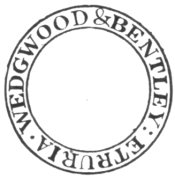
On all other wares the name WEDGWOOD is impressed, in some specimens in large capitals, in others in small capitals, WEDGWOOD.
Sometimes, though rarely, the name occurs in ordinary type, Wedgwood. On other pieces the name occurs thus:—
WEDGWOOD
ETRURIA.
During the period when Bentley was associated with Etruria the following were impressed:—
WEDGWOOD
& BENTLEY.
or
Wedgwood
& Bentley.
The general mark used during this period was a circular one, the letters on which were raised and not sunk as in the others.
The marks WEDGWOOD & CO., or simply the word WEDGEWOOD, are both spurious, and were used by Messrs. William Smith and others of Stockton, against whom the firm at Etruria obtained an injunction restraining the imitators from using the name “Wedgwood,” or “Wedgewood” with an additional e. This was in 1848.
Of the varying vicissitudes of the Wedgwoods since the days of the great Josiah, we have had no space to allude. But it is sufficient proof that he laid a very sure foundation to a fine business, inasmuch as the firm is in flourishing condition at the present day, and from 1870 have made splendid porcelain.
His Queen’s ware, which he made for the Queen Consort of George III., was the prototype of the ordinary dinner ware of to-day. We reproduce a{271} quaint old Wedgwood teapot with queer design upon it, representing the mill to grind old folks young.
It is a far cry from Queen Charlotte to President Roosevelt, but it is surely a singular record of a great firm that the Wedgwoods made the new service of china to be used on State occasions at the White House. The design has been copyrighted, thus ensuring its exclusive use. It is of simple gold pattern, bearing the great seal of the United States enamelled in colours upon it. The set consists of over a thousand pieces, and was ready early last year.
In the conclusion of the journey round the china shelf in this series of “Chats,” the writer trusts that they have stimulated the interest of the readers in their old china and have helped to solve certain dark riddles, and to give pedigree to “family jars.”
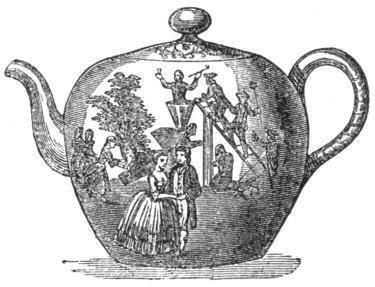
OLD WEDGWOOD TEAPOT.
The Mill to grind Old Folks young.
| Whieldon. | £ | s. | d. |
| Box and cover, formed as a melon. Sotheby, February 24, 1902 | 3 | 0 | 0 |
| Teapot and cover, hexagonal in shape, with Chinese figures in panels, the whole decorated in translucent colours. Sotheby, February 24, 1902 | 5 | 15 | 0 |
| Group, “Summer Arbour,” with two seated ladies, top surmounted by a bird, unusual colour. Edwards, Son & Bigwood, Birmingham, May 13, 1902 | 28 | 0 | 0 |
| Group, small, two figures, “The Lovers,” rare colours. Edwards, Son & Bigwood, Birmingham, May 13, 1902 | 11 | 10 | 0 |
| Diamond-shaped teapot and cover, painted with buildings, figures, and scale ornament in brilliant green and lake; and a pair of double sauce-boats, painted with figures and flowers in blue in the Chinese taste. Christie, January 12, 1903 | 17 | 17 | 0 |
| Wedgwood. | |||
| Bust, black basalt, nearly life size, David Garrick. Christie, February 4, 1902 | 37 | 16 | 0 |
| Cabaret, blue jasper, with reliefs of Nymphs and Cupids, consisting of teapot and cover, two basins, cup and saucer and oval plateau; and a black basalt copy of a lamp. Christie, February 4, 1902 | 6 | 6 | 0{273} |
| Chatelaines, three old English cut steel and seven ditto clasps, set with blue and white Wedgwood plaques, in oval frame. Christie, February 4, 1902 | 81 | 18 | 0 |
| Pendants and clasps, nine, cut steel, set with Wedgwood plaques, with Nymphs and Cupids; and one other piece. Christie, February 4, 1902 | 36 | 15 | 0 |
| Plaque, oblong, blue jasper, with figures sacrificing at an altar, festoons of flowers above, 41⁄2 in. by 101⁄2 in., in gilt frame. Christie, February 4, 1902 | 8 | 18 | 6 |
| Portrait medallions, eight, of Addison, Hon. W. Hastings, &c., in octagonal frame, and eight smaller plaques with classical subjects. Christie, February 4, 1902 | 71 | 8 | 0 |
| Teapot and cover, light blue jasper ground, with white relief subjects. Sotheby, February 24, 1902 | 4 | 4 | 0 |
| Vase, of classical design, the front ornamented with a group of Cupids dancing, in relief; Wedgwood & Bentley. Sotheby, February 24, 1902 | 15 | 10 | 0{274} |
| Vases and covers, pair, two-handled, light blue and white, with raised figures and other emblems, representing Music and Dancing, having mask-head handles, 18 in. high. Alexander, Daniel & Co., Bristol, May 7, 1902 | 13 | 0 | 0 |
| Vase, the Portland, or Barberini, a fine example, and one of the earliest, in a dark slate-blue body, the reliefs harmonising in tone with the field, on revolving stand, with metal tripod, mirror, &c. Christie, June 11, 1902 | 399 | 0 | 0 |
| Vase and pedestal, the vase of granulated ground, with reliefs of Flaxman’s Muses, leafage, &c., scroll handles, a figure of Pegasus on cover; the pedestal of square form, fluted, with reliefs of the Four Seasons; vase 15 in., pedestal 83⁄4 in. high. Christie, June 11, 1902 | 33 | 12 | 0 |
| Vase, on triangular base, supported by three Atlas figures, reliefs of arabesque scroll, festoons, &c., figure of Cupid on cover, 13 in. high. Christie, June 11, 1902 | 63 | 0 | 0 |
| Medallions, three, Venus and Adonis, and Cupid riding upon a swan; black ground, white relief; Wedgwood & Bentley. Christie, June 11, 1902 | 54 | 12 | 0{275} |
| Medallion, large oval tri-coloured: The Triumph of Achilles at Troy, green ground, border on black. Christie, June 11, 1902 | 24 | 3 | 0 |
| Portraits or Heads of Illustrious Moderns. Portraits, framed singly:—Hippocrates and Terence, Wedgwood & Bentley, metal frames; Frederick the Great, Wedgwood & Bentley; and Prince Charles Stuart, metal frames; Marie Antoinette, Prince Paul of Russia, and Mrs. Barbauld, one Wedgwood & Bentley, metal frames; Inigo Jones, black basalt, high relief, and Alexander, an early terra-cotta portrait, in colour; Joseph II., and Dr. Benjamin Franklin, in white biscuit; Sir Isaac Newton, Admiral Keppel, and a male portrait, looking left, in white jasper, &c., one Wedgwood & Bentley; General Eliott (Lord Heathfield), circular, white, and J. P. Elers, in a copper-lustred frame; Joseph Priestley, Unitarian Minister, a portrait, in glazed pottery, and Dr. Black, in blue and white. Christie, June 11, 1902[3] | 1,500 | 0 | 0{276} |
| Figures, pair, large black. Foster, December 23, 1902 | 19 | 8 | 6 |
| Teapot and cover, sage-green, and basin, with groups of classical figures, Nymphs, Cupids, and foliage in relief. Christie, December, 1902 | 16 | 5 | 6 |
| Vase and cover, oviform, blue jasper, decorated with rams’ heads in relief, and cameo figured panels, on plinth, 131⁄2 in. Foster, November 27, 1902 | 7 | 10 | 0 |
| Vase and cover, campana-shaped, blue jasper, with a frieze of Cupids sacrificing, masks, laurel-branches, and a wreath of vines under the lip; on octagonal-shaped pedestal, with figures of griffons at the corners, with classical frieze, 20 in. high. Christie, July 10, 1903 | 210 | 0 | 0 |
| Wedgwood lustre ware wall ornament, in shape of a nautilus shell and a lustre plate, both marked. Sotheby, May 17, 1920 | 10 | 10 | 0 |
| Black and white jasper copy of the Portland vase, numbered 60, 101⁄2 in. high, on bronze stand, with hoof feet, and marble pedestal with mirror top. Sotheby, May 17, 1920 | 21 | 0 | 0{277} |
| Black basalt bust of Newton, on circular pedestal, 12 in. high; another, of the same, 61⁄4 in. high; and a bust of Seneca, 101⁄4 in. high. Sotheby, May 17, 1920 | 5 | 5 | 0 |
| Blue and white jasper copy of the Portland vase, 103⁄4 in. high. Sotheby, May 17, 1920 | 3 | 3 | 0 |
| Dessert service, modelled as leaves, outlined with green, and with gilt borders, comprising an oval centre dish and stand, two sauce tureens, covers and stands, a sauce ladle, twelve dishes in four shapes, and twelve plates, impressed mark, 33 pieces. Puttick & Simpson, July 9, 1920 | 8 | 18 | 6 |
| Blue jasper oval jardinière, decorated with acanthus foliage and honeysuckle ornament, 10 in. wide; and a figure of Britannia, 91⁄2 in. high, on gilt-wood plinth. Christie, July 12, 1920 | 8 | 8 | 0 |
| Three blue jasper candlesticks, with figures of Nymphs holding cornucopia-shaped nozzles, 10 in. and 101⁄2 in. high. Christie, July 12, 1920 | 8 | 8 | 0 |
| Blue jasper oval plaque, by Wedgwood and Bentley, 111⁄4 in. by 8 in.; and three smaller ditto, with Bacchanalian and amatory trophies in relief. Christie, July 12, 1920 | 50 | 8 | 0{278} |
| Two blue jasper plaques, with Muses in relief, 5 in. by 7 in., in metal-gilt frames; a plaque, with Hebe, by Wedgwood and Bentley; and two others. Christie, July 12, 1920 | 12 | 12 | 0 |
| Oval blue jasper plaque, with the Infant Academy, in gilt frame; an oblong plaque, with the Marriage of Cupid and Psyche, 53⁄4 in. by 81⁄2 in.; and a circular plaque, with Cupid sharpening his arrow. Christie, July 12, 1920 | 19 | 19 | 0 |
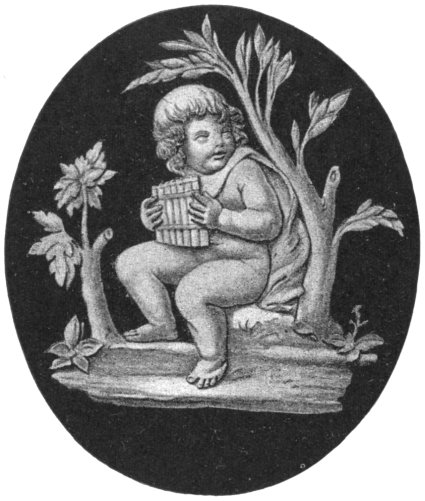
Designed by Lady Diana Beauclerk.
By kind permission of Mr. F. Rathbone.
WEDGWOOD PLAQUE. THE YOUNG PAN.
Printed in Great Britain by
UNWIN BROTHERS, LIMITED, THE GRESHAM PRESS, WOKING AND LONDON
FOOTNOTES:
[1] A Cookworthy Window was placed in the Guildhall, Plymouth, about 1840, during the mayoralty of Dr. Cookworthy, grandson of the potter.
[2] “Chats on English Earthenware,” the companion volume to this, deals in detail with the subject of earthenware as outlined here.
[3] This collection of portraits, by Josiah Wedgwood, is undoubtedly the most important one ever gathered together. Many are unique—all are of interest, as faithful facsimiles in a permanent material that cannot be affected by time or climate.
[Transcriber’s note: the following changes have been made to this text.
Frontispiece: Schrieber changed to Schreiber—Lady Charlotte Schreiber.
Page 45: Sotherby to Sotheby—Sotheby, May 17, 1920.
Plate facing page 76: Wattean to Watteau—Watteau style transfer.
Page 108: or to of—bouquets of flowers.
Page 143: comparision to comparison—comparison of the dates.
Page 281: Sevrès to Sèvres—Chelsea, Dresden, Sèvres marks.
Page 286: facfory to factory—establishes the Coalport factory, 139.]
End of the Project Gutenberg EBook of Chats on English China, by Arthur Hayden
*** END OF THIS PROJECT GUTENBERG EBOOK CHATS ON ENGLISH CHINA ***
***** This file should be named 57124-h.htm or 57124-h.zip *****
This and all associated files of various formats will be found in:
http://www.gutenberg.org/5/7/1/2/57124/
Produced by Susan Skinner and the Online Distributed
Proofreading Team at http://www.pgdp.net
Updated editions will replace the previous one--the old editions
will be renamed.
Creating the works from public domain print editions means that no
one owns a United States copyright in these works, so the Foundation
(and you!) can copy and distribute it in the United States without
permission and without paying copyright royalties. Special rules,
set forth in the General Terms of Use part of this license, apply to
copying and distributing Project Gutenberg-tm electronic works to
protect the PROJECT GUTENBERG-tm concept and trademark. Project
Gutenberg is a registered trademark, and may not be used if you
charge for the eBooks, unless you receive specific permission. If you
do not charge anything for copies of this eBook, complying with the
rules is very easy. You may use this eBook for nearly any purpose
such as creation of derivative works, reports, performances and
research. They may be modified and printed and given away--you may do
practically ANYTHING with public domain eBooks. Redistribution is
subject to the trademark license, especially commercial
redistribution.
*** START: FULL LICENSE ***
THE FULL PROJECT GUTENBERG LICENSE
PLEASE READ THIS BEFORE YOU DISTRIBUTE OR USE THIS WORK
To protect the Project Gutenberg-tm mission of promoting the free
distribution of electronic works, by using or distributing this work
(or any other work associated in any way with the phrase "Project
Gutenberg"), you agree to comply with all the terms of the Full Project
Gutenberg-tm License (available with this file or online at
http://gutenberg.org/license).
Section 1. General Terms of Use and Redistributing Project Gutenberg-tm
electronic works
1.A. By reading or using any part of this Project Gutenberg-tm
electronic work, you indicate that you have read, understand, agree to
and accept all the terms of this license and intellectual property
(trademark/copyright) agreement. If you do not agree to abide by all
the terms of this agreement, you must cease using and return or destroy
all copies of Project Gutenberg-tm electronic works in your possession.
If you paid a fee for obtaining a copy of or access to a Project
Gutenberg-tm electronic work and you do not agree to be bound by the
terms of this agreement, you may obtain a refund from the person or
entity to whom you paid the fee as set forth in paragraph 1.E.8.
1.B. "Project Gutenberg" is a registered trademark. It may only be
used on or associated in any way with an electronic work by people who
agree to be bound by the terms of this agreement. There are a few
things that you can do with most Project Gutenberg-tm electronic works
even without complying with the full terms of this agreement. See
paragraph 1.C below. There are a lot of things you can do with Project
Gutenberg-tm electronic works if you follow the terms of this agreement
and help preserve free future access to Project Gutenberg-tm electronic
works. See paragraph 1.E below.
1.C. The Project Gutenberg Literary Archive Foundation ("the Foundation"
or PGLAF), owns a compilation copyright in the collection of Project
Gutenberg-tm electronic works. Nearly all the individual works in the
collection are in the public domain in the United States. If an
individual work is in the public domain in the United States and you are
located in the United States, we do not claim a right to prevent you from
copying, distributing, performing, displaying or creating derivative
works based on the work as long as all references to Project Gutenberg
are removed. Of course, we hope that you will support the Project
Gutenberg-tm mission of promoting free access to electronic works by
freely sharing Project Gutenberg-tm works in compliance with the terms of
this agreement for keeping the Project Gutenberg-tm name associated with
the work. You can easily comply with the terms of this agreement by
keeping this work in the same format with its attached full Project
Gutenberg-tm License when you share it without charge with others.
1.D. The copyright laws of the place where you are located also govern
what you can do with this work. Copyright laws in most countries are in
a constant state of change. If you are outside the United States, check
the laws of your country in addition to the terms of this agreement
before downloading, copying, displaying, performing, distributing or
creating derivative works based on this work or any other Project
Gutenberg-tm work. The Foundation makes no representations concerning
the copyright status of any work in any country outside the United
States.
1.E. Unless you have removed all references to Project Gutenberg:
1.E.1. The following sentence, with active links to, or other immediate
access to, the full Project Gutenberg-tm License must appear prominently
whenever any copy of a Project Gutenberg-tm work (any work on which the
phrase "Project Gutenberg" appears, or with which the phrase "Project
Gutenberg" is associated) is accessed, displayed, performed, viewed,
copied or distributed:
This eBook is for the use of anyone anywhere at no cost and with
almost no restrictions whatsoever. You may copy it, give it away or
re-use it under the terms of the Project Gutenberg License included
with this eBook or online at www.gutenberg.org/license
1.E.2. If an individual Project Gutenberg-tm electronic work is derived
from the public domain (does not contain a notice indicating that it is
posted with permission of the copyright holder), the work can be copied
and distributed to anyone in the United States without paying any fees
or charges. If you are redistributing or providing access to a work
with the phrase "Project Gutenberg" associated with or appearing on the
work, you must comply either with the requirements of paragraphs 1.E.1
through 1.E.7 or obtain permission for the use of the work and the
Project Gutenberg-tm trademark as set forth in paragraphs 1.E.8 or
1.E.9.
1.E.3. If an individual Project Gutenberg-tm electronic work is posted
with the permission of the copyright holder, your use and distribution
must comply with both paragraphs 1.E.1 through 1.E.7 and any additional
terms imposed by the copyright holder. Additional terms will be linked
to the Project Gutenberg-tm License for all works posted with the
permission of the copyright holder found at the beginning of this work.
1.E.4. Do not unlink or detach or remove the full Project Gutenberg-tm
License terms from this work, or any files containing a part of this
work or any other work associated with Project Gutenberg-tm.
1.E.5. Do not copy, display, perform, distribute or redistribute this
electronic work, or any part of this electronic work, without
prominently displaying the sentence set forth in paragraph 1.E.1 with
active links or immediate access to the full terms of the Project
Gutenberg-tm License.
1.E.6. You may convert to and distribute this work in any binary,
compressed, marked up, nonproprietary or proprietary form, including any
word processing or hypertext form. However, if you provide access to or
distribute copies of a Project Gutenberg-tm work in a format other than
"Plain Vanilla ASCII" or other format used in the official version
posted on the official Project Gutenberg-tm web site (www.gutenberg.org),
you must, at no additional cost, fee or expense to the user, provide a
copy, a means of exporting a copy, or a means of obtaining a copy upon
request, of the work in its original "Plain Vanilla ASCII" or other
form. Any alternate format must include the full Project Gutenberg-tm
License as specified in paragraph 1.E.1.
1.E.7. Do not charge a fee for access to, viewing, displaying,
performing, copying or distributing any Project Gutenberg-tm works
unless you comply with paragraph 1.E.8 or 1.E.9.
1.E.8. You may charge a reasonable fee for copies of or providing
access to or distributing Project Gutenberg-tm electronic works provided
that
- You pay a royalty fee of 20% of the gross profits you derive from
the use of Project Gutenberg-tm works calculated using the method
you already use to calculate your applicable taxes. The fee is
owed to the owner of the Project Gutenberg-tm trademark, but he
has agreed to donate royalties under this paragraph to the
Project Gutenberg Literary Archive Foundation. Royalty payments
must be paid within 60 days following each date on which you
prepare (or are legally required to prepare) your periodic tax
returns. Royalty payments should be clearly marked as such and
sent to the Project Gutenberg Literary Archive Foundation at the
address specified in Section 4, "Information about donations to
the Project Gutenberg Literary Archive Foundation."
- You provide a full refund of any money paid by a user who notifies
you in writing (or by e-mail) within 30 days of receipt that s/he
does not agree to the terms of the full Project Gutenberg-tm
License. You must require such a user to return or
destroy all copies of the works possessed in a physical medium
and discontinue all use of and all access to other copies of
Project Gutenberg-tm works.
- You provide, in accordance with paragraph 1.F.3, a full refund of any
money paid for a work or a replacement copy, if a defect in the
electronic work is discovered and reported to you within 90 days
of receipt of the work.
- You comply with all other terms of this agreement for free
distribution of Project Gutenberg-tm works.
1.E.9. If you wish to charge a fee or distribute a Project Gutenberg-tm
electronic work or group of works on different terms than are set
forth in this agreement, you must obtain permission in writing from
both the Project Gutenberg Literary Archive Foundation and Michael
Hart, the owner of the Project Gutenberg-tm trademark. Contact the
Foundation as set forth in Section 3 below.
1.F.
1.F.1. Project Gutenberg volunteers and employees expend considerable
effort to identify, do copyright research on, transcribe and proofread
public domain works in creating the Project Gutenberg-tm
collection. Despite these efforts, Project Gutenberg-tm electronic
works, and the medium on which they may be stored, may contain
"Defects," such as, but not limited to, incomplete, inaccurate or
corrupt data, transcription errors, a copyright or other intellectual
property infringement, a defective or damaged disk or other medium, a
computer virus, or computer codes that damage or cannot be read by
your equipment.
1.F.2. LIMITED WARRANTY, DISCLAIMER OF DAMAGES - Except for the "Right
of Replacement or Refund" described in paragraph 1.F.3, the Project
Gutenberg Literary Archive Foundation, the owner of the Project
Gutenberg-tm trademark, and any other party distributing a Project
Gutenberg-tm electronic work under this agreement, disclaim all
liability to you for damages, costs and expenses, including legal
fees. YOU AGREE THAT YOU HAVE NO REMEDIES FOR NEGLIGENCE, STRICT
LIABILITY, BREACH OF WARRANTY OR BREACH OF CONTRACT EXCEPT THOSE
PROVIDED IN PARAGRAPH 1.F.3. YOU AGREE THAT THE FOUNDATION, THE
TRADEMARK OWNER, AND ANY DISTRIBUTOR UNDER THIS AGREEMENT WILL NOT BE
LIABLE TO YOU FOR ACTUAL, DIRECT, INDIRECT, CONSEQUENTIAL, PUNITIVE OR
INCIDENTAL DAMAGES EVEN IF YOU GIVE NOTICE OF THE POSSIBILITY OF SUCH
DAMAGE.
1.F.3. LIMITED RIGHT OF REPLACEMENT OR REFUND - If you discover a
defect in this electronic work within 90 days of receiving it, you can
receive a refund of the money (if any) you paid for it by sending a
written explanation to the person you received the work from. If you
received the work on a physical medium, you must return the medium with
your written explanation. The person or entity that provided you with
the defective work may elect to provide a replacement copy in lieu of a
refund. If you received the work electronically, the person or entity
providing it to you may choose to give you a second opportunity to
receive the work electronically in lieu of a refund. If the second copy
is also defective, you may demand a refund in writing without further
opportunities to fix the problem.
1.F.4. Except for the limited right of replacement or refund set forth
in paragraph 1.F.3, this work is provided to you 'AS-IS' WITH NO OTHER
WARRANTIES OF ANY KIND, EXPRESS OR IMPLIED, INCLUDING BUT NOT LIMITED TO
WARRANTIES OF MERCHANTABILITY OR FITNESS FOR ANY PURPOSE.
1.F.5. Some states do not allow disclaimers of certain implied
warranties or the exclusion or limitation of certain types of damages.
If any disclaimer or limitation set forth in this agreement violates the
law of the state applicable to this agreement, the agreement shall be
interpreted to make the maximum disclaimer or limitation permitted by
the applicable state law. The invalidity or unenforceability of any
provision of this agreement shall not void the remaining provisions.
1.F.6. INDEMNITY - You agree to indemnify and hold the Foundation, the
trademark owner, any agent or employee of the Foundation, anyone
providing copies of Project Gutenberg-tm electronic works in accordance
with this agreement, and any volunteers associated with the production,
promotion and distribution of Project Gutenberg-tm electronic works,
harmless from all liability, costs and expenses, including legal fees,
that arise directly or indirectly from any of the following which you do
or cause to occur: (a) distribution of this or any Project Gutenberg-tm
work, (b) alteration, modification, or additions or deletions to any
Project Gutenberg-tm work, and (c) any Defect you cause.
Section 2. Information about the Mission of Project Gutenberg-tm
Project Gutenberg-tm is synonymous with the free distribution of
electronic works in formats readable by the widest variety of computers
including obsolete, old, middle-aged and new computers. It exists
because of the efforts of hundreds of volunteers and donations from
people in all walks of life.
Volunteers and financial support to provide volunteers with the
assistance they need, are critical to reaching Project Gutenberg-tm's
goals and ensuring that the Project Gutenberg-tm collection will
remain freely available for generations to come. In 2001, the Project
Gutenberg Literary Archive Foundation was created to provide a secure
and permanent future for Project Gutenberg-tm and future generations.
To learn more about the Project Gutenberg Literary Archive Foundation
and how your efforts and donations can help, see Sections 3 and 4
and the Foundation web page at http://www.pglaf.org.
Section 3. Information about the Project Gutenberg Literary Archive
Foundation
The Project Gutenberg Literary Archive Foundation is a non profit
501(c)(3) educational corporation organized under the laws of the
state of Mississippi and granted tax exempt status by the Internal
Revenue Service. The Foundation's EIN or federal tax identification
number is 64-6221541. Its 501(c)(3) letter is posted at
http://pglaf.org/fundraising. Contributions to the Project Gutenberg
Literary Archive Foundation are tax deductible to the full extent
permitted by U.S. federal laws and your state's laws.
The Foundation's principal office is located at 4557 Melan Dr. S.
Fairbanks, AK, 99712., but its volunteers and employees are scattered
throughout numerous locations. Its business office is located at
809 North 1500 West, Salt Lake City, UT 84116, (801) 596-1887, email
business@pglaf.org. Email contact links and up to date contact
information can be found at the Foundation's web site and official
page at http://pglaf.org
For additional contact information:
Dr. Gregory B. Newby
Chief Executive and Director
gbnewby@pglaf.org
Section 4. Information about Donations to the Project Gutenberg
Literary Archive Foundation
Project Gutenberg-tm depends upon and cannot survive without wide
spread public support and donations to carry out its mission of
increasing the number of public domain and licensed works that can be
freely distributed in machine readable form accessible by the widest
array of equipment including outdated equipment. Many small donations
($1 to $5,000) are particularly important to maintaining tax exempt
status with the IRS.
The Foundation is committed to complying with the laws regulating
charities and charitable donations in all 50 states of the United
States. Compliance requirements are not uniform and it takes a
considerable effort, much paperwork and many fees to meet and keep up
with these requirements. We do not solicit donations in locations
where we have not received written confirmation of compliance. To
SEND DONATIONS or determine the status of compliance for any
particular state visit http://pglaf.org
While we cannot and do not solicit contributions from states where we
have not met the solicitation requirements, we know of no prohibition
against accepting unsolicited donations from donors in such states who
approach us with offers to donate.
International donations are gratefully accepted, but we cannot make
any statements concerning tax treatment of donations received from
outside the United States. U.S. laws alone swamp our small staff.
Please check the Project Gutenberg Web pages for current donation
methods and addresses. Donations are accepted in a number of other
ways including checks, online payments and credit card donations.
To donate, please visit: http://pglaf.org/donate
Section 5. General Information About Project Gutenberg-tm electronic
works.
Professor Michael S. Hart is the originator of the Project Gutenberg-tm
concept of a library of electronic works that could be freely shared
with anyone. For thirty years, he produced and distributed Project
Gutenberg-tm eBooks with only a loose network of volunteer support.
Project Gutenberg-tm eBooks are often created from several printed
editions, all of which are confirmed as Public Domain in the U.S.
unless a copyright notice is included. Thus, we do not necessarily
keep eBooks in compliance with any particular paper edition.
Most people start at our Web site which has the main PG search facility:
http://www.gutenberg.org
This Web site includes information about Project Gutenberg-tm,
including how to make donations to the Project Gutenberg Literary
Archive Foundation, how to help produce our new eBooks, and how to
subscribe to our email newsletter to hear about new eBooks.